#or whether they should be different in the early comic and then risk half the fanart being for the 'old' design
Explore tagged Tumblr posts
Photo

An early-Substrate Ruma that I ultimately decided against using on a ref sheet, but still liked.
#substrate#Ruma#my art#basically the same as present-day Ruma without the cyborg eyes and face scars#I have the continual dilemma of whether my characters should look roughly the same throughout the comic#or whether they should be different in the early comic and then risk half the fanart being for the 'old' design
3 notes
·
View notes
Text
You have something to tell me?
Fandom: DC comics, Batman
Pairing: Jason Todd x Timothy Drake (JayTim)
Rating/Tags: JayTim Week 2020 - Day 5: Detective Tim, Secret Identity, Identity Reveal, Established Relationship, Love Confessions, Misunderstandings
Other(s) links: AO3
During the first weeks Jason spent at Wayne Manor, right after he had been picked up directly from Crime Alley, he learned something important: It was difficult to hide things from a good detective. Maybe he should have had that in mind during his adult life as well, especially when he was dating one of the best GCPD detectives.
"Tim? What happened?"
"Don't know. Tell me." He answered, angry. "You have something to tell me, Jason?"
You have something to tell me?
During the first weeks Jason spent at Wayne Manor, right after he had been picked up directly from Crime Alley, he learned something important: It was difficult to hide things from a good detective.
By a good detective, he meant Alfred, of course. Because at those times Bruce was a mess and was too busy panicking to have adopted another child. Really, the millionaire couldn't pay attention to when he was sneaking, smoking, stealing food, and hiding provisions along with money in case he had to flee at any time.
Anyway, he knew the man was trying to find a way to do things correctly with him, since he was a child of the street, with a difficult life, and totally different from the ray of the sun that turned out to be his first pupil, Dick.
Of course, he didn't know that at the time. All he was aware of was that he now lived in a mansion and the butler there knew everything. Everything. No matter what he did, how he hid, or how he lied, Alfred always knew it, he always ended up finding out sooner or later. The first few times he was even scared.
For this reason, he ended up learning that lesson. You couldn’t fool a good detective, because in the end they always ended up finding out whether by chance or not.
He should have had that in mind during his adult life as well, especially when he did what he did. Because it would have saved him from some trouble, and he would have gotten away with it.
That day he came home early, in a very good mood and wearing a slight smile. It was noon, and he had finished some duties, the patrol that night had been quiet, everything was going well, and his boyfriend had the day off.
His boyfriend. His Timmy, his little detective.
Against everything -and after several talks from absolutely his entire family- his relationship with Tim was going very well, better than anyone could have never thought. And contrary to what some people wanted to believe, Jason didn’t meet Tim as a GCPD detective, no, he was the pretty boy who lived in the neighborhood that greeted him with a cute smile, and stopped at the 24-hour coffee shop too often to be healthy. His surprise was even alarming when one night he showed up with Batman for a joint case on the police station rooftop and Jim Gordon was there with the force’s new promise: Detective Tim Drake.
As expected, just as that smile and pretty face dazzled Jason the first time he saw him in the cafe, so did his intelligence and professionalism in helping them with the case. So, days later, when Tim approached him shyly and asked him to have coffee together, how could he say no?
He was crushing on him back then. And now, two years later, he still was.
“Timmy.” He called him fondly as he entered the apartment they shared. “I'm back.”
Walking down the hall, Jason looked around the kitchen and then headed to the living room. He didn't know if Tim was still asleep, but he wouldn't blame him if he did, his little bird worked too hard and sometimes didn't rest properly. Although it isn’t as if he was the most appropriate example of this considering his night activities, or night work, according to the version Tim knew.
Even he didn't know how he had managed to hide his life as a vigilante from his partner for so long, but he couldn't continue doing it. As much as he feared for his safety or his reaction, it was a part of his life that he could no longer hide, and the more time passed, the worse the consequences.
Just when he found Tim in the living room, he began to fear that these consequences had come sooner than expected.
“Babybird.” He called him again.
No answer.
Tim was sitting at the end of the sofa, his feet up on it and curled up on himself, his arms were crossed, he was watching at the television turned off completely silent and thoughtful. His hands clenched into fists didn’t loosen, his nose was red and his eyes were watery, he seemed angry, sad, upset.
Jason's chest sank in concern, immediately closed in on the boy. Tim didn’t usually respond in a particularly emotional way to many things, he generally liked to compartmentalize unless it affected him a lot, the times when he had seen him crying had been at times like the anniversary of his parent’s death, for example.
“Tim?” He asked somewhat alarmed.
However, when he reached out to comfort him and lifted his hand to touch him, perhaps caress his hair in the way he knew it would relax him, he pulled away immediately, startled, surely he had been too deep in his own head to realize he had arrived.
A bad feeling began to invade him when he frowned and moved further away from his touch, clenching his fists. He knew that face, that sparkle in his eyes, he was angry, specifically with him. But at the same time his eyes were still watery and shone with disappointment, anguish.
“What happened?” He asked again nervously.
Tim frowned further and shrugged.
“Don’t know. Tell me.”
That reply was a confirmation that he was angry with him. Why? Well, based on the answer and the tone in which it was said, he might have discovered something that he didn't like at all, that would have hurt him, and Jason didn't have to think much to know what it was.
“What?” He asked uselessly.
Tim’s lower lip trembled for a second, but he controlled that to stop clinging to himself and getting his feet off the couch.
“You have something to tell me, Jason?”
Jason's alarms went off even, much louder. It was clear what was going on, Tim had figured it all out on his own.
He knew it, he knew it. God how had he been so stupid? He was dating one of the best GCPD detectives, one of the younger to join the force, with an outstanding record and the smartest person he knew. Fuck, even Batman praised the boy's ability, they had worked together on cases, that intelligence and audacity were scary, and that was what he most liked about him. Timothy was like a hound, stubborn and determined, he never gave up until he found the truth, and that was something he highly valued. If he felt that his boyfriend wasn’t being completely honest with him, of course he was going to investigate, of course he wanted to know. And having worked with the bats, being so close to him and having the necessary means, it was no wonder that he could have easily tied the dots.
He couldn't lie to him, not anymore. He also didn’t like to do it before, the only reason he did it was because he knew it was for the best. Tim had thrown a light into his life that he never thought he could -or deserved to- have, a feeling of normality and affection that helped him improve and not be a fucking unconscious fucker. But he knew that part of his life was dangerous, dark and crazy. The proof was in his scars and nightmares, in his traumas and fears, those that Tim helped calm and never asked about. The fact that he didn’t know, kept him away from the danger that he was so afraid of could reach him, but he also worked with bats, was in the first ranks of the GCPD, and that made him join the risk.
He had no choice, besides, how could he continue to lie to him when he was there, half crying, begging him the truth and piercing his soul with those big blue eyes? Seriously, he wasn't surprised that the suspects sang so quickly with him, the boy was all eyes and pretty face.
Jason sighed and sat down on the couch next to him, his heart beating hard and guilt devouring him. He never thought he would have to reveal his secret to someone out loud, not to a civilian, but he also never imagined caring about someone enough to do so. He looked Tim in the eye and took a deep breath:
“Okay, it sounds like you already know, but you deserve to be told.” He said with a nod.
Tim sniffed, looking nervously into his eyes, hurt, but let him continue. Jason swallowed and knew there was no other way out.
“I’m Red Hood.”
Silence.
Tim didn’t move, didn’t react, and Jay exhaled altered. It wasn't enough, was it? It wasn’t.
“I'm sorry I didn't tell you before.” He continued. “But I couldn't, seriously. It was too dangerous.”
He looked for any trace of a single reaction on his face but didn’t find it. He just stood there, looking at him silently and thoughtfully. Which made him even more nervous.
“I know you’re in the GCPD and we’ve worked together, but I didn't want to get you much more involved.”
Still silent.
“I pissed people off very dangerous, horrible villains, it’s a world you don't want to get into.”
“…”
“You have to believe me. If it were up to me, I would have told you a long time ago, but the more time passed the worse the secret became.”
“…”
“I constantly face undesirable people and you would be a very easy target.”
“Jason.”
By the time Tim whispered his name, the dam had broken, and he couldn't stop babbling, thinking aloud about everything that he had been holding back.
“I know it sounds selfish, but it’s not just up to me and there’s a reason we keep civilians out of that life. Fuck, if you knew...”
“Jason.”
“It's a fucking hell and it killed me; I couldn't risk you.”
“Jason.”
“I know I've broken your trust but...”
“Jason!” Tim interrupted, weary and leaning down to meet his eyes fiercely. “I knew it.”
It took him three seconds to assimilate that, causing him to freeze and the confusion nullify him.
What the fuck?
“Eh?” He asked confused.
“I knew it.” The smallest repeated, huffing and crossing his arms. “I’ve always known that.”
What the actual fuck?
Tim had to see the chaos and mess that was his head at the time on his face, because he huffed harder and shook his head, totally exasperated.
“Jason, I'm not stupid.” He emphasized with a frown and raised his hands to point to the apartment. “This place is reinforced everywhere with bat technology.”
He didn’t know what to say, because that was a good point.
“You hide a gun in the cereal cupboard and...” Sighing and reaching into one of the holes in the sofa, he pulled out one of the rubber bullets that Red Hood used and had been there for who knows how long. “This! There are rubber bullets everywhere. Bullets I've seen you use.”
Okay, so he might like to hide guns in certain parts of the place for extra security. And maybe he was a little sloppy with his bullets sometimes.
“You have the same boots, pants and jacket in your closet. I even found your helmet once!”
The excuse it was from a Halloween costume may not have been as convincing as he believed.
“You speak the same way, you move the same way, you have the same height and constitution.” Tim continued listing. “Even the first night you saw me as Red Hood, you flirted with me.”
He did?
Maybe yes.
“I knew it from the beginning and still accepted it. I knew the reason you were hiding it and I respected your decision to not tell me until you saw necessary.” Again, Tim began to look distraught, his eyes watering again. “But that's not what I was talking about.”
Confusion arose again for something quite different. Because if Tim, his intelligent and precious detective, had known and accepted his other life from the beginning, what was going on? Why was he angry?
“Then what were you talking about?” He asked fearfully, again the bad feeling settling in his being.
Tim hesitated, shifted in his seat, and his lower lip trembled again, looking much more distressed than before, about to burst into tears.
“I'm talking about you spending Saturday night at a 5-star hotel. Enjoying the restaurant and the suite for couples with another person.” He said and barely tried to control his voice. “The bank has reported recent suspicious movements on your card, when I asked half an hour ago it took me to the hotel, which asked for your assessment of your stay there and confirmation of another reservation this week.”
Tim’s voice broke at the end and Jason started to panic much more than before.
Shit, shit, fuck, shit.
“Tim this isn't-”
“What it looks like?” He cut him off, trying to compose himself. “So, what is it?”
Jason rubbed his eyes nervously. It really wasn't what it seemed, dammit. He knew what Tim was thinking, what anyone would think, and he understood his reaction. But he would never cheat on Tim, not like that, not feeling what he feels for him, not wanting to...
“I know what you think but-”
“But what? What should I think?” He asked again, his hands shaking.
It was clear that he had cried, and he was trying not to do it again at this moment, the way he was getting more upset indicated that, he wanted to stay strong. And Jason didn’t know what to do, because he couldn’t deny anything and couldn’t explain it the way he wanted without making it seem even more suspicious, he knew that Tim’s self-esteem problems didn’t help the situation at all, he was among the sword and wall.
“I went there, but not for what you think.” He began to explain, also nervous.
Tim ended up getting off the couch, shaking his head vigorously and pacing in front of the living room table, like a caged lion.
“With whom?” He asked then, almost in pain. “Nightwing?”
“Wh-”
“Arsenal?”
“No!”
“Starfire?”
There he said nothing. About his brother and his best friend, he could deny it, but not with Kory. He went to the hotel and the restaurant with her, it was true, but not as more than friends. What’s more, he didn't even spend the night there, leaving the Tamaranian woman alone in the suite with one of Bruce’s credit cards to do whatever she wanted while he left on patrol and then returned home.
But Tim didn't know that, all he had was that brief silence on his part that told him he was correct, and that immediately broke him when he understood.
Turning around, Tim rushed down the hall to their room, letting out a sob and not stopping to look back. Jason followed him without hesitation, frantic, guilt hitting him more and more along with the fear of losing him.
“Tim!” He called him. “Listen to me, please!”
They entered the room, Tim going straight to the closet and searching through his clothes. He knew what he was doing, he wanted to get his things and leave as soon as possible, he didn't want to be there to break even more, but Jason couldn't allow it.
“We didn't spend the night together!” He explained grabbing the closet door and trying to get him away from there. “It’s not what you think.”
Tim shook his head and rubbed his eyes, his breathing uneven, with no choice but to let him close the closet as he sobbed.
“No, Jason, I get it.” He started to say. “It’s heroes’ stuff, I get it…”
“What?” He asked confused. What was he talking about? Heroes stuff?
“S-She’s a hero. Fuck, is Starfire, and I'm just a civilian...” He continued saying as he looked at the ground, almost looking resigned. “She can understand things that I don't, understand you on a level that I can't, and you don't have to lie to her or pretend to be anything else with her.”
Jason opened his mouth and then closed it, stunned. He couldn't believe what he was hearing, it was surreal.
It was true, most of the heroes ended up dating others in the community, but it didn’t always have to be like that. Secret identities, lies, and danger often ruin relationships with civilians, but other times, if you wanted to, they could work. Damn, the fucking Superman had a family with Lois Lane, also Flash, many others, he was not exactly lacking examples.
And Tim thinking for a single second that he couldn’t make him happy for not understanding that part of his life, compared to other people, not only hurt him, it made him angry. If he knew how much he had helped him, how much his life had changed, how happy he made him…
“So, it’s okay. Don't worry, I really understand.” Tim continued, even in that resigned and sad tone. “I'm sorry I wasted your time...”
That was the drop that filled the glass.
Tim saying something like that, crying in front of him and saying that he understood it despite how much it hurt him, broke him inside. And that he really believed as a result of all this that he hadn’t been able to make him happy, that those two years together had been a lost time and not the best in Jason’s life, made him make the decision to send everything to hell and act. Fuck everything.
As Tim tried to hold back his tears and dry the ones that ran down his face, he silently approached his nightstand to pull out what he had been hiding for months, then turned back to him, determined.
“Tim, listen to me.” He started to say as he approached him again. The younger didn’t dare look at him. “I invited Kory to those places because I needed to know her opinion about them. She’s one of my best friends and the person with the best criteria I know about that kind of things, but we couldn't access there without a reservation, so I had to take her.”
Tim sniffed again and the tension in his shoulders eased a little, he seemed to be listening intently, almost hopefully.
“I didn’t spend the night there; I was on patrol. You can check it, I faced Mr. Freeze in the town hall square, there are videos and reports about it. And if that’s not enough and you don’t believe me now, you can ask Starfire personally later.” He explained getting closer, surrounding the bed, and placing himself in front of him. “The thing is, I did all that behind your back because I really needed her advice and help.”
Tim rubbed his eyes, still without looking at him.
“For what?” He asked in that weak, broken voice.
“Look at me.”
What Tim saw when he finally dared to look up, was Jason kneeling in front of him and showing him an engagement ring.
“Timothy Jackson Drake, do you want to marry me?”
Time seemed to stop completely; Tim's eyes couldn’t open more because of the impression. Jason swallowed hard and buried his nervousness to continue speaking.
“I’ve been wanting to ask you for months, but I really didn’t know how. I don't care if you are a civilian or not, I love you and I wanted it to be a surprise, something special.” He sighed somewhat agitated, the uncertainty at his answer was too much. “I no longer have to reveal why, but in my life I have learned that I must cling and keep by my side everything that makes me happy for as long as I can, and my happiness is you. So, what do you say?”
Tim was still frozen, stunned because all the information he had to assimilate. Not only because Jason had not cheated on him as he thought, but he had been planning how to propose to him. He was thinking he didn’t want to be with him and then he just discovered that he wanted to spend their lives together, it was too sudden.
But despite having to go from one extreme to the other so quickly, Tim seemed to assimilate at last when those tears turned into ones of happiness and a smile began to grow on his face.
“Yes.” He replied with a sigh of relief. “Yes, I do.”
Jason couldn't help but smile too, happiness flooding him completely, his answer echoing in his head and brightening every part of his being. It didn't take him long to get up to catch him and hold him tight, both of them letting out a relieved laughter. Words weren’t enough.
The tallest wiped the tears of his now fiancé, with affection and devotion.
“I should have thought how difficult is to hide something from a detective.” He said placing a lock of his hair behind his ear. “And this time you didn't even have to do much to discover me.”
Tim smiled and shrugged, his eyes shining with love and relief. Almost seemed that he was going to cry again when he grabbed his hand and put the ring on him carefully. Jason's heart squeezed at the sight because it fit him perfectly, and it was his, all his, forever.
When Tim leaned down to kiss him, he didn't even hesitate. He was more than willing to love his detective for the rest of his days, and he would make sure to tell him in every moment.
#myfic#jaytimweek#jaytimweek2020#dc comics#dc#batman#batman comics#tim drake#jason todd#red robin#red hood#jaytim#timjay#detective au
87 notes
·
View notes
Text
Ranking Every Studio Ghibli Movie
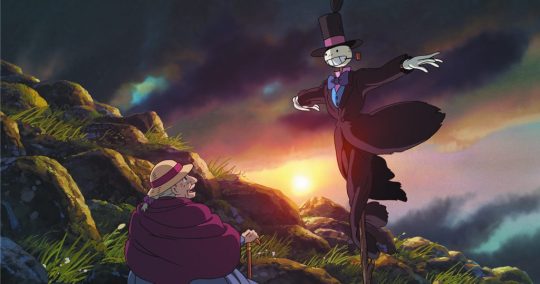
Studio Ghibli's contribution to anime (and animation in general) cannot be understated. Founded by directors Hayao Miyazaki and Isao Takahata, and producer Toshio Suzuki, the studio has produced many of Japan's most hallowed films, movies that are both critically acclaimed and monsters at the box office. In 1996, Disney partnered with Studio Ghibli to bring their movies to North America, developing a new audience that has since come to age; now, Ghibli is as much a part of American childhood as Pixar and Dreamworks releases.
On Anime Pop Heart and @beneaththetangles, we are commemorating the studio with Ghibli Month all September long! I’m kicking things off by ranking Ghibli's twenty-one releases, plus Nausicaa of the Valley of the Wind, which is often honorarily included among the studio's slate, ranked from first to worst (including alternate viewpoints on a couple of the selections).
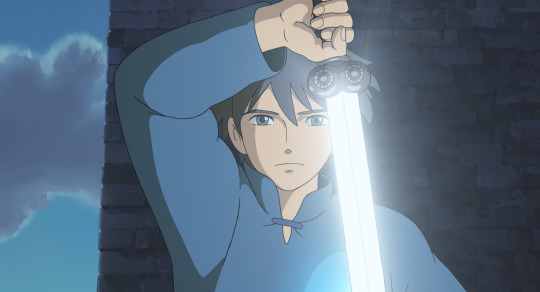
22. Tales from Earthsea
Miyazaki famously quarreled with his son, Goro, over the latter's ability to direct Tales from Earthsea, and indeeed, the final product feels like the result of a young man who was in over his head. The movie deserves its ignominious reputation, as it is inconsistent, poorly staged, and often terrible. It's a shame, too, for there are some strong elements to the film and enormous potential, with the outlines of an epic tale and compelling characters in Sparrowhawk and Cob (who are wonderfully dubbed by Timothy Dalton and Willem Dafoe, respectively)—it just never comes quite together and totally unravels at the end, resulting in the only bad film in Studio Ghibli's outstanding run.

21. The Cat Returns
Most Studio Ghibli films are family features, made for children. However, they still capture the imagination of youth and adults as well. The Cat Returns, the only "sequel" in Ghibli's film catalog, doesn't do the same however. It is purely for kids, and aside from flourishes here and there that speak of fantasy adventures and feature whimsical characters, fails to engage viewers of a certain age—maybe anyone older than about twelve. A neat companion piece to Whisper of the Heart, it's worth watching, showing to your children, and then giving away to parents who need better-than-average entertainment to busy their children.
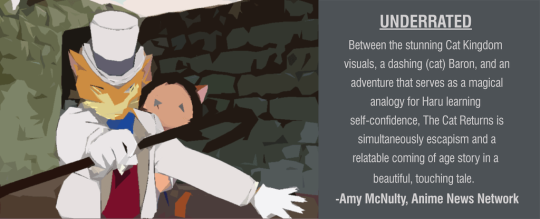
20. Ocean Waves
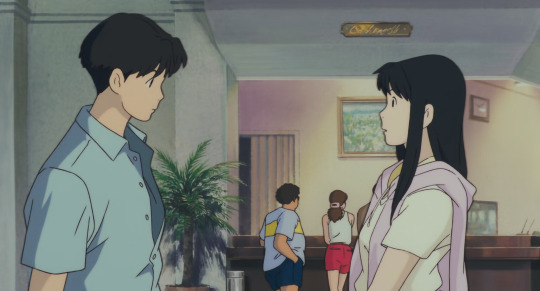
At one time, Ocean Waves was considered a black eye in Ghibli's filmography, an overpriced television movie that wasn't all that good. In retrospect, the intial judgments were only partially right. Ocean Waves is very much a TV movie, melodramatic and small in scale. The animation, too, is sometimes shoddy, but more often than not it's far better than it has the right to be. Ocean Waves is lovingly made, and the characters are almost frustratingly sincere—and oh so early 90s. While on the lowest tier of the Ghibli scale, Ocean Waves is far better than a simple curiosity.

19. Arrietty
Like Poppy Hill before it, there's nothing terrifically wrong with Arrietty—it just lacks the magic of the great Studio Ghibli films, making it rather forgettable. It's also sometimes dull. While beautiful colors, a foreshadowing of the spectacular animation to come of Yonebayashi in Mary and the Witch's Flower, shine through in the film, and some of the action sequences are highly engaging, our hearts are never fully in it. Maybe that's because we lack a loving connection to many of the characters, particularly to the pensive Sho. A nice watch, but one that's lacking.
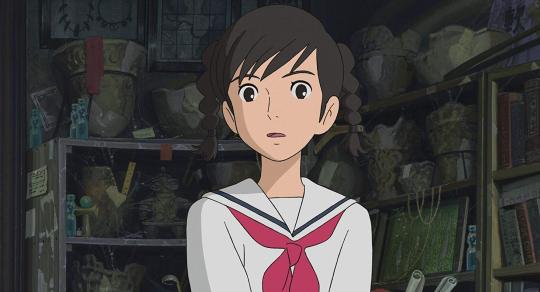
18. From Up on Poppy Hill
Much maligned for our lowest ranked movie, Goro Miyazaki returned from that entry with a stronger film, one that functions as an ode to historic preservation while presenting one of the studio's most lovely relationships—that is, until it gets a bit tricky, unfortunately begining to enter a zone unusual for Studio Ghibli, if standard fare for other anime. But that's a relatively minor issue in what's a perfectly lovely film that does well in evoking nostalgia in a movie that reminisces about the past and a Yokohama that no longer exists. Not every emotional moment hits as it should, but enough do to make the film Ghibli's best "date night" entry.

17. Pom Poko
Often criticized for being too over-bearing in its ecological message, Pom Poko's main issue instead is that it's meant to a collection of stories that to flow into one another, based on one group of tanukis' fight against urban development, but the movie doesn't feel cohesive, partly because there is no central protagonist. We only get to know each main tanuki so much, and none feel central to the tale—any could step in and play the necessary roles. Still, Pom Poko is unreservedly charming and often hilarious. It's also a peek into Japanese culture that we often don't get, a look at a country transforming in landscape and in values.
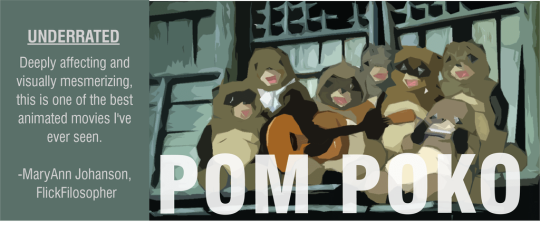
16. Ponyo
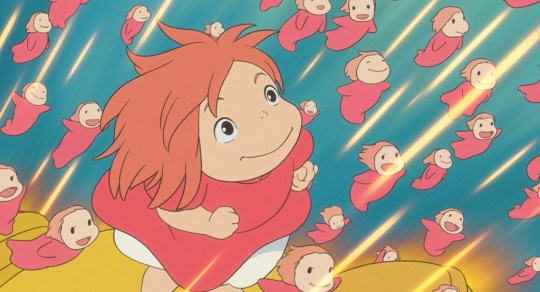
Why is Ponyo the low point of Miyazaki's output, the only film of his that doesn't attain the level of classic? It is wonderfully animated, bursting with energy and featuring a story that is never disingenuous and a heroine that is funny, cute, and breathtaking even. However, the film proved that Miyazaki was on a downward trajectory after Spirited Away. Repetition seen in Howl's Moving Castle was on full display in Ponyo, a new movie that too often feels like a rehash, featuring characters that other than the title heroine, fail to connect, and a story that is muddled and often just strange. Ponyo is a fun film and a better one after repeated viewings—the problem is that such defenses do not have to be made for any of Miyazaki's other works.
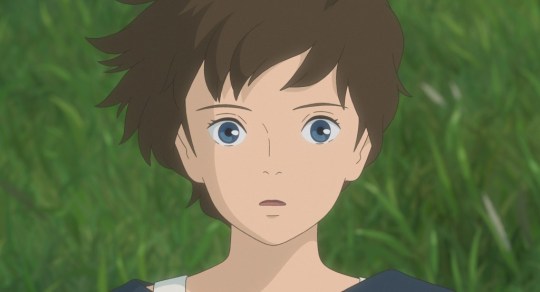
15. When Marnie Was There
The last feature film from Studio Ghibli to date is both quietly personal and a surprising risk. When Marnie Was There is the studio's first true mystery tale, and has a tone that's slightly haunting. The lead characters, also, are unusual for Ghibli—neither Anna nor Marnie are as embraceable as most of the heroines from Ghibli's past, but that seems be purposeful. What they demonstrate to us is not as much of "who we can be" but "who we are" and even so, how we can overcome. The creative energy of past Ghibli films is missing, but the replacement here by a surprising intimate tone in a modern setting is welcomed.
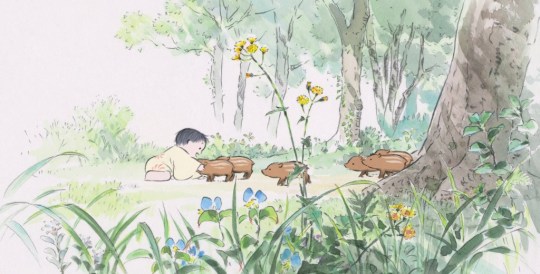
14. The Tale of the Princess Kaguya
While this notoriously expensive film flopped at the box office, The Tale of the Princess Kaguya was well-received by critics, and for good reason. Adapting a famed folk tale, the film is animated in style befitting its origins, creating the sense that the viewer has fallen into a some traditional Japanese painting. But the movie is not as pastel as its colors indicate—the storytelling is bold. It doesn't sit in the past, instead feeling remarkably current in the fable of a princess imprisoned by seemingly everyone and everything, without ever feeling worn or heavy-handed. Mystical and fantastical elements are both woven into the foundation of the story and come alive in key moments, keeping the film compelling (for the most part) throughout its two hour+ run time.
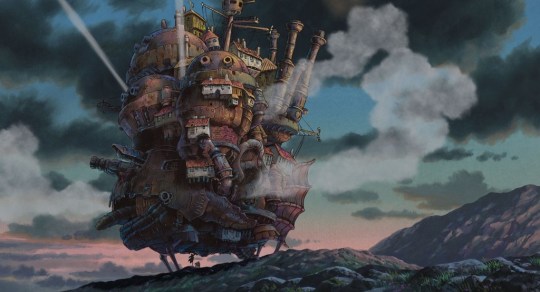
13. Howl's Moving Castle
An underrated aspect of Studio Ghibli's brilliance is in how they often adapt already-beloved works. Adapted by the master, Howl's Moving Castle, based on the novel by Diana Wynne Jones, is gorgeously animated and bold in both design and character—Howl and Calcifer, particularly, are memorable (and give strong emotional weight to the tale). While it suffers in comparison to its predecessor, Spirited Away, by being a little unwieldy, it remains a classic and an example of how well Miyazaki can bring themes and plot points across subtly (think of the flashback of Howl) in a movie that's otherwise fierce and larger than life.
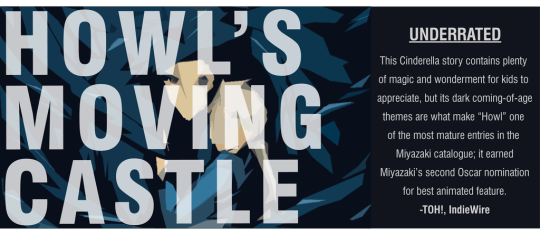
12. The Wind Rises
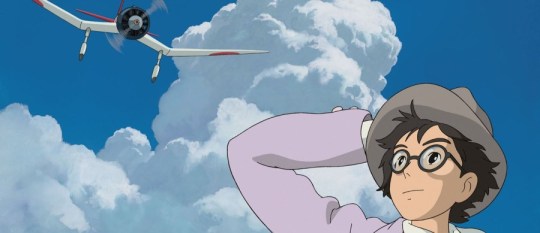
From conception, The Wind Rises was a challenging film—how do you tell the story of the man who designed a fighter essential to Japan's WWI efforts, and show him as a patriot and dreamer without excluding the crimes of the nation, or making a film that goes against Miyazaki's anti-war values? It's difficult to say if he succeeds, but the film itself is beautifully crafted. The supporting characters here are less important than in other works, so it's vital that the audience admires Jiro Horikoshi, and we do—his character and positivity make him easy to root for, and dream sequences in the film both flesh out his thought process and keep us captivated. Once believed to be Miyazaki's last film, if it had been, The Wind Rises would have been worthy of that designation.
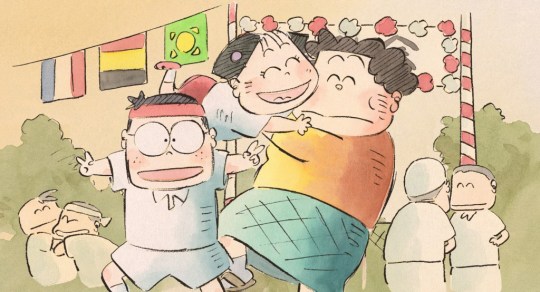
11. My Neighbors the Yamadas
The oddball in Ghibli's filmography, My Neighbors the Yamadas is presented through half-a-dozen or more short stories in the style of comic strips come to life, with animation that matches. The magic in the film is that the Yamadas are as over-the-top as the movie's aesthetic is, yet maintain an authentic feel. Think of some of the most popular family sitcoms of the 1980s and 1990s, but with an addition those shows could not feature—fantastical sequences that break in without warning and bind the ties of family further. We may not want to live like the clumsy Yamadas, but the heart of the family will make you consider whether they're the ones who really have it all together.
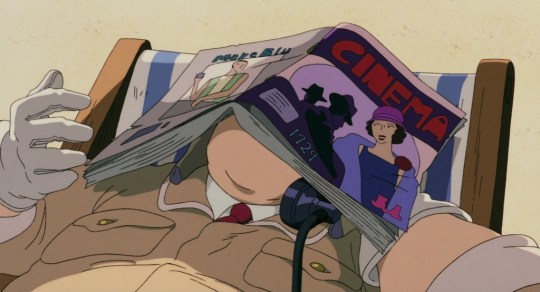
10. Porco Rosso
Studio Ghibli films share animation styles and themes, but one can never say they lack in variety when it comes to story. The tale of Porco Rosso is of an ace pilot cursed into living as a pig—but not to worry! He is still adored by women as he flies fantastic missions while running from fascists, pirates, and fame-seeking assassins. Porco is gruff and unattractive, but both he and the tale are sweet, as what's already a compelling story of WWI aces and dogfights is buffeted by grief, romance, and two strong heroines of very different types and roles. Perhaps the film with the largest range of opinion among the Miyazaki classics, Porco Rosso is nonetheless fantastic, and require viewing if you haven't watched it already.
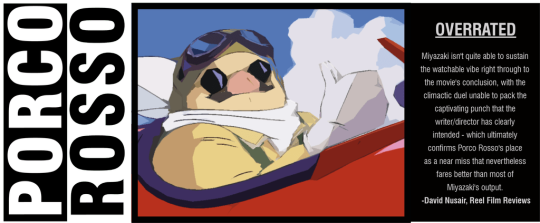
9. Whisper of the Heart
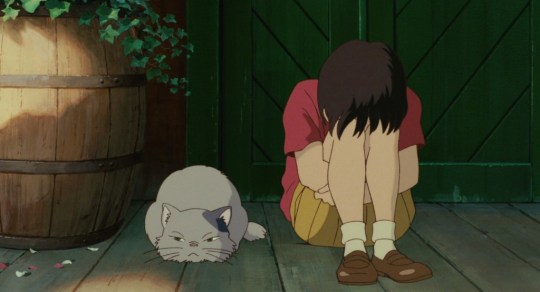
Ghibli's most unabashedly romantic film is one of its most formulaic, but still among its best. The debut film by Yoshifumi Kondō, Miyazaki and Takahata's proposed successor before he died just a few years after the movie's premiere, is at once encouraging while also refusing to shy away from the melancholy experienced by children—and adults, too—when one doesn't seem to have what it takes to become great. In joy and sadness, Whisper of the Heart lets the kids at the center of the film be kids. They are at times stubborn, silly, and immature, and by treating them that way, the movie never drifts into something banal (with the possible exception of the famously abrupt ending)—it's a lovely lesson in growing up and meeting challenges, and a personal favorite.
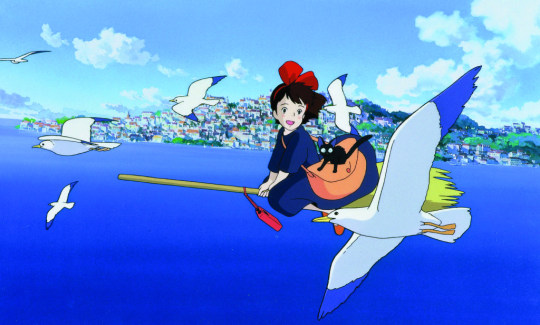
8. Kiki's Delivery Service
The charm of Kiki's Delivery Service is two-fold—in the setting, a northern European-style town that is alive, forcing the events of the story through its residents, cozy cafes, and early 20th-century transportion, and in Kiki's journey itself. Her community's tradition of sending of young witches to live by themselves at the age of thirteen sets the story in motion, and Miyazaki captures the spirit of a girl that age perfectly—in all its confusion, energy, enthusiasm, and difficulty. Kiki is not a subtle character, but her growth is. When she takes to the air for the finale, Kiki isn't experienced enough to know if she can save the day—and so we cheer when she realizes what the rest of us already know, what we've all experienced ourselves, that it takes time and failure to mold us into becoming the hero.
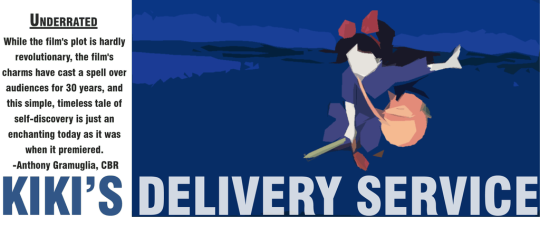
7. Castle in the Sky

Miyazaki created classic film after classic film for decades, in a streak that started with Lupin III and ended, I'd argue, with Howl's Moving Castle. Often forgotten among the wonders is Castle in the Sky, a steampunk entry that is a joyous adventure, akin to Treasure Island but developed for an audience of both boys and girls. Sumptuous cloudscapes fill the screen, as do colorful characters with meaty roles, including a group favored by Miyazaki—pirates (in this movie, air pirates led by Dola, an older female). Reflective of Miyazaki's ability to master genres, Castle in the Sky again crosses fantasy and sci-fi in perfect proportions, underscoring an uplifting tale with an apocalyptic story line.
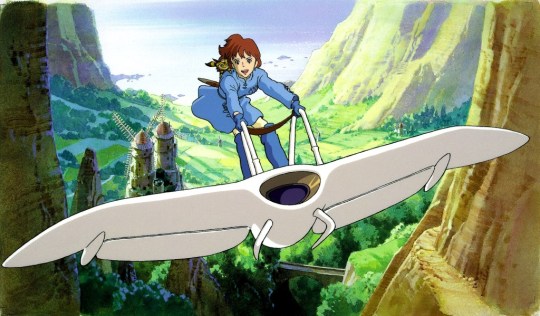
6. Nausicaa of the Valley of the Wind
Unofficially part of of Ghibli's canon, the success of Nausicaa, based on Miyazaki's own manga and exploring the ecological, anti-war, and feminist themes for which the studio's future films would be noted, launched Studio Ghibli. Nausicaa herself remains one of the studio's most iconic and compelling heroines, a physically powerful and feminine hero who must grow into adulthood very quickly while putting aside deep flaws to offer salvation to her people and land. The beautiful landscapes speaks to the epic story, better fleshed out in the manga, while reminding us that Ghibli films are giants not only in animation, but in fantasy and sci-fi realms as well.
5. Only Yesterday
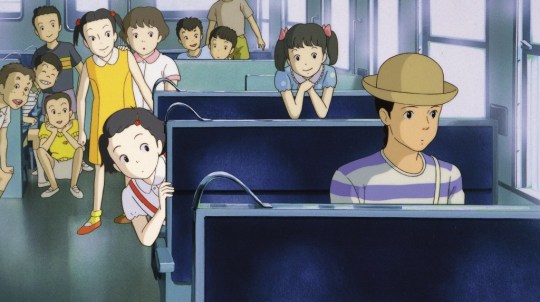
How do you create an animated film about a twenty-something woman that waxes nostalgia while on a trip to the countryside, and at the same time make it entertaining and accessible? It's not an easy task, but Only Yesterday accomplishes it fully. Taeko, the protagonist, explains, "I didn't intend for ten-year-old me to come on this trip, but somehow, once she showed up, she wouldn't leave me alone." We experience her nostalgia for and complicated feelings about the past through a family that's genuinely flawed, while experiencing her visit to relatives in the countryside in the present, a trip that is subtly life-altering, one that pushes her to consider who she is and who she wants to be. Oh, and the film also features one of anime's most wonderful endings, set to a cover of a now-classic love song.

4. Grave of the Fireflies
It's a testament to Miyazaki's stature that the first three Ghibli films on the list are all directed by him, and also to the supreme talent of the other directors that their films rise above some of his other tremendous work. Directed by Studio Ghibli co-founder, the legendary Isao Takahata, Grave of the Fireflies is the most painful and emotional movie in the canon; it is also one of the greatest war movies ever made, using animation to deftly explore the how war victimizes children. Opening and closing shots, both of which express the uncaring nature of bystanders (and by extension, the world) toward children cause us to wonder what we really feel about the world's most vulnerable population.
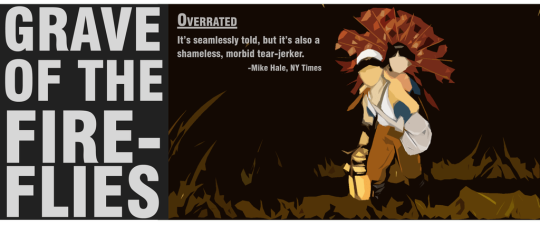
3. My Neighbor Totoro
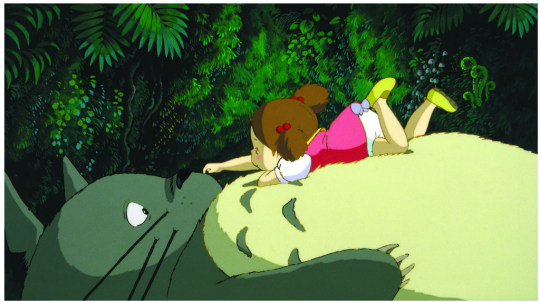
It's often said that nothing really happens in My Neighbor Totoro—but that's part of the magic of the film. A child's movie in all ways, including in the action, which revolves around a sick mother, a move to a new house, and a lost child, the film finds its center in a magical being that never says a word (Totoro only growls), and about whom many theories abound. If Totoro is a figment of Satsuki and Mei's imaginations, he is then similar to Winnie the Pooh, a necessary presence in the lives of a child character (two of them, sisters, in this case) who is growing up in a difficult situation, not to adulthood, but to the next step in the journey of life.
2. Spirited Away

Miyazaki has retired and unretired several times—when did so following Princess Mononoke, he returned with what is often considered his magnum opus, Spirited Away. At once deeply Japanese and completely accessible, the movie takes viewers on one of the most remarkable visual journeys ever put to film, a feast that never relents through its entire run time. Perhaps underrated is Miyazaki's decision to move the action away from the bathhouse for much of the final act, a quiet last leg that is key to Chihiro's journey, as well as for many of Spirited Away's supporting characters. Absolutely deserving of all love and acclaim.
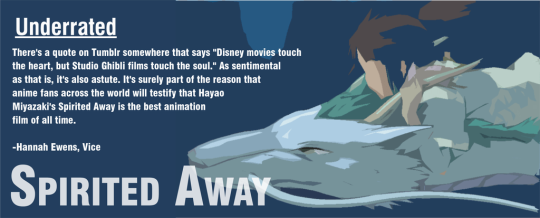
1. Princess Mononoke
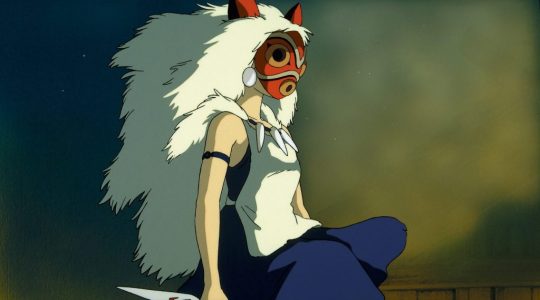
Studio Ghibli's finest film is also perhaps its most surprising. Visceral, violent, and conflicting, Princess Mononoke is no easy tale to absorb. There is no "good guy," not in the traditional sense, as Miyazaki explores hist favored ecological theme but through the lens of humanity struggling to survive in a world where they are just surpassing nature, the beast gods and goddesses who had previously ruled. It is an epic in the vein of films from decades before with vibrant and complex characters, ground-breaking animation, and an English voice track that is second to none. The studio's most intricate work, Princess Mononoke requires multiple viewings to fully appreciate.
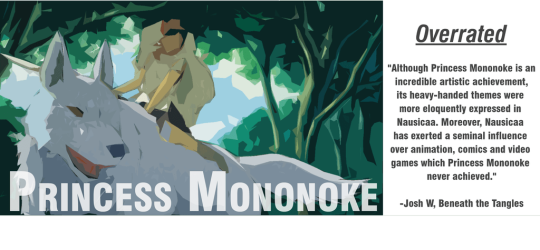
--
All Studio Ghibli movies are available for sale, including many in special collectible editions. We encourage you to go check them out!
157 notes
·
View notes
Note
So I recently sent a response to Shannon McCormick, Oz's voice actor: "I know you said the group is gonna trust Oz again and reconcile, but I'm not feeling very hopeful. They're still so bitter towards him and not trying to understand him... and are doing the same things they demonized him for, yet it's being treated like it's okay. I know you can't give spoilers and I don't expect you to, but it's something that's got me really down." He responded with: "Keep the faith."
Hey Miki-chan. Ah yes, good ole Shannon coming in clutch with that boast of optimism. I’m actually curious as to whether or not, we will even get to see Oz return for V7. The opening certainly didn’t give any indication of it; sadly to say. If I’m expecting Oz to return at all, it’s probably by the end of the season.
While I do want Oz to return and reconcile with the group, I’m skeptical about having it go back to the way things were before with Ozpin constantly taking control of Oscar’s body and more or less eclipsing his development. I miss Oz but I don’t miss that. This is why I liked how they showed him as a more of guiding voice for Oscar at the end of V6 with the airship crash.In my opinion, that’s what I initially assumed their dynamic was going to belike until the show revealed the soul swapping technique in V5.
I want Oscar to shine on his own, if possible, for V7. If Oz were to return to the story, I hope his role is relegated to being more of a literal voice of reasonand guidance taking up full residence inside of Oscar’s head; not really takingover as much as he used to but lending instructions to Oscar on how to moveespecially in combat while allowing the young boy to think on his feet and makeuse of that good ole muscle memory he is expected to inherit. If Oscar isbecome Ozpin’s successor and successful one to boot, Oz can’t keep holding his hand. He’s got to let Oscar grow into the role and I think he’s being goinggood so far. But he still does need Oz to be there to help. Hence why I’mhoping that, if Oz is to return, I really wish for Oscar to be the one to go inafter him to bring him back.
Since Oscar was the only seen to show Oz a bit of sympathy last season, I wish for this to continue as it can definitely push the growth of the bond between the Two Souls. If there is one person I’m expecting to vouch on Oz’s behalf at this point, it’s Oscar. Ruby was another character I was hoping would certainly join him in that court. However…things are a little complicated right now with our little red rose and the path she seems to be taking this season. I’ll discuss this more under thread.
While we’re on the topic of Oz’ reconciliation with the hero group, I’m really sorry to hear that this development has had you disappointed and feeling down, Miki-chan. I get where your frustration is coming from but at the same time, I also agree with Shannon on keeping the faith.
Similar to how Oz’s skeletons coming out of the closet was a narrative slow-burn that’s been churning since as early as V5, I feel as if it’s going to be the same forhis path to redemption with the team and regaining their trust. The only thingI dislike about this plot point is how we still have everyone more or less sharingthe same opinion of Oz with little indication on whether or not anyone isreally starting to consider that the other side of the coin where Oz wasjustified in his actions.
When this plot point first dropped back in V6, what was fascinating about it was how divided it made the fandom. It opened the grounds for discussion and debating with everyone sharing their different outlooks on the scenario and that was quite neat.
I just wished that the Writers had mimicked that in the series; y’know? When I first saw the V6 volume poster, art with Oz and Oscar at the centre while Team RWBY were all divided around the two of them; I figured that that was what the season was going to be like more or less.
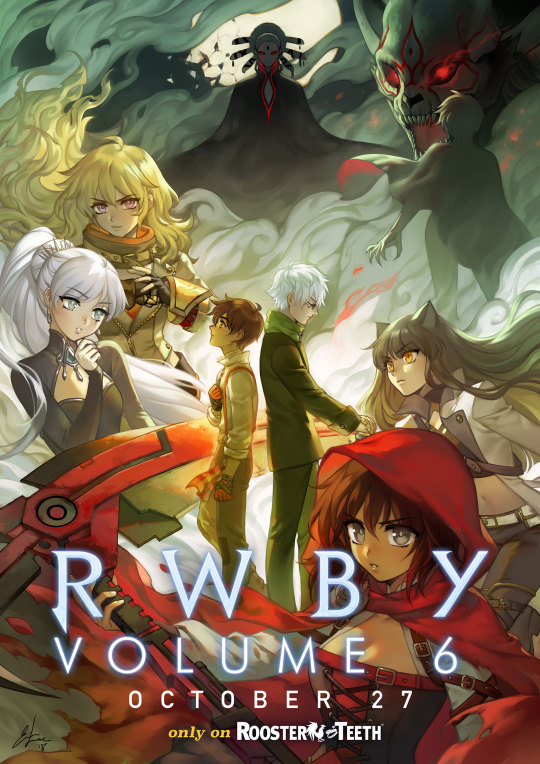
With the team being divided on their overall trust Oz and growing trust in Oscar with some folks, such as Ruby and possibly Blake standing in the court that defended both souls whereas Weiss and Yang weren’t as convinced.
It would’ve been great to see everyone sharing different outlooks and reactions to the news about Oz’s past with Salem and her immortality; Team RWBY’s as well as JNR’s.
It would’ve been great to see that because it could have even leant itself to paving the road towards Ozpin’s eventual reconciliation in this new season or whenever the showrunners decided to have it happen down the line.
However, instead, thus far it’s mostly been everyone sharing the same opinion—Oz was wrong and is not to be trusted anymore.This is now made even worse by the notion that the heroes are currently committing the same action of ‘deceiving and/or withholding vital info from your allies’ as Oz once did with them.
However what’s almost comical is how the narrative—the PLOT—is trying to get us as the audience to think that the heroes are in the right when really…they’re not?
At least to me, they’re not. I’ve seen examples of other FNDM fam members taking a supportive stance for the actions of Ruby and the other heroes’ deceit with Ironwood and their Atlesian allies. This squiggle meister, on the other hand, has not been that easily convinced. Sorry.
I think what bugs me the most regarding the execution of this subplot is how much the heroes are able to get away with when it comes to their actions. I understand that the Writers are more or less attempting to show a parallel between our gaggle of heroes and Ozpin by having them take greater risks for the sake of fulfilling their mission while additionally making questionable choices.
That idea is fine and I like that they’re doing this with them especially since I think it could still lend to them eventually making up with Oz by understanding why he did the things he did since now they’ve been in his shoes. That part of it is good. Great even.
However, somehow, I dunno—for me, our heroes’ recent actions don’t have the same kind of impact on me as Ozpin’s did. I guess where I’m really getting at here is that when I learnt the truth about Oz last season, my main reason for staying in his court was because I understood his reasons for doing the things he did.
While I’ll call Oz out for his wrong in lying and keeping his secrets from people he believed were his most trusted allies, I was still sympathetic towards Oz because I genuinely felt that his actions were justified especially following the events of the Lost Fable.
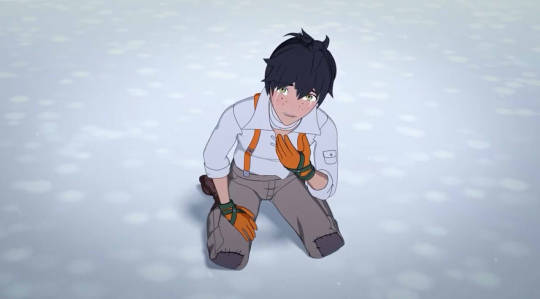
The PLOT wants me to believe that Oz is this morally grey type of man and he is, to some degree. However the PLOT also wishes for me as the audience to believe that Oz has been nothing but this deceitful person throughout history and that the heroes are perfectly in the right for choosing to never trust in him again. But here’s the thing with that—I see Oz as being more…smart than fraudulent.
Yes Oz told lies and half-truths and kept important secrets that could shake the world of Remnant—but what some people seem to be forgetting is that there was good, valid reason behind the way Oz chose to do things. Oz was careful. Meticulous with the kind of people he chose to disclose the truth to as well as the information he chose to tell them and the right time to revealsaid information as well.
I’d like to think that this is how Oz was able to successfully keep things under wraps for so many lives as a means of more or less keeping the peace. Because of how careful he’d chose to move along with the kind of people he decided to place his trust in. Oz was cautious and as he explained in V6, his vigilance was backed up mostly by his experience over the centuries especially his first one with Salem
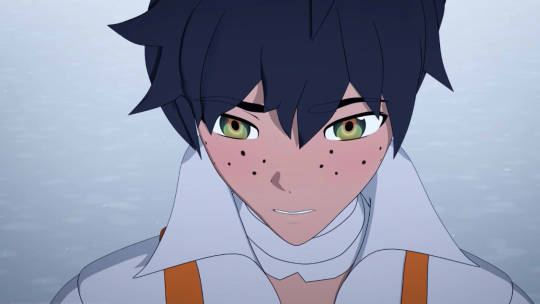
This is the issue I’m having with our heroes. Although they are committing the same actions as Oz, especially the part of choosing to hide the truth from Ironwood—their actions feel reckless and unwarranted in my opinion and I can’t get behind it as well as I did with Ozpin because I personally don’t feel the heroes are as justified in their actions as Oz was.
Even though the PLOT is trying to paint this picture that James shouldn’t be completely trusted and our heroes are in the right in not trusting him fully with the truth about Salem, for me, I honestly felt like our heroes jumped the gun on that one, just like how they jumped the gun back in Argus in choosing to illegally commandeer an airship to Atlas as opposed to trying any other means that could’ve rendered them the same results with less repercussions involving trouble with the military and the safety of the citizens of Argus.
According to the PLOT, Ruby was correct in making the call to not reveal the whole truth to Ironwood given how he and his forces have been treating the poor people of Mantle; not to mention our heroes upon their arrival in Atlas. This isevidenced by Ruby in V7CH3 in her response to Yang’s questioning.
“Can we talk about that again?”“What about it?”
“We’re really not going to tellIronwood about what happened to Oz? What we learned about Jinn? About Salem?”
“…We are! We…will. But you saw howthings looked when we flew into Atlas.”
“The General’s heart seems to be inthe right place but…that doesn’t mean we should trust him yet.”
“Why don’t we play along for a whilebefore we make any major decisions?”
I’d like to highlight Ruby’s indifference to her own actions again. Just something I pegged noteworthy since it reminded me of her attitude towards revealing her true feelings regarding the Aftermath of the Fall of Beacon—how she nonchalantly seemed to shrug away Oscar’s attempt at telling her that it’s alright for her to be open with him about how she’s truly feeling… right before Oscar switches his approach and firmly calls her out on his indifference which in turn finally forced her to come clean and be straight with him.
While I understand that the whole Mantle situation is a complicated matter, to me, that still doesn’t rule out it being a good reason for the heroes to lie to Ironwood.
I’d understand it more if it was a matter of Ruby being strategic in the information that she discloses to Ironwood but that’s not what the case is here. It’s not to saythat Ruby told James some of the truth and was very careful with what she chose to disclose and how she worded said information. It’s that she flat out liedand then repeated the same lie that Oz had fed them about the Relic ofKnowledge back in Mistral.
I know Ruby is trying to say she can’t trust Ironwood 100% because of how things are looking in Mantle and Atlas because of his actions. But on the other hand, I’m surprised it didn’t inspire her to be more upfront rather than the opposite take.
Based on what Pietro said in the first episode, Ironwood has been paranoid and on higher maintenance since the Fall of Beacon. That being said, why chose to withhold information from a man who is already fearful of being betrayed again by those closest to him since it was mentioned earlier in the season that it was one of his Atlas’ own—someone who worked closely with Atlas’ security and the military (Watts) that contributed to the destruction of Beacon Academy and so much more in chaos in Vale?
“The Fall of Beacon took a toll on all of us. James was no different. I couldn’t tell you exactly what it is he saw there, but it changed him. He’s—”
“…He’s scared.”
“Paranoid would be the more appropriate term. You have to understand, it wasn’t just the Grimm. Someone completely dismantled Atlas’ security code. Made it their plaything and made us look like traitors to some and buffoons to everyone else. Whoever managed to do that is either a genius or one of our own. I fear the answer may be both and so does the General.”
Again, with that thought in mind I ask again, why did Ruby think it was a wise choice to lie to Ironwood given what she learned specifically from Pietro regarding his frame of mind right now?
See why the hero’s actions are having the opposite effect for me?
While I get why it’s a possible motive, I still think what the heroes are doing with James is unwarranted. As a matter of fact, I feel like they’ve only made thingsworse for themselves by withholding info from Ironwood given his current frameof mind.
I’d like to think that Ironwood’s experience in Vale has made him more than just paranoid. He’s become more…I wouldn’t say soft but emotionally vulnerable than he was when we first met him.
This is why I don’t wish for Ruby’s mistrust of Ironwood to come back to appear as if she took advantage of Ironwood in his vulnerable state. Because I feel like that could easily feed into Ironwood’s paranoia—to learn that he couldn’t eventrust the people he placed fate in and showed kindness to. To show that heextended them his hand in reliance only for them to not do the same of him.
I know one of the common FNDM theories is that Ironwood isn’t being completely honest with our heroes, however I’m starting to think otherwise. Up until this point in the plot, Ironwood has been upfront with JNR_RWBY and Qrow about everything. Every question they’ve asked of him, he’s told them in full confidence. So far, I haven’t gotten the impression that James has been lying to the heroes at all.
Since he returned the Relic of Knowledge to Ruby and reassured her of his trust,I genuinely feel like he’s been nothing but upfront with the group abouteverything including all that’s been going down with him and his kingdom—bothsides of it.
If Ironwood was shown to be shady as well then I could’ve easily bought into theheroes doing the same thing with him because then their actions would’ve beenreasonable. If Ironwood was the same man he was shown to be back in V2 and was shown to be withholding important information from our heroes especially when they asked him vital questions in need of clarification, similar to how Oz had done with them, then I could’ve gotten behind our heroes taking that mindful approach.
However, this isn’t what I’ve seen from the show’s execution. Instead I’m seeingIronwood behaving pretty trustworthy while the heroes are the ones beingdeceitful and it all feels so very wrong on the heroes’ part. Especially when you have some of them behaving that they were right in keeping secrets from James. What especially bothered me a little was what Qrow told Ruby in the recent CH4.
“I’m trying to do what I think is best but…I really can’t tell if what’sbest is what’s right or if I’m no different from Oz”
Then is an excellent question for Ruby to ask of herself. It’s great because it highlights that she’s taken into consideration what her teammates have toldher—particularly Oscar. It shows that Oscar’s questioning of her actions mimicking Ozpin’s has weighed on her mind-set. So I’m pleased with this frame of thinking from Ruby. However, this moment is short-lived for me by what Qrow says next in response to Ruby’s statement.
“…Ruby, Oz only trusted himself with the whole truth. You’re trusting others, making sure they prove themselves first. I think that’s a pretty big difference.”
…Okay….One thing admittedly right about that statement, yes. Yes; Oz did only trust himself with the whole truth. That is indeed correct. But, there’s also some clear wrong in that statement as well.
Qrow…I get that you’re probably still very, very upset that Oz deceived you and hurt you on a personal level. However, what I am in completely disbelief of is—how could Qrow say that Ruby is no different than Oz because she trusts in others, making sure that they prove themselves worthy of her trust before giving the whole truth?
I’m sorry…WHAT! But…but…Qrow; how can YOU of all people say that with a straight face? How can you remotely imply that at all? Especially the line about Oz only trusting himself and putting his faith in those he believes trustworthy. I’m sorry but that line comes off like utter rubbish to my ears.
Qrow Branwen—you are a living, breathing exemplar of earning Ozpin’s trust. Oz trusted you! He trusted James. He trusted Glynda. He trusted LeonardoLionheart. The entire Inner Circle of Oz only exists because Oz decided to place his trust in a handful of people he deemed worthy of knowing the truth.
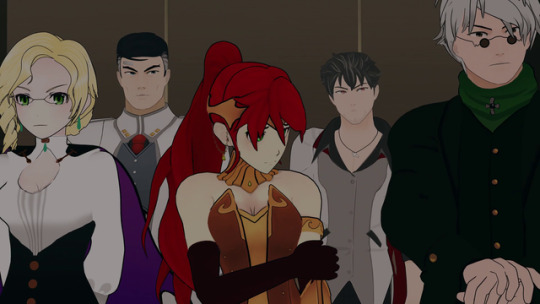
While he kept the main truth about Salem’s immortality to himself; that doesn’t erase the fact that he trusted his Inner Circle with everything else. The Maidens. The Relics. Even his own immortality curse and reincarnation cycle. Oz told it all to this particular small group of people because he believed he could trust in them. Oz believed in the integrity of ALL members of his Inner Circle because he trusted each and everyone of them….EVEN when they stab him in the back. Right V2 Ironwood? Right Lionheart?
He even believed in Team STRQ! I’m actually curious to know how muchdid this team know about the truth. We know he trusted Raven and Qrow byturning them into birds with his magic. So I’m curious to know if Summer andTai were also fully aware of ¾ of the truth that Oz trusted his main peoplewith. I’m assuming they did and they kept it as part of their secrets as well.
Speaking of—Qrow, are you forgetting that you also helped Oz keep and uphold some of those secrets? He entrusted you with ¾ of the whole truth and you’ve been sitting on it as well as your own secrets that you were keeping from your family; particularly your young nieces.
In a nutshell, Qrow’s statement to Ruby further highlight’s the hero’s hypocrisywith Oz. For me, this line didn’t serve to debunk the fact that Ruby is turningto Oz. It only embellished it for me. It affirmed it.
Ruby is indeed turning into Oz and what’s sad is that Qrow, her own beloved uncle and mentor figure, is oblivious to this fact because he’s currently too blinded by both his sustained resentment towards Oz and his love for his niece.
And it’s pretty much the same for everyone else. Weiss and Blake are pretty complacent with following Ruby’s lead and backing her up on her actions with Ironwood. Yang shows uncertainty but is otherwise complacent too. We still don’t know how Jaune, Nora and Ren feel in regards to this. I’d actually like to hear them weigh in their thoughts on Oz and Ruby’s actions towards James. But I’mconcerned we might not get that since, as evidenced by the PLOT, I think it’spretty clear who are the key drivers of this subplot for V7.
I feel like it’s going to be mostly our veteran Rosebuds—Ruby and Oscar—presenting the two differing sides of this subplot with deceiving Ironwood and I feel like Oz’s reconciliation is prevalent on the results of it.
My theory is that Oscar will be the key to jumpstarting the path to Oz’s reconciliation with the team.
Moreover, I feel like Oscar is going to need Ruby’s support in vouchingfor Oz with the rest of the team; especially with Qrow and possibly Yang and Jaune.
Since the running thing is that most of the hero team follow Ruby’s leadership, I think it can be safe to say that so long as Ruby still shows uncertainty with Oz, it’s going to be mirrored by the others. I think if Oscar gets Oz to come back fromhis isolation in his mind and then gains Ruby’s full trust by helping see thewrong in what she’s doing now by doing the exact thing Oz did while alsohelping her to understand where Oz was coming from.
The only person I think this isn’t go to win over is Qrow. At least, I think Qrow might end up needing more time to work out whatever is going on with him before he can “forgive Oz” since his anger towards him is all wrapped up in his issues with himself and his semblance which encompasses his entire life thus far basically.
Before, Qrow looked to Oz for validation in the good that he was doing which was why the revelation hit him harder than anyone else. So until Qrow works out his inner skeletons, I think he’ll still be resistant to facing Oz again. Thisseason teased Qrow sharing good “comradery” with Clover. I’m curious to seewhere that will go and whether or not it will lead into Qrow dishing out somedetails on what his past was like with Oz back when he met him as a student ofBeacon.
As a matter of fact, I’m intrigued by any info regarding what Oz’s relationship was like with all the members of his Inner Circle since I believe it can lend to Oscar’s turn with the Merge.
Like I have a Tin Solider headcanon that Ironwood has actually known Oz from since back when he used to be old self—meaning the man I’ll dub Zoroaster Ozpin, nicknamed ‘Zo’ for short BEFORE he became the man we know as Professor Ozpin.
We know who Oz is but…who was Oz before he became Oz? Who was Zo and did Ironwood know him personally?
Ironwood’s remark to Oscar about Oz’s disappearance not being normal definitely gave me that impression. I think it could be pretty cool if one of Oz’s closest known allies actually knew him before and after the Merge. It could help shed some much needed perspective for Oscar on what the Merge entails for him especially if he heard it from the mouth of someone who knew Oz closely for basically two lifetimes? I’d really love to see something like that done for the canon.
But that’s only my hunch.
I’d honestly wish to discuss more on this subject since there is surprisingly more I can say about this. However this is getting a little too long for a simple response post. Just another day, am I right? XD So I’m going to end it right here.
I know you didn’t really ask me a question Miki-chan but I still wanted to provide my take on the subject matter you presented and I hope you enjoyed reading it. Feel free to answer or inbox me another message if you’d like as always ^u^)b Peace!
~LittleMissSquiggles (2019)
#miki-13#squiggles answers: rwby#professor ozpin#oscar pine#ruby rose#oscar and ozpin#rwby theories#rwby volume 7 theories
25 notes
·
View notes
Text
9 WAYS TO KEEP YOUR MOBILE DEVICES SECURE WHILE TRAVELING
From coffee shops to planes, trains, and cruise ships, we've become accustomed to having ready access to the Internet just about anywhere. The problem is, it's easy to forget how vulnerable that makes us to security threats.
I learned this the hard way recently when traveling from San Jose to Tampa, passing through four cities along the way. Even though I'm well aware of the potential for others to hack into my devices, I'd never had any problems previously. Unfortunately, there's always a first time: When I got back home, Facebook alerted me to some suspicious activity. I had been "Firesheep'd"!
Apparently someone in Chicago (using Firefox and a Windows PC) had logged into my Facebook account via Firesheep, a Firefox extension that can intercept unencrypted cookies from certain Websites on any open Wi-Fi network, making it possible to steal login credentials for sites like Facebook and Twitter, or even access your e-mail.
Think it can't happen to you? Think again. Fortunately, a combination of plain old common sense and some technology can protect your devices--quickly and fairly easily.
HOW YOUR GADGETS MAY BE VULNERABLE
Whether you're traveling with a laptop, netbook, smartphone, iPad, or all of the above, the risks and defenses against them are basically the same, according to Joe Nocera, an information security expert and a principal with PricewaterhouseCoopers. "Many of the security concerns that people think about when they think about their personal computers are applicable in the mobile world." As mobile devices become more sophisticated, they lend themselves to the same types of access to e-mail, passwords, and other secure information that PCs have done in the past.
Because today's devices are so much more powerful and can hold so much more information than ever before, the risks are increasing, says Martin Hack, information security expert and executive vice president of NCP Engineering, a software company that helps businesses with their secure remote access systems. Add to that our tendency to carry both personal and business information around with us on the same device, and our mobile devices have never looked so appealing to hackers, he says.
As specific mobile devices become more popular, they become more of a target for hackers. "Five years ago, the vulnerabilities were Microsoft-based and targeting PCs. Apple tended not to be targeted so often," says Nocera. "But, in the last year and a half or so, we're seeing a shift. More and more often we're seeing either Android- or iPhone-based vulnerabilities being targeted. We predict that by 2014 you'll see those types of vulnerabilities being the most targeted as more and more users go to those mobile devices."
The good news is it's not difficult or even expensive to protect your devices and the information on them. The fixes are simple. The problem, stated quite eloquently in an old Pogo comic strip, is: "We have met the enemy and he is us."
9 TIPS FOR KEEPING YOUR MOBILE DEVICES SECURE 1. Make sure your software is up-to-date. The first line of defense, says Nocera, is making sure that all your software is up-to-date. "Almost every release of software patches a number of security vulnerabilities that are out there," he says. Before every trip, or at least every few weeks, it's a good idea to check the manufacturer's Web site (or search Google) to see if a software or firmware update is available. If there's a new one, download it, unless there's a massive firestorm of negative reviews from early adopters.
2. Employ strong passwords. "Be sure to use some combination of letters, numbers and/or special characters of 8 characters or more," says Jeremy Miller, director of operations for Kroll Fraud Solutions. "Avoid using dictionary words. Instead, [use] acronyms for things like favorite songs, restaurants or other items known only to you. And change the password frequently--at least once every six months." If you're just not feeling clever enough to create your own passwords, programs like RoboForm will do it for you.
3. Don't mess with the security settings. Nocera notes that most of the default browser settings in Android, iPhone, and Blackberry phones are fairly secure out of the box. "I recommend not going in to change browser security settings--they're pretty good already," he says.
4. Avoid unencrypted public wireless networks. Such Wi-Fi networks require no authentication or password to log into, so anyone can access them--including the bad guys. In some cases, bad guys set up an open network to snare unsuspecting people. Encrypted networks, on the other hand, are those that require an ID or password for access--you'll find such networks at many hotels and coffee shops that offer Wi-Fi services. These networks have two different types of security--WEP (wired equivalent privacy) and WPA (Wi-Fi protected access); the second is most secure. Even encrypted networks, though, have risks--it's possible for bad guys to gain access to encrypted networks at a hotel or café, for instance, so be cautious about the sorts of things you do on such networks.
Besides avoiding connecting to unencrypted networks, turn off Wi-Fi when you're not using it. This will prevent you from automatically connecting to networks (and it will extend your device's battery life).
5. Paying to access a Wi-Fi network doesn't mean it's secure. Access fees do not equal security. Just because you pay a fee to access a Wi-Fi network doesn't mean that the network is secure.
6. URLs beginning with 'https:' are safer (but not foolproof). Whenever you're accessing a site where you'll be sharing personal or confidential information--your bank's site, for example--you want to make sure that you're doing so securely. The s in https means that you're connected to the site via the Secure Socket Layer (SSL). In layman's terms, this means that all data transmitted to that particular Website over the Internet is encrypted.
SSL is not foolproof though: If you're on an unencrypted network connection, you may still be subject to man-in-the-middle (MITM) attacks, a form of eavesdropping where the bad guy makes a connection independently with two parties and then "gets in the middle," making both believe that they are talking directly to each other.
These types of attacks are rare, but to guard against them, make sure you're both connected to a secured network and that Websites use https when you're entering sensitive information.
In addition, says Nocera, most e-mail service providers have both a clear text option (that sends unencrypted data) and an encryption (SSL) option. "Make sure you have the SSL option enabled," he says.
7. Use VPN. If you have access to a VPN (virtual private network), use it. A VPN provides secure access to an organization's network and allows you to get online behind a secure layer that protects your information.
8. Turn off cookies and autofill. If your mobile device automatically enters passwords and login information into Websites you visit frequently, turn that feature off. It's convenient, but it can also be a privacy threat. To get back some of the convenience that autofill offers, you can try third-party apps, available for most platforms, that can manage saved passwords with a higher level of security. Mac OS X, for instance, comes with a built-in password manager--Keychain. KeePass is a free, open-source password manager for some versions of Windows. For iOS and Android smartphones, there's LastPass, 1Password, and SplashID. Using them is not as secure as turning off autofill altogether, but it's one way to strike a good balance. In the end, a little inconvenience can go a long way toward added security.
9. Watch your apps! Apps are great, and many are free, so it can be tempting to download with abandon. But, Nocera cautions, you should be selective about the apps you download, particularly in the Android market, because "the Android app market is a little bit more open," without the strict developer guidelines found in Apple's App Store. Do some due diligence before downloading apps. Make sure that you trust the developer and have taken the time to review some of comments.
TaintDroid is an Android tool that can identify apps that transmit private data and notify users that a third-party application is requesting private information. However, it's not an app that's offered through the Android Market. Instead, users have to manually compile and build the app using the framework provided by an app analysis company.
IF YOU STILL GET HACKED... If you do everything right and still have your information stolen, what should you do? The damage can often be repaired simply by changing your password (to one much stronger) and sending a message via the network that was affected, explaining what happened. What if one of your devices gets stolen? Be sure that all of your mobile devices have a remote wipe or autowipe feature. For Apple's iPhone and iPad, there's Apple's MobileMe service. GoogleApps offers a solution for Android as well. If your device is lost or you know there's been a breach, you can quickly and remotely perform a factory reset from any computer connected to the Internet, wiping out all of the device's data and even locking it indefinitely.
1 note
·
View note
Text
Blindspot: Empowering Invisibility

I’ve been writing posts reflecting back on my favorite parts of Charles Soule’s Daredevil run... and hey, I almost got through all of them before the new run started! The final topic I wanted to cover is Sam Chung/Blindspot, who-- alongside Real Boy Mike Murdock-- is the most significant new character Soule created during his time on the comic.
Sam has come a long way for a guy everyone thought was Gambit when his image was first released. With his introduction, he became Matt’s first official, long-term “apprentice” and a compelling addition to the ranks of Marvel’s young, up-and-coming superheroes. I’d always wanted to see how Matt would handle a sidekick, so I was very excited about this, and while I think Sam’s story was not as strong as it could have been, I am eager for him to return to further cement his role within the Daredevil universe and beyond.
Matt has acted as a mentor in the past (most notably to Angela Del Toro, the second White Tiger, during Bendis’s run), but Sam is the closest he has ever come to having an actual sidekick. Thus, his new working relationship with Sam puts him in a fun new role: passing on what he has learned as a superhero, and testing his abilities as a teacher.
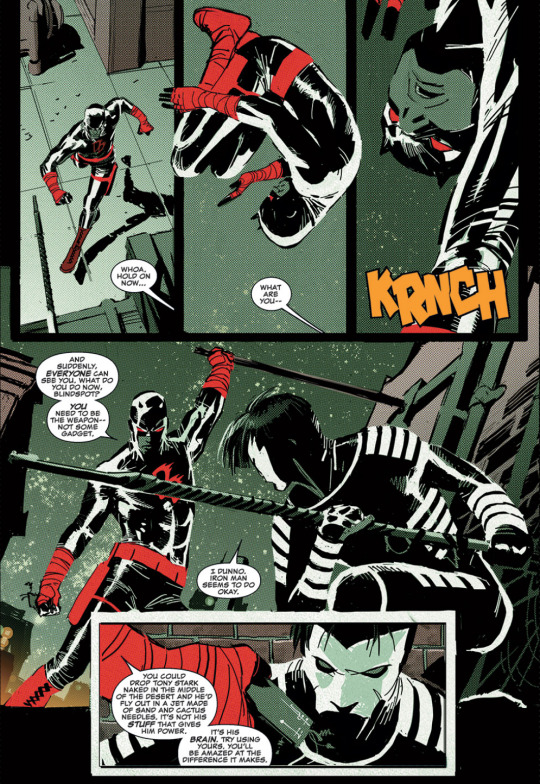
Sam: “Whoa, hold on now... what are you--”
Matt: “And suddenly, everyone can see you. What do you do now, Blindspot? You need to be the weapon-- not some gadget.”
Sam: “I dunno. Iron Man seems to do okay.”
Matt: “You could drop Tony Stark naked in the middle of the desert and he’d fly out in a jet made of sand and cactus needles. It’s not his stuff that gives him power. It’s his brain. Try using yours. You’ll be amazed at the difference it makes.”
Daredevil vol. 5 #2 by Charles Soule, Ron Garney, and Matt Milla
Soule’s run, overall, suffers from a lack of emotion. It is all plot, no character, and this weakens the development of Matt and Sam’s relationship. Beyond a touching glimpse of their initial first encounter in All-New, All-Different Point One (Sam’s introductory issue), we don’t get to see much of their developing dynamic. The run jumps right in after they have already started working together, and that’s mostly the context in which we see them-- work. We don’t get any real bonding scenes. We don’t get to see Matt decide to train Sam (which must have been a huge decision-- Matt would have been hesitant to take on that responsibility, especially since he’d just tightened up his secret identity again) or the early negotiating of their relationship. Sam later comes to see Matt as a father figure, which should be very powerful, but the only way we know that is because he comes out and says it, because of the shortage of actual parent/child-type moments between them.
That said, there is a lot to enjoy in their dynamic. Matt and Sam are very similar people, and this makes them great foils for each other. Like Matt, Sam is stubborn, smart, and often reckless. He has an attitude, as well as a huge amount of compassion and a desire to help others. He also has a lot of secrets (neither knows the other’s civilian identity for a significant amount of time, which contributes to the emotional distance mentioned above, but is also completely in-character.) And Sam and Matt work well as a team and develop a lot of respect for each other. Matt is a tough but fair teacher, and he sees himself in Sam.

Sam: “Well, I finally got the cast off my arm.”
Matt (caption): “Right. The cast for the arm Elektra broke when I introduced her to you in a fit of utter idiocy.”
Sam: “Thought I might get a workout in. It’s been a while.”
Matt (caption): “A workout. He means he’s going out on patrol as Blindspot. I get it. The hero game’s addictive. It’s hard to stay away for too long. God knows I’ve rushed back out before I was ready a hundred times. [...] He’s not listening to a word I say. Then again, when I was in his place, training with Stick... I didn’t listen much either. I heard... everything. But I didn’t like to listen. Oh, well.”
Daredevil vol. 5 #10 by Charles Soule, Ron Garney, and Matt Milla
The similarities don’t end there. Like Matt, Sam grew up in a low-income single-parent household, and has close ties to a particular Manhattan neighborhood (in his case, Chinatown). But his situation is made even more challenging by the fact that he is an undocumented immigrant, and this distinction between Matt’s experience and Sam’s is actually really interesting. Matt fully sympathizes with Sam, but there is a disconnect that highlights the additional challenges in Sam’s life that impact his budding superhero career.
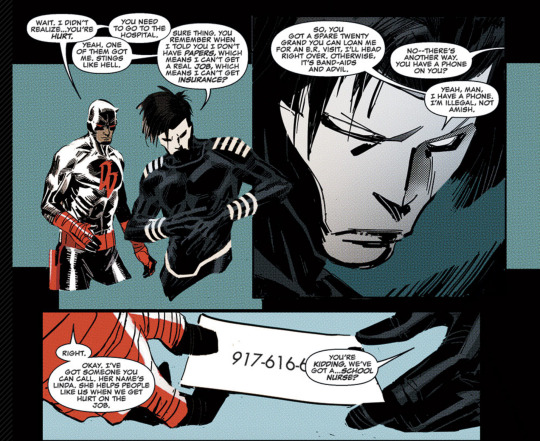
Matt: “Wait. I didn’t realize... you’re hurt.”
Sam: “Yeah. One of them got me. Stings like hell.”
Matt: “You need to go to the hospital.”
Sam: “Sure thing. You remember when I told you I don’t have papers, which means I can’t get a real job, which means I can’t get insurance? So, you got a spare twenty grand you can loan me for an E.R. visit, I’ll head right over. Otherwise, it’s band-aids and Advil.”
Daredevil vol. 5 #3 by Charles Soule, Ron Garney, and Matt Milla

Sam: “I’ve been working on this suit since I was twelve. It was supposed to be my big break. My ticket out. Until I found out how expensive it was to file a patent. How easy it is to steal inventions from illegal immigrants doing their best to stay off the radar so they don’t get deported. I invented a miracle-- a damn invisibility suit-- and now I have to spend half my pay on batteries just to keep the thing running. How the hell do the other guys do it?”
All-New, All-Different Marvel Point One, “Blindspot” by Charles Soule, Ron Garney, and Matt Milla
This is what makes Sam extra compelling and unique among the ranks of Marvel’s heroes. As an undocumented immigrant, he is in constant danger. Drawing attention to himself is really risky, because if something goes wrong and the police find out who he is, he could lose everything. The precariousness of his life makes his actions as a superhero, his willingness to put himself into the spotlight and take those risks, all the more admirable. It’s also symbolic that the invention that prompted him to become a superhero is an invisibility suit, because invisibility is a key part of his life. As a non-citizen, he feels like an outsider-- unseen, insignificant. But that invisibility is also a source of protection. The idea of someone in Sam’s position actually weaponizing invisibility, while at the same time making himself visible by became a superhero-- who, by their very nature, are public figures-- is a powerful concept. And of course, there’s symbolism in the fact that Sam is working alongside Matt-- one of the few people who can perceive him while he is invisible.
Over the course of the run, we see Sam start to build himself a reputation by becoming a benevolent presence to the people of Chinatown. By working with Matt, he gains the confidence to operate on his own-- which is helped by the fact that Sam is an independent person by both nature and necessity (much like Matt). I love the detail of the shrine in Chinatown where people leave requests for help from Blindspot (“Ghost Brother”). It’s a neat way of depicting Sam’s connection to his neighborhood and his own unique approach to hero work.

Sam: “Okay, let’s see what we got. Wealth, long life, luck... can’t do much about those...”
Daredevil vol. 5 #10 by Charles Soule, Ron Garney, and Matt Milla
Over the course of the run, we see Sam grapple with many of the key questions of superheroing. Sam, like Matt and many other heroes, started down this path to thanks to his family-- in Sam’s case, to protect his mother and sister. And like all of these heroes, he is compelled to continue out of a sense of compassion. Sam’s struggle to decide whether it is worthwhile or smart to behave selflessly, to put his life on the line for strangers, is addressed with a sense of emotional honesty that makes Sam extra relatable. It’s easy to claim to be heroic, but it’s another thing entirely to put yourself out there and actually behave heroically, and to take on the responsibility of ensuring other people’s survival.

Sam: “Why did I say that? ‘I’m not letting him kill anyone else.’ Who do I think I am? I just want to impress Daredevil. It sounded like something he would say. Do I really mean it? How far will I actually take this? This guy’s a judge. If he found out I was a vigilante, he’d probably deport me. Why should I die for him? Hell, why should I even fight for him?"
Daredevil vol. 5 #13 by Charles Soule, Ron Garney, and Matt Milla

Man: “How do you know that? Tenfingers said he would save us, and he lied.”
Sam: “Because... I... Because I am one of you. I live in this neighborhood. I know most of you. Your name is Mr. Chen, and you run the bodega on Mott Street. Because Chinatown is my home, and I’m going to keep it safe. Because I am Blindspot. And I am not lying to you. Just... just stay in here. I won’t let anything happen to you. I hope.”
Daredevil vol. 5 #5 by Charles Soule, Ron Garney, and Matt Milla
Sam’s story is enhanced by the fact that his origin is so challenging. While he is enthusiastic about working with Daredevil and the idea of being a superhero, he quickly acquires a degree of cynicism thanks to the difficulty of his situation. He became a superhero to save his mother, who doesn’t want to be saved. He is filled with doubt about his own abilities. Every time he does something heroic, he suffers for it: he is blinded after trying to rescue Muse’s victims, his mother is killed when he decides to save Matt from the Beast, and his refusal to kill Muse causes the Hand to attack New York City. He is given reason after reason to give it all up, and for a while he seriously considers it. But in the end, he doesn’t.
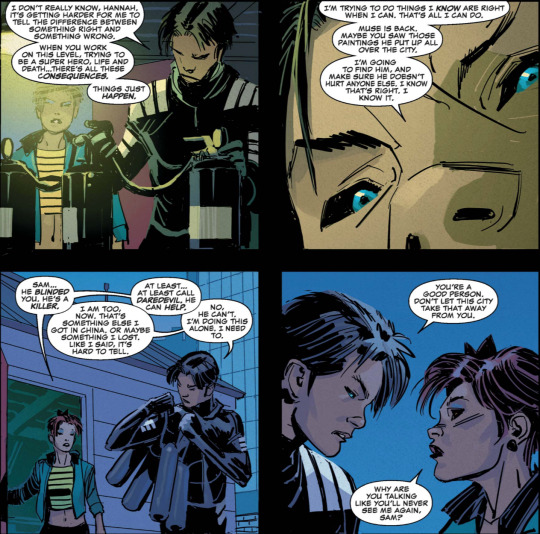
Sam: “It’s getting harder for me to tell the difference between something right and something wrong. When you work on this level, trying to be a super hero, life and death... there’s all these consequences. Things just happen. I’m trying to do things I know are right when I can. That’s all I can do. Muse is back. Maybe you saw those paintings he put up all over the city. I’m going to find him, and make sure he doesn’t hurt anyone else. I know that’s right. I know it. [...] You’re a good person. Don’t let this city take that away from you.”
Hannah: “Why are you talking like you’ll never see me again, Sam?”
Daredevil vol. 5 #599 by Charles Soule, Ron Garney, and Matt Milla
Sam’s journey is informed by the three main antagonists he encounters over the course of this run. One is Muse, who I consider to be the first member of Blindspot’s rogues gallery rather than an addition to Daredevil’s (how cool is that?!), one is the Punisher (who he encounters in DD/Punisher: Seventh Circle), and one is Tenfingers-- and by extension, the Hand. All of these challenge Sam’s superhero aspirations and force him to decide what kind of hero he wants to be. I loved Muse and Sam’s dynamic, and found the Hand a bit less compelling. (I really like the Hand, and they can be used well, but they lacked depth in this run.) But they are significant in shaping Sam’s character development, and they also tie into arguably the biggest theme of his origin story: family.
Sam wants to take Tenfingers down to save Chinatown-- but more than that, to save his mother. When he is blinded and grows disillusioned with hero work, his mother calls on the Hand to heal him and train him. Sam’s blinding is another weak area of his story. I would have found it more compelling if he had remained blind (this is Daredevil, after all!) rather than being magically healed right away. While having the Beast restore his eyes causes big problems down the road, it still feels like a side-step away from what could have been a much more interesting twist in Sam’s story. I was at least expecting the eyes themselves to cause him problems, since they’re obviously not normal eyes, but they never did. That whole story arc felt underdeveloped, which was disappointing. However! What really matters is that Sam’s time with the Hand challenges him in character-defining ways. They train him and turn him cynical about traditional superhero morality. His mother pays for the Hand’s help by promising her soul to the Beast, and to save her, Sam settles on a morally grey solution: trading her soul for Matt’s.
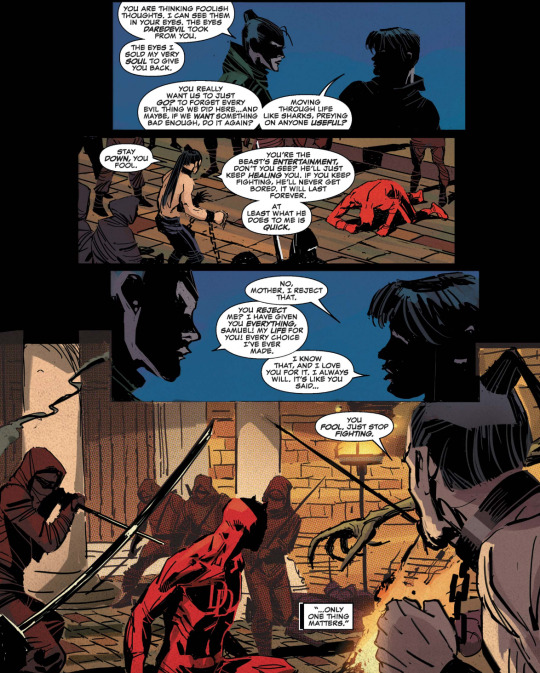
Lu Wei: “You are thinking foolish thoughts. I can see them in your eyes. The eyes Daredevil took from you. The eyes I sold my very soul to give you back.”
Sam: “You really want us to just go? To forget every evil thing we did here... and maybe, if we want something bad enough, do it again? Moving through life like sharks, preying on anyone useful? No, Mother. I reject that.”
Lu Wei: “You reject me? I have given you everything, Samuel! My life for you! Every choice I’ve ever made.”
Sam: “I know that, and I love you for it. I always will. It’s like you said... only one thing matters. Family.”
Daredevil vol. 5 #28 by Charles Soule, Ron Garney, and Matt Milla
Once again, this plot point is weakened by the lack of emotion in this run. We know that Sam’s relationship with his mother is complicated. She is a good person who has become ruthless as a way of protecting herself and her family from all of the difficulties in their life. Sam clearly loves her. But we don’t see enough of this relationship (or, for that matter, Sam’s relationship with his sister Hannah) to make this story as powerful as it should be. Sam is forced to choose between trading Matt for his mother or trying to save both, and despite his new cynicism and all of the pressures in his life-- from both his mother and the Hand-- to become a killer, Sam makes a heroic-yet-futile choice and tries to save both of them. This results in his mother’s death which, in spite of the lack of development mentioned above, is still one of the most powerful moments in the whole run.

Daredevil vol. 5 #28 by Charles Soule, Ron Garney, and Matt Milla
This serves as a turning point for Sam that carries over into the rest of the run. Despite everything he has been through and all he has lost, he decides that he still wants to be a compassionate person.
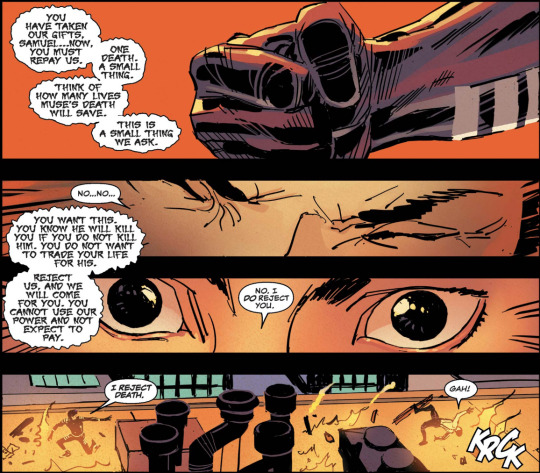
Beast: “You have taken our gifts, Samuel... now, you must repay us. One death. A small thing. Think of how many lives Muse’s death with save. This is a small thing we ask.”
Sam: “No... no...”
Beast: “You want this. You know he will kill you if you do not kill him. You do not want to trade your life for his. Reject us, and we will come for you. You cannot use our power and not expect to pay.”
Sam: “No. I do reject you. I reject death.”
Daredevil vol. 5 #600 by Charles Soule, Ron Garney, and Matt Milla
While Sam fades out of the story toward the end of the run (he didn’t get to meet Mike!) he plays a major part in battling the Hand when they attack New York. This restores his partnership with Matt, allows him to bring his animosity with both the Hand and Muse to a conclusion, and cements his image in the minds of the citizens of New York. Blindspot officially joins the ranks of Marvel’s superhero community, which-- for an undocumented immigrant who has grown up feeling displaced and unwanted-- means a lot.
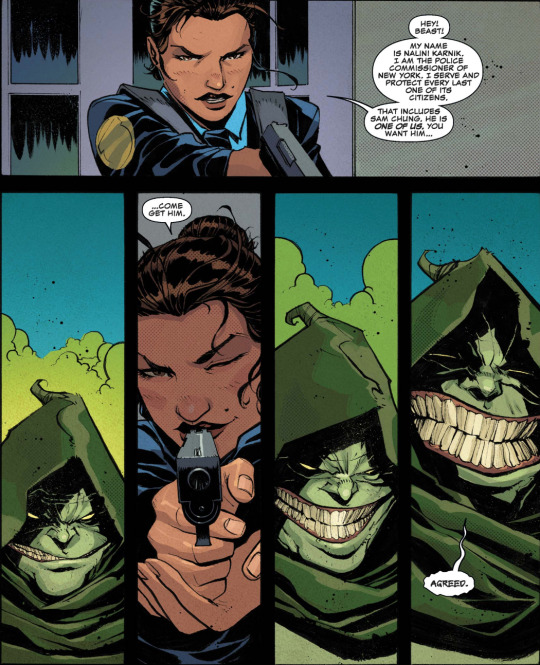
Karnik: “Hey! Beast! My name is Nalini Karnik. I am the Police Commissioner of New York. I serve and protect every last one of its citizens. That includes Sam Chung. He is one of us. You want him... come get him.”
Daredevil vol. 5 #605 by Charles Soule, Mike Henderson, and Matt Milla
This is hopefully only the beginning of Sam’s story, and I look forward to seeing him again-- both in future Daredevil runs, and ideally also within the wider Marvel universe.
108 notes
·
View notes
Text
I can’t believe people actually blame Peter for being bullied
Listen, I’m not gonna sit here and pretend Peter didn’t have a rotten temper and couldn’t have done something to improve his high school experience, at least after the bite, but I am sick and tired of people (read: witers) claiming that he was even as much as half to blame. Heck, depending on the period of time we’re talking about, the only way for him to fit in might have been to compromise most of himself. Partly, this is because almost everything we see of his life in high school (that wasn’t written decades later, with the baggage of modern ideologies) is from after the bite, whether it is from the original period when he was going to high school or . This is what we see in Amazing Fantasy #15, before Peter got his powers.
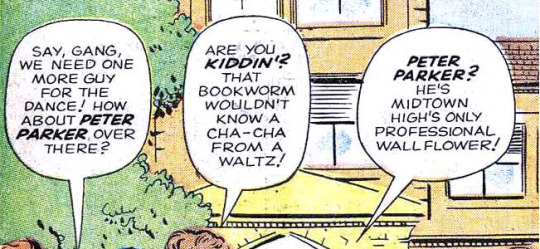
People who claim Peter was at fault for how he was treated say he was given many chances to join the group, but here we see how he’s only considered because they need him, and even then, when Flash says no, they discard him completely. (Yeah, the bubbles on the middle and right are Flash and Liz respectively.)
Also, Peter heard that. Just so you know. Even if later he is invited somewhere, you think he’s going to forget that this is what they really think of him?
“Well, but Peter could still have tried to change their minds!!! Even if they might not reach out to him, it doesn’t mean he should push them away!!! He should have given them a chance and they would have been friendly to him!!!!”


Yeah. So friendly.
But, hey, people who’ve read early comics and have seen Peter in action will say, what we say happened did, too!
And yes it did! Check this out!


They did invite him to stuff, didn’t they? Isn’t this what he wanted? He should be happy! What happened? Well...
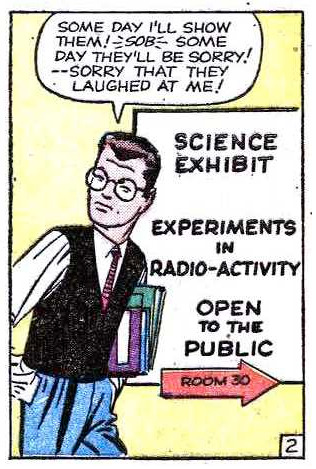
(Why is that picture so big?)
Some day arrived! And with it, Enough sense of self worth and dignity that Peter stopped chasing after people who didn’t want him there (and went on a power-trip that lasted him most of not all of his adolescence and so shaped him forevermore, but that’s a discussion for another time).
The next time we see him enteract with his peers is in ASM #1, in the third picture. Yeah, he really couldn’t go, and the others got a bit too pissed about his rejection considering he was only technically invited because the friend group probable consisted of most of the class. However, look at that face, he probably said it in a bitchy way. He was rejecting them, but why shouldn’t they, since they proved time and time again that they didn’t want him there, not even then, really, and wouldn’t even aknowledge that they treated him poorly?
Except. Except, out of nowhere people started being nice to him (I’m not discounting spider-hormones). That brunnette girl from the fifth pic? Actually called him Petey before Liz did, and, after Peter’s been defeated by Doc Ock for the first time, they’re just so nice to him, not even minding that he ignored them at first because he’s upset and distracted by the memory of Doc Ock bitch-slapping him, I guess. It wasn’t like that all the time, though.

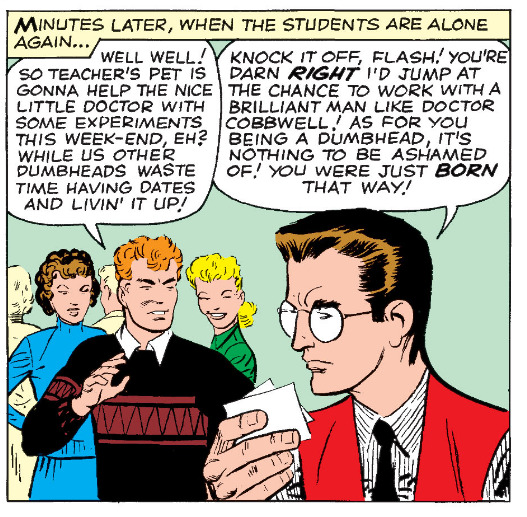
Like, there’s Peter, staying in his lane, when they come up to him to annoy him (his tendency to then key the other person’s car, metaphorically of course, notwithstanding). And like this, we can find plenty of other examples.
Sooo... What’s the truth?
Well, out-of-universe, it was kinda forshadowed by the fourth pic, here’s one more to make it clearer.
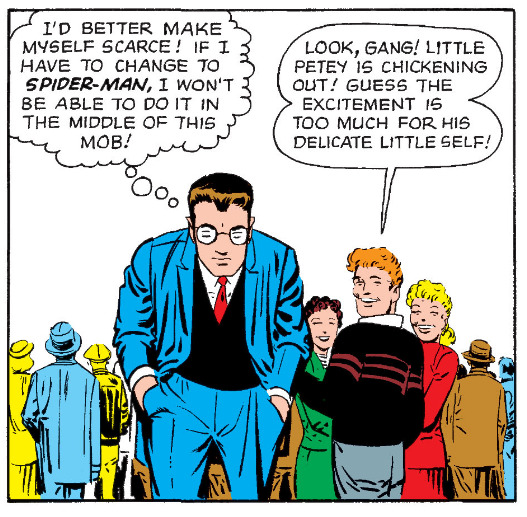
Misunderstandings. Peter will do some thing or the other that, because he’s Spider-Man, will be a sacrifice to him, but, to those who don’t know that, will only make him look bad. Can’t go to the Spider-Man show? It’s because he’s Spider-Man, but his classmates will think he’s just anti-social and sees himself as better than them. Has to leave a potentially dangerous group activity? It’s because he’s Spider-Man and has to be ready tosave people, but people will think he’s scared (which, by the way, was like a death sentence back then. If any of you time travel to the 60′s and someone calls you a coward, or yellow, punch them in the face. It will be the appropiate reaction). Doesn’t get to his meeting with Aunt May to reconciliate with her on time? It’s because he’s Spider-Man, and he had reason to suspect a murderous villain was about to attack, so he went after him, only to find a less efficient but even more murderous villain he had to fight, but his Aunt and her boyfriend didn’t know that, so they think he just doesn’t care about her. (This, by the way? Tends to happen with readers, too.)
It’s to show that being Spider-Man isn’t all fun and games, even outside of risking his life. That was the novelty of Spider-Man, the balance of super-heroism and day-to-day life, which would often get unbalanced. So, the purpose of having scenes where his classmates are nice to him was to show the sacrifices Peter had to make to be Spider-Man.
In-universe? It has to do with the exact kind of bullying I think Peter went through.
First off, I don’t think he was physically attacked. Modern (and by this I mean stuff from the 90′s forward) tend to go “oh, he was, bullied, ok, let’s roll”* and go with what their preferred version of bullying, especially that between a nerd and a jock, which is the jock beating the nerd up, but, except for one flashback from a school reunion annual from the 70′s, I think, we don’t have evidence of Peter being beat up, and the guys there weren’t Flash. Except for a few shoves, that one time he told Peter to meet him after school and that one time they arranged a boxing match (see what I mean when I say punching people in the face was an appropiate response? The teacher literally let them go into the ring and punch their mad off), Flash doesn’t seem to be physically agressive with Peter, although, to be fair, he does threaten him with violence often, and often the only reason they don’t fight is because Liz interrupts them. Like I said, though, this is from after Peter got his powers, and all those times he’s matching Flash step by step, so, maybe, he wouldn’t have dared to stand up to him before, so things wouldn’t have escalated as much (btw, this isn’t me blaming Peter, Flash is the one who keeps provoking him, Peter’s just... too damn easy to provoke after the bite).
Here’s what I think it was like before the bite:
His main bully was Flash, the rest followed his lead. It is a take on the kind of power and responsabilities that come from being popular. Flash, who has his own problems at home, takes it out on Peter because 1) he’s different. The issue which triggered this whole rant, WoS #35, said that his medal, even six years after he won it, was the only science award his school had ever won. This means not only that it will make it easy to find something to mock about him which will get others to join in, it’s also 2) unlikely someone else will orbit to him, someone who might not be so different and might defend him, and convince other to do so as well. 3) Flash is jealous, (certainly) because of Peter’s good relationship with his “parents”, (later on) because Liz will prefer him over Flash, and (probably) of his aptitude for academics, which isn’t only good in and of itself, it also gets him in the good graces of their teachers (like, in ASM #26, after Peter claims to have been the one to start a fight, Flash confesses it was him and the principal is ACTUALLY GLAD. IMAGINE). This probably mixes up with 1), because both of them have to do with approval from adults, which is something he would especially crave because his dad is an abusive asshole and his mom won’t defend him, while he’s liked and/or feared enough to be the most popular guy in school.
So, Flash picks Peter as his main target. Although he might get physically rough with him sometimes, when he thinks he’s stepping out of line (which for Flash would mean any and all attempts on Peter’s part to be included or liked, as shown in the pictures), I think that when he picked on Peter it was mostly verbally. However, it got out of hand because Flash was the most popular guy at school. He was the leader, so when he did something, people backed him up. Look at the first picture. The first guy innocently suggested that they ask Peter to join them in a dance, and Flash cuts him down immediately (granted, he’s probably right) and Liz, who’s the most popular girl, backs him up. No one’s going to go against them. Like, people have the right to dislike others, even if they’re not bad people, and Flash and Liz do, too. It’s just that, because they have social power, people will follow their lead, and Flash especially will usually go out of his way to pick on Peter.
Flash forward, however, and people start being nice to him. What happened? Well, they grew up (as much as a 15-17 yo is expected to grow). There is a group of guys who back Flash’s bullying to the end, but some others stop following him like sheep even before Liz decides Peter’s not that bad. So, some will be friendly to him, while some will still pick on him. Seems all in all allright, right?
Except it comes a little too late, because when Peter got his powers, in his mind he overcame what they’d convinced him were his short-comings, so he actually starts seeing himself as better than all of them. Up until that moment, what he’d seen was that the power that counted rested in strength and in popularity, (Flash was powerful, because he was popular, because he was strong - like, at that moment he wasn’t even the one who had to struggle with finances, his only problem was that he was ostracized at school and lonely) so when he became Spider-Man, a sensation because of his powers, he thought he’d become more powerful than them. In a way, it freed him from them, he didn’t have to ask anything of them anymore. I think it’s well explained in this panel, from after the FF wrongly accused him of being a criminal because the press said so (guilty of crimes other than breaking and entering into the Baxter Building) (and mild battery, although everyone participated in a bit of that. Actually, and without taking away from the fact that getting into the BB like he did was so dumb oh my god Peter you don’t do that, he wasn’t even the one who threw the first punch, he was mostly avoiding the FF’s attacks. Like, the exact count was one punch or shove to the Thing and one webbed hand to Reed).
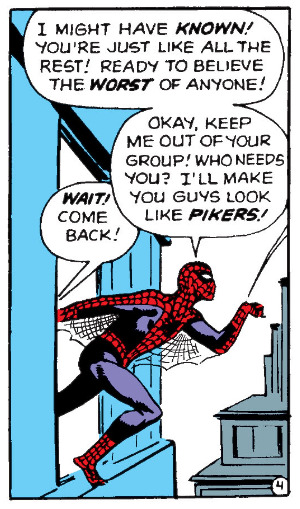
(WHY is it so big?)
... forgive him for being a drama queen, he’s fifteen, he’ll grow out of it, mostly.
But yeah, the first bubble? I suspect that, while it was all the negative press that pushed it out, he’s been thinking that about people for a long while. The second part, that came to be after he got bitten. He stopped seeking approval because he was convinced he could pave his own path, with his own power. However, he also stopped being receptive to approval, especially from certain people.
So, thinking of Peter’s bullying in high school as a cycle is faulty, since the first evidence we have of him even talking back when someone’s picking on him, let alone push someone away when they’re being nice, instead of actively seeking friendship, is after the bite, when his ostracization had already started. Actually, my memory might be faulty, but the only time he rejects an invitation to a group outing and it’s not because he has to be Spider-Man (which includes “I can’t go bc I have to do Spider-Man things” AND, as the ninth picture shows, “I actually came, but I have to leave now to do Spider-Man things”) is when Liz started crushing on him and invites him to party, and even Liz admits they had it coming. Actually, Liz is the only person shown to admit that their previous treatment of him was wrong, so she’s the only one (of the ones who actively mocked him, the rest were just doing their thing) who, in my opinion, deserved to be forgiven... and she was.
*Seriously, interpretations about how his life in high school nowadays are basically “well, Peter, you didn’t give them a chance when they tried to approach after years of isolation, how do you expect them not to mock you, belittle you, avoid you and tell their friends to do the same???” to “everyone in that school will grow up to be a psycopath, poor Peter, he gets beat up everyday by everyone” which is... also not something I agree with.
P.S.:Also, something for fic writers, understanding that everyone can do what they want, this is just a pet peeve of mine and I have no authority to stop anyone from writing anything. Just... I read a fanfic the other day, a high school AU, in which Peter had the same characterization as he did in the comics when he was that age, (or maybe even worse, because he was rude to Aunt May, which is... something Peter would never do??? Lie to her? Guiltily, yes. Accidentally hurt her because he’s Spider-Man so he keeps secrets and isn’t as reliable as he was once? Yeah, it’s been known to happen, but talk back to her???) even though he’d had friends all his life and just... no. Anger IS a big part of Peter’s character, especially when he’s younger, but a lot if not all of that comes from the fact that he’s been a victim for so long with no support system aside from his Aunt and Uncle. He is explosive, yes, so a bad temper would not be out of place, but he’s not naturally an asshole. Actually, and I’ve seen enough to know this is an unpopular opinion, while Peter might overreact a lot, he won’t actually bite someone’s head off just for looking at him funny. He’s actually not even the kind of person who’ll punch the wall between his apartment and yours when you've been singing loudly and off-key for several nights and keeping him from sleeping. Except in extreme circumstances, and though he might blow things out of proportion, he’ll go off on you only if you’ve poked him. If he’s going through bad times, the kind of thing that really weight on your mind even when you’re not actively thinking about it, yes, he’s the worst. Especially because one bad thing will affect him enough that either because he’s distracted or because he’s on edge, he’ll mess up with something else, and things will keep piling up on his plate, partly because he has a truly tragic life and bad luck, partly because he’s too overwhelmed about the things that are going wrong to fix or avoid what could go wrong next, and he’ll be snappy and rude and push people away accidentally or because he thinks he’s helping them, which will make things even worse. But, like I said, this isn’t normal. This is Peter Parker at his very worst.
We don’t see it much, because we’re reading only what will make a story, which is what has conflict, but a content Peter has been described as having a sunny disposition and being friendly as a puppy, and even when held and drugged against his will in a mental institution he’s (rightfully) suspicious of, his nurse describes him as gentle. Like, even if you want to say that it’s all tell and no show because it’s only what other characters have said of him, I’ll say 1) I said that we don’t see it often, not that we don’t see it at all and 2) a character is built by what they do, what they say and what others say of them.
There have been some huge misconceptions of the character, along the lines of MCU Peter Parker, but the course correction made it go too far to the other side.
6 notes
·
View notes
Text
found family asks
two in one, again:
maybe they only SAID it was about found family because they know its a very popular concept ... or possibly they really did want to write a voltron that was more sentimental and emotionally connected and kinda had absolutely no frame of reference for how to do so, unfortunately making it less connected than it was before.
... despite their frequently illogical way of doing things, Voltron would expect the exact same detachment out of Keith [as the BoM], maybe word it different, and only forgive failure to do so if it involved his blood family, the only family it's ok to refuse to let go of and behave irrationally for apparently.
I’ve had this discussion in DMs, and I think I might’ve mentioned in other posts. It all comes down to the fact that every story contains two stories: the one we set out to write, and the one we end up writing. And we do our best to make them as alike as possible, but sometimes it just doesn’t work out that way.
When you see EP/writer interviews, often what they’re speaking of is the story they intend to write. (This is true for most creators, I’ve found, especially in serialized stories like television or comics where the story’s still unfolding at the time of the interview.) It takes a lot of practice to see ahead of time that the story you’re actually writing has deviated from that intended version.
Very early on in S1 (and echoed in S2), we got the stated theme of found family. Shiro speaks of Cmdr Holt’s declaration that a team is like a family; at several points, Allura speaks of coming to see the paladins as her family. Plus, Pidge chooses the paladins (her found family) over breaking away to find her ‘real’ family, and Hunk describes them as ‘brothers’ after training together.
With the exception of Pidge’s actions, the other instances are what we’re told, and not necessarily what we’re shown. It’s the story establishing its thematic element early on, and telling is the easiest way to do that. But then the story has to uphold that by going silent on the telling, and instead showing us how this impacts the characters’ actions and reactions.
Unfortunately, what I see is a lot of... not really supporting this theme.
In Pidge’s case, she endangered Shiro, Lance, and Slav by being so distracted by potential information about her brother. Later, she effectively takes vacation from the team, mid-war, to do a walkabout to follow leads. And in S5, she again puts her found family’s goals at risk by insisting they sacrifice a useful prisoner so she can regain her ‘real’ family. Pidge’s entire arc has been focused all this time on her real family, and her found family comes second in every instance but that two-parter at the start of S1.
Neither Lance nor Hunk have had any conflicts that really pivot on the notion of family, found or otherwise. The one time we got Hunk pushing the team in any direction, it was for the sake of a quasi-love interest. Since almost the beginning, Lance rejected any siblingship with Keith, and has mostly focused (especially since S3) on Allura as a romantic, not familial, interest.
Most recently, there’s Keith, whose backburner search parallels Pidge’s; he heads off with Krolia for bonding time, and most of his discovery at that point is very much about his family. Keith’s interactions with his found family have been pretty brutal, for the most part. Lance’s bullying, Hunk’s micro-aggressions about Keith’s Galra heritage, Allura’s resentment and distrust that evolved into a rather high-handed tone in early S4. And, of course, the clone’s attempts to alienate Keith from the team, which worked well enough that the team never mentions Keith again, never appears to contact him, and frankly does just fine with him gone. There is no Keith-shaped hole left waiting for him, in his absence.
There’s Lotor, as well, who’s introduced in a dynamic that reflects the paladins, flanked by his own found family. Except he ends up slaughtering one in cold blood, somehow concocts and carries out a plan with a second while keeping the remaining other two in the dark, and eventually alienates all three again. And none of them ever seem to recall their dead teammate (though admittedly we did see them mourn Narti for about ten times as long as any of the paladins mourned Shiro). Instead, Lotor’s journey has mostly been focused on his parents: defeating/killing his father, and then acknowledging -- and rejecting -- his mother.
Or Allura, whose focus throughout has been on her father as a distant figure of admiration; in S5, suddenly she’s all about following in his footsteps, with the team’s priorities (y’know, that whole war thing) coming second. The team plays second fiddle to Allura's journey to master, and then use, the skills her father had.
And then there’s Shiro, who was the first to not only speak of teams (as people who work/decide together) but also of teams as a kind of family. After S2′s disappearance and that unfortunate timeskip, his found family (excepting Keith) neither mourns him nor looks for him, and in fact are remarkably flippant about the process of replacing him. It comes as no surprise that when the clone kicks into action, the team apparently writes the clone off, despite possibly months of co-existence and a number of successful missions. And, as someone else pointed out in a comment on a different post, despite having firsthand experience with brainwashing, when Hunk was controlled by the underwater critter in S2E2.
Frankly, these characters have created a rather shitty found family. Meanwhile, at least four characters’ journeys have pivoted on ‘real’ family, which undercuts the theme quite thoroughly.
The story the writers set out to create -- based on what they tell us, early on -- was a story of a team coming together, and creating a family between them. A family that’d stick together, sacrifice for each other, and put each other first. That’s not the story they’ve written, though.
What they’ve written is a story where five (well, seven) people are tied together by circumstance, whose focus remains pretty strongly on blood ties. It doesn’t matter whether the characters are discovering, affirming, or rejecting their familial connections; the focus remains on those ‘real’ families. Their found family consistently comes second.
I do expect that we’ll get some lip service along the way on the found family theme, but it’s a little late for the characters to be learning those lessons, now. We’ve passed the story’s midpoint; in another half-season (6-7 episodes), we’ll be entering the final act. Everything the characters need to know -- to defeat, well, whatever antagonist they finally face -- they should already know by now. They should have all the tools at their disposal, and it’s just a matter of girding their loins, picking up their weapons, and standing their ground.
If being found family is one of those weapons that’ll make them strong enough to win the day, I expect we’ll just be expected to swallow the story telling us this team is a solid found family. Even if that means we have to mentally retcon to fill the gaps the story created while it was busy focusing on ‘real’ family, and ignore all the times the characters chose in complete opposition of that intended theme.
This is yet another place I see a certain amount of inexperience in the creators. They knew enough to establish a theme, but not enough to see that it must be used as a continual guideline when tackling character decisions. I can go into how we can set up theme and balance it with character choices, but that’s probably best left to another post.
26 notes
·
View notes
Text
Chapter 5—Breaking the Cycle: The Substance-Dependent Client as Parent/Caregiver
Many adults with substance abuse disorders were abused or neglected during childhood. Although most do not abuse their own children, they are at increased risk of doing so (Kaufman and Zigler, 1987). When children who are victims of maltreatment become adults, they tend to repeat a dysfunctional cycle and often lack mature characteristics: the ability to trust, to make healthy partner choices, to manage stress constructively, and to nurture themselves and others (Magura and Laudet, 1996). In addition, substance-abusing women report higher rates of childhood sexual abuse than non-substance-abusing women, and these women report increased episodes of abuse from their adult partners as well. Domestic violence is a reality in many of these families (Browne and Finkelhor, 1986; CSAT, 1997b; Ryan and Popour, 1983). Research shows that childhood maltreatment has developmental, behavioral, and emotional consequences that continue into adolescence and adulthood. Researchers are now examining childhood abuse and neglect as an indicator of the potential for substance abuse (Feig, 1998; Felitti et al., 1998; Whitfield, 1998). For example, one study (Felitti et al., 1998) found that medical patients with adverse childhood experiences (i.e., traumas) had a higher incidence of health disorders, including problems with alcohol (7.4 times that of control patients) and problems with illicit substance use (from 4.7 to 10.3 times that of the controls).
Sheridan proposes a model of intergenerational substance abuse, family functioning, and abuse and neglect that reflects both the direct and indirect relationship between parental substance abuse and family dynamics, child and adult maltreatment, and second-generation substance abuse. She indicates that unless effective intervention occurs, there is an increased likelihood that these patterns will be repeated in the next generation ( Sheridan, 1995). Parental substance abuse presents not only a risk for intergenerational transmission of substance abuse disorders but also substantial risk for repetition of problematic parent-child interactions, including abuse and neglect (McMahon and Luthar, 1998). These studies indicate increased risk factors, and counselors should not assume that their clients with histories of child abuse are mistreating their own children. The family system may function well enough when stress is low. Substance-abusing parents are already severely hindered in their ability to provide a safe and nurturing home to their children (U.S. Department of Health and Human Services [DHHS], 1999); increased stressors such as loss of jobs, poverty, and illness will only exacerbate the situation.
Go to: Who Abuses and Why Nearly one fourth of physical abuse and more than half of sexual abuse of children occur at the hands of adults who are not the victims' birth parents. They may be other relatives, caregivers, or partners. The likelihood of this kind of abuse is far greater when parents are using substances and, consequently, cannot provide adequate care for and supervision of their children (Reid et al., 1999). However, because most child abuse occurs within families, the discussion here will focus on parents. Providers should also note that most child sexual abuse is committed by males (Finkelhor, 1994).Research on parenting styles and attitudes of abusing parents indicates several distinct characteristics shared by parents who abuse their children. These include seeing child rearing as difficult and not enjoyable, using more controlling disciplinary techniques, not encouraging the development of autonomy in children while maintaining high standards of achievement, and promoting an isolated lifestyle for themselves and their children (Briere and Elliott, 1994). Observational studies indicate that abusing parents are less supportive, affectionate, playful, and responsive to their children and are more controlling, interfering, and hostile; they have fewer pleasant interactions with their children (Magura and Laudet, 1996). Abusive parents tend to "parentify" their children, expecting them to take on the role of caretaker. Because they do not have sufficient knowledge of child development, their expectations of their children's behavior are often too high, leading them to adopt inappropriate disciplinary practices (Wegsheider, 1981). In fact, most abusing parents do not help their children adapt to the major developmental tasks, such as regulating their sleep habits, preparing them to separate from their parents, enabling them to explore their environment safely and with appropriate limits, and making choices and becoming more independent (Levy and Rutter, 1992; Mayes et al., 1997; Rodning et al., 1989). Nor do these families successfully resolve issues of attachment, emotional regulation, autonomy, peer competence, or school and work competence (Cicchetti and Lynch, 1993).Damaged Parents: An Anatomy of Child Neglect (Polansky et al., 1981) summarizes the characteristics of abusing parents identified by researchers in several different studies: The prevalence of poverty, substance dependence, mental illness, and large numbers of children per family Feelings of inadequacy and self-reproach, often related to early negative experiences Depression, difficulty putting sadness and needs into words, and anxiety discharged into activity Serious arrest in development, a sense of incompleteness resulting from a failure to internalize a separate identity (manifested by clinging to children), the presence of other abusive and unfulfilling relationships, and an inability to tolerate being alone A fear of taking responsibility and making decisions Severe difficulties in verbal communication Difficulty in seeking or obtaining pleasure Extreme narcissism, gross immaturity, dependency, and an impaired ability to empathize with a child's needs The Polansky study cautions against overgeneralizing neglectful or abusive parents. Also, it is important to remember that poverty may be a common characteristic because poorer parents are more likely than affluent parents to be involved in public systems, which are mandated to report abuse cases. (Affluent parents tend to access private systems in which reporting is not required.) Nonetheless, the development failures above can signal to a counselor both a potential risk for child abuse and the possible effects of maltreatment in a parent's past.At the same time, certain resiliency factors have helped many children avoid the cycle of abuse. These include being able to fantasize about another
time or place, being able to read and learn about a better time and place, realizing that they are not responsible for the abuse directed at them, and having an adult in their life for a considerable period of time who sees them in a positive way. Resiliencies can be grouped in the following seven categories (Wolin and Wolin, 1995): Insight begins with a sense that life in the troubled family is strange. Such insight can eventually protect the child from a tendency to internalize family troubles and feel guilty. Independence is the child separating herself from the troubled family. Relationships fulfill needs that troubled families cannot meet. Initiative is the desire to overcome feelings of helplessness that a child can succumb to in the troubled family. Creativity is the ability to take pain and transform it into something artistic and worthwhile. Humor allows the child to make the tragic into something comic and laugh at his emotional suffering. Morality is developing a set of principles that differentiates bad from good both inside and outside the family. Traditional models of parenting may serve as a useful context for understanding how a client views his own parents and the implications for repeating their behavior. The three major types of parenting styles have been described as authoritative, permissive, and authoritarian (Baumrind, 1971). The authoritative parent maintains reasonably close supervision, sets consistent standards, and keeps track of children without being overly directive. A permissive parent allows children to do as they please and sets few limits or guidelines, which may result in safety problems; this is often a neglectful parent. The authoritarian parent is directive and rigid and relies on punishment as a major disciplinary method; within this model, this is often an abusive parent. However, parents typically combine these styles when interacting with their children, and the effectiveness of the approach used depends largely on the family's culture, community, and environment.Paradigms from developmental literature can also be useful in understanding the effects of environmental disturbances on the maltreated child. Belsky's ecological model, for example, contains four levels of analysis: (1) individual development, (2) family systems, (3) community, and (4) culture, all of which interact with each other and influence whether or not maltreatment will take place (Belsky, 1993). As this model shows, alcohol and drug counselors must understand the broader context of the forces that influence clients and their families. In turn, the counselor can help clients sort through those forces--family, neighborhood, community, or culture--to gain a better understanding about what is and is not good within their environment. Causes and Context of Parental AbuseWhile most research has focused on repeat offenders, there is some knowledge and speculation about how certain dynamics and behaviors are integrated to shape an abusive personality. A common pattern of parent-child relationships is characterized by a high demand for the child to perform in order to gratify the parents and by the use of severe physical punishment to ensure the child's proper behavior (Pollock and Steele, 1972). Abusive parents also may be highly vulnerable to criticism, disinterest, or abandonment by their spouses or significant others, or to anything else that might reduce their already low self-esteem. These types of events produce a crisis of unmet needs in the parents who then expect the child to provide gratification. Unable to meet these parental expectations, the child is punished excessively (Pollock and Steele, 1972).This pattern of overly aggressive and demanding behavior is often rooted in the parent's own childhood. Many abusive parents report that they were raised in a similar way, and these
types of childhood experiences provide "lasting imprints" that are reflected in the way the adults feel about themselves and their children. More recently Dutton, in The Psychological Profile of the Batterer, has identified characteristics such as the presence of a "shaming father" and the need for children to be excessively mature as factors that contribute to the personality of the batterer (Dutton, 1995).
Go to: Role of the Counselor Alcohol and drug counselors can play an important role in helping to break the cycle of child abuse and neglect that often plagues their clients. Many times, parents who were victims of abuse or neglect as children express strong concern and anxiety about the possibility that their children may be abused. By working closely and empathically with a substance abuser, the counselor has the opportunity to break the cycle.To help determine whether a substance-dependent client is at risk for child abuse, the treatment providers should become familiar with the client's childhood--her parents' style of child rearing, family dynamics, possible traumas, and other events that may serve as a predictor for child abuse or neglect. At the same time, the counselor also needs to learn about the client's current family life, particularly parenting behaviors that provide some clues as to whether the client's children are at risk.This information--along with the counselor's awareness of a broad range of parenting situations, cultural backgrounds, systems, social supports, and treatment options--will enable the counselor to better assist clients and their children. Although counselors can play an important role in breaking the cycle of child abuse and neglect, they cannot do this alone. They are only one part of the continuum of care that is needed to break this cycle. For this reason, treatment providers will need to reach out and work with child welfare systems, school systems, child guidance clinics, health care providers, and others so that parents who abuse substances get the help they need and do not abuse or neglect their own children.While women with substance abuse disorders have often been the focus of interventions, breaking the cycle of child abuse and neglect also means including fathers who are at risk for neglecting or abusing their children, as well as significant others and family members who may share caretaking responsibilities. The recommendations offered in this section apply to all clients responsible for the welfare of children. Learning About the Client's ChildhoodA client's childhood can offer information that can be useful in understanding the nature of current family relationships. There are important issues that can be explored tactfully, without necessarily using specific psychology or health care vocabulary. Asking questions about these concerns in a respectful manner helps develop a good relationship between the client and counselor. Although a counselor cannot change the past, she can help the client find the strategies to improve her current situation and the strength to recover. Many of the questions that follow may be asked during assessment, but they can also be rephrased and asked again in treatment. These questions are merely guidelines that should be modified to fit the needs of each particular client. What do you know about the circumstances around your birth? What was your infancy or early childhood like? How did your parents describe you and those times? What was your relationship with your mother or father like? Tell me about any special times with them. Did anyone in your family (including aunts, uncles, cousins) use alcohol or drugs? Do you personally feel that they had an alcohol or drug problem? Did any family member ever undergo treatment for alcohol or drug use? Who raised you as a young child? Who was important to you when you were growing up? Did you have any serious medical problems when you were growing up? Were you ever in the hospital? How were you disciplined when you did something wrong? How did your mother, father, grandparent, or other caregivers reward you? Were your parents involved and interested in your life and activities? Did it feel like they knew what you needed and what was important to you? How did your parents show you their
attention, affection, and appreciation? (These questions will help to identify patterns of neglect.) As a child, did you like school? Were there any specific school issues regarding attendance, grades, or behavior? Did you graduate from high school? Did your family move a lot as a child? Did you go to several schools because of frequent moving? How well did you get along with your peers and teachers? What was the relationship between your parents like? Were they divorced or separated while you were growing up? Was there ever violence involved when they were upset with each other? How old were you when you started having sex? How many times have you become pregnant or impregnated someone else? How did you handle each pregnancy? Did you keep the child? Was a child protective services (CPS) agency ever involved in your life? Were you ever taken out of the home? Did you ever have a caseworker? Did anyone in your family ever have trouble with the police? Do you remember any particularly frightening experiences as a child? Did anyone in your family ever have an emotional problem, like depression? As a child, what did you do for fun? What do you do for fun now? Did you attend church regularly as a child? Did spirituality or faith play a significant role in some other way as you were growing up? How do you get along with your own children now? Could you describe any special times with them? These interviews should not be hurried. The counselor should make sure that the client is comfortable and that the meeting area is quiet and peaceful. Some questions or topics may need to be reserved for a later time when the counselor has developed a more trusting relationship with the client. (Besharov, in Recognizing Child Abuse: A Guide for the Concerned, provides guidelines for interviewing parents who are at risk or are suspected of maltreating their children that can be adapted by treatment providers [Besharov, 1990].) (See also DePanfilis and Salus, 1992.) Learning About the Client's Current Home LifeIn treating a client with children, the counselor will naturally learn how much of an impact parenting is having on the client's substance abuse. In the best of situations, parenting is stressful. For those whose own parents were not good models, it can be particularly difficult.Parents who abuse substances are not a homogeneous group. They have a range of experiences and a range of parenting skills (Howard, 1995; Tyler et al., 1997). Some of these parents have been abused and neglected during childhood. Others may not have been abused or neglected but have been raised by parents who did not have adequate parenting skills. Both groups have been exposed to poor models of parenting.Counselors are treating individuals with serious addictions that interfere with their normal daily activities and mental states. Taking illicit drugs requires parents to focus their energies on procurement. Parental priorities are not their focus; rather, the parents are focused on a need to care for themselves. Although the majority of these parents express feelings of caring and concern for their children, the addiction supersedes all other concerns. When under the influence of mind-altering drugs, such as cocaine and methamphetamine, parents are unable to foster whatever nurturing and sensitive parenting behaviors they may have.By having clients describe their current home life, the counselor can gain additional insights into their degree of risk for child abuse or neglect. Treatment providers should learn about clients' current supports (i.e., family, teachers, counselors), as well as whether they are having financial problems, living in substandard housing, or unable to pay rent or provide medical care for their children. Some specific questions that can be asked include the following: Who are the people or groups that give you
support? Do you have any special friends? Do you belong to a church, temple, or other religious or community organization? What type of social activities do you enjoy? How often? Have you been involved in the legal system? When? Have you ever been on probation? Who else lives with you at your home? Who else spends time there? Describe a typical week. What is your routine each day? On weekends? Describe your children's schedules. What do you do with them each day? On holidays? Are your children receiving ongoing medical care? Are their immunizations current? Through these and other questions, the counselor should get a sense of whether clients are at risk of neglecting or abusing their children. Socioeconomic and Cultural DifferencesIt is important that counselors not mistake class and cultural differences for child abuse or neglect. Many practitioners may not appreciate the limitations imposed by poverty and cannot distinguish between neglectful practices and those that are caused by lack of money and education. (Family problems of poverty may require referrals for cash assistance or concrete services for heat, clothing, or food.) For example, in some communities it is not uncommon for preteens to babysit infants. A seemingly disorganized house does not necessarily reflect uncaring parents. It is also important for counselors not to overreact to cases of social deprivation in poor families. While poverty may expose the parents to more risks for child abuse, most poor families do not abuse or neglect their children (
Go to: Clues That the Client May Be Endangering Children In certain treatment settings, such as day treatment centers with child-care services, the counselor may have the opportunity to meet the client's children. Such direct observation can be beneficial in several ways. First, the counselor can see firsthand how the client relates to his children: How does the client react to his children's behavior? How does he respond to his children's emotional needs? Do his children make eye contact with him? How does he respond to the children's crying? How does he praise and discipline his children? Are his expectations age-appropriate? With this information, the counselor can assess the client's parenting style. Some warning signs that these children are in danger of abuse may be obvious, such as a parent hitting a child. Other behavioral signs may include a child's yelling, screaming, not being able to sit still, flinching easily, or attaching indiscriminately to others. Regression to an earlier developmental stage is not uncommon. For example, a child who had been toilet trained or able to separate well from the parent may suddenly be wetting her pants or clinging to her parent. The counselor should be mindful, however, that these behaviors might indicate developmental problems, such as attention deficit/hyperactivity disorder. Whatever the case, the child should be referred to a health professional.The counselor will also have an opportunity to check for any signs that could result from physical abuse or neglect. The counselor can see if the children are underweight for their age or if they are unkempt. The counselor can observe whether the child has any exposed bruises, cuts, or obvious fractures. The counselor can then ask the client to explain why the child is underweight or injured. If the client's explanation is suspicious and the story does not fit the child's physical status or injury, then the counselor would have cause to report this to a CPS agency (see Chapter 6).In most treatment settings the counselor does not have the opportunity to meet the client's children. Over time, however, the counselor will learn more and more about the client. In an unguarded moment, the client may begin describing parenting behavior that is not appropriate. The client may also share something in group or via writing exercises. Figure 5-1 lists some examples of poor parenting behavior that could lead to child abuse or neglect. 📷 BoxFigure 5-1: Behavioral Clues That Suggest Possible Child Abuse or Neglect. Name calling, verbal abuse, negative or belittling labeling of the child Stories that suggest children are living in unsafe conditions (e.g., spoiled food, (more...)In situations where poor parenting is indicated but the client does not appear to be abusing or consciously neglecting the child, the treatment provider will need to direct the client toward those agencies and services that can help her become a better parent. At the same time, the counselor can talk about and reinforce good parenting practices.
Go to: Incorporating Treatment Strategies for Child Abusers Breaking the cycle of abusive parenting means understanding the background of the parent within the context of the family, neighborhood, and culture. When parents who abuse substances recall their own childhood, they often report deprivation in many areas--emotional, social, physical, and economic. If these parents recall histories of severe neglect or abuse during childhood and adolescence, the counselor can assume that most have missed out on opportunities to form healthy, trusting relationships with their caregivers and have not experienced a model of parenting that included a consistent, nurturing environment with appropriate roles and boundaries. The first thing substance-abusing parents typically need to focus on is how to build positive relationships with their children. Because many clients' parenting skills and styles reflect what they have experienced, they will be at an increased risk of parenting inappropriately, and some within this group will abuse or neglect their children. Most of these parents want to do the best for their kids--they just don't know how. Therapists should support their clients' desire to become better parents and assist them in identifying parenting support programs.Just as counselors can expect that substance-abusing parents often will deny their substance abuse, they can also expect parents to deny neglecting or abusing their children. The challenge for the counselor is to help parents understand that their parenting behaviors may not be appropriate and that these behaviors can negatively influence their children's future development, especially their ability to trust others and to develop self-esteem and pride about their lives. When parents lack a reference point--that is, good parenting models--they will need help in Recognizing the importance of appropriate parenting behaviors Seeking help to become better parents Identifying others who can support them over time as they parent their growing children Understanding how current abuse of substances affects responsible parenting At the same time, the counselor must not forget to articulate the positive aspects of the clients' experiences. Focusing on the negative or risk factors only results in shame and futility and is counterproductive. Increasing clients' self-esteem and self-efficacy (their effectiveness and ability to take responsibility) is a primary step to their understanding of the child-rearing role. Thus, it is important for the counselor to praise clients when they act according to appropriate parenting behavior--and point out that this shows they do have the qualities of a good parent within them. This will develop a trusting and helpful relationship with these clients. It will also help them break the cycle of shame by offering some strategies of hope.Indeed, there is evidence suggesting that substance-abusing parents are aware that their parenting strategies may be counterproductive and worthy of change (Hawley and Disney, 1992; Levy and Rutter, 1992) and that they are highly concerned about the well-being of their children ( Grossman and Schottenfeld, 1992; Tunving and Nilsson, 1985). The counselor's relationship with clients also provides a positive model for the client of what constitutes a helping relationship. Consciously or unconsciously, clients may adopt techniques they experienced as significant in their own therapy when interacting with their own children--reflective listening, setting appropriate boundaries, treating others with respect, and providing encouragement and positive reinforcements, among others. What Abusing Parents Should LearnTo raise a child in a nonabusive and nonneglectful manner, it is important that parents have the basic knowledge and skills needed, including the following: Realistic knowledge about child development Parenting
skills An understanding of the impact of child abuse on a person Good relationships with spouse and other adults Other personal development and social skills development Treatment programs should establish guidelines on how to deal with these issues if they arise during counseling and know when to refer clients for appropriate types of intervention and support, such as child development and parenting specialists. Additionally, there are many types of support groups available for parents and children involved in abusive relationships. Parents Anonymous, for example, is intended to help adults who abuse children. Parents Anonymous also targets families who have been involved in incest and attempts to keep these families intact or reintegrate families that have been divided because of incest. Alateen, another 12-Step group, is designed for older children whose parents are alcohol dependent and who may be at risk for abuse. Realistic knowledge about child developmentParents should understand the stages of child development and the expectations reasonable for children at specific ages. (An organization in Washington, D.C., called "Zero to Three" [see Appendix E] develops materials, including posters and wall charts, for parents and child care practitioners that define and explain key stages in the development of children from birth to age 3.) Abusive parents often believe that very young children (i.e., 2- or 3-year-olds), can stop crying on command, take care of themselves, and respond maturely to the caregiver's needs (Peterson et al., 1996). Parenting skillsAt-risk or abusive parents probably need help in basic child-rearing skills, such as how to use effective disciplinary behavior, how to reward, and how to effect desired responses. An understanding of the impact of child abuse on a personA number of resources are available that can help clients learn about the consequences of child abuse. "Choices" is avideotape produced by the Center for Substance Abuse Prevention that features interviews with parents who were victims of child abuse. The Public Broadcasting Service has produced several special programs on child development that are available on video. A book of therapeutic stories, such as Once Upon a Time: Therapeutic Stories To Heal Abused Children (Davis et al., 1990), which can help heal the damage of abuse, can be read to children or given to parents to read. If adults at risk for abusing children were also victims, they should understand why they were abused (e.g., their own parents did not know about child development stages) if they are not to become abusers themselves. Good relationships with spouse and other adultsA mother's satisfaction with her spouse and her sense of support from friends and from the community contribute greatly toward a positive attitude about parenting. Strengthening these relationships helps to increase the possibility of improved maternal caregiver behavior (Belsky, 1984) and may prove helpful for fathers as well. Developing interpersonal skills is an issue that can be addressed in therapy and also in marriage counseling. Other personal development and social skills developmentThese include stress management, assertiveness training, and the development of self-confidence. Learning such skills as managing stress and knowing how to deal with anger may lower the risks of abusing a child. Selecting the Most Effective Treatment ProgramData suggest that interventions aimed at breaking the cycle of substance abuse, child neglect, and maltreatment are more successful when they are family centered (Magura and Laudet, 1996). Critical services that may need to be provided for parents who abuse substances include Access to physical necessities, such as food, housing, and transportation Medical care Counseling on substance abuse prevention Training on parenting and
child development Training in child care techniques (bathing, holding, packing a diaper bag, giving medication, etc.) Social services, social support, psychological assessment, and mental health care Family planning services Child care Family therapy and health education Life skills training in such areas as financial management, assertiveness training, stress management, coping skills, home management, anger management, conflict resolution, and communication skills Educational and vocational assessment and counseling Training in language and literacy Planned, continuing care after program completion If clients are to receive appropriate help, it is essential that the treatment match their current abilities to function rationally and to be good parents. Other factors, such as clients' social class, culture, and resources, must also be considered. By addressing these issues, counselors can place clients in community-based treatment programs that address their clients' particular needs. For example, it is important in family therapy to plan what will be discussed when children are involved. The family therapist will understand the developmental needs of the children and, when appropriate, will provide information to the children about the nature of substance abuse, dependency, and treatment. The recovery process of clients can also be addressed.Parenting classes and support around parenting, recovery, and parent-child relationships can be explored. This can be based on the licensing and credentials of the counselor. Usually in early recovery, family education and counseling around recovery is helpful. Later in recovery, more in-depth family therapy may be called for, and a systems approach can be taken. However, when domestic violence is occurring, a systems approach is counterindicated. When a CPS agency is involved, a team approach that coordinates treatment plans is essential. See TIP 25, Substance Abuse Treatment and Domestic Violence (CSAT, 1997b) for more on this issue.Clients with children will fall into two general categories: those with custody and those without. At intake, the treatment provider should find out which situation pertains to a client. To give appropriate guidance for both groups, the counselor should learn the following about the client: Current substance abuse (and means of procurement) Substance abuse by a significant other who may be involved in child abuse or neglect allegations Treatment plan to reduce substance abuse History of deprived childhood History of child abuse and neglect History of involvement with CPS agencies or court system History of out-of-home placement Attitudes about parenting, knowledge about child development, and awareness that parenting tasks change depending on the age of the child Standardized screening measures are available to provide a second source of information on clients' attitudes toward parenting and potentially problematic areas: The Parental Acceptance and Rejection Questionnaire (PARQ) discussed in Chapter 2 has an adult version completed by the parent about her relationship with her child as well as a child version completed by the child about his parent. The Parent-Child Relationship Inventory (PCRI), also discussed in Chapter 2, is another instrument that can help clinicians explore their clients' potential problem areas in parenting. Treating parents with custodyStudies show that the overwhelming majority of minor children affected by parental substance abuse remain in the custody of their parents (Feig, 1998). When dealing with parents who have custody of their children and who have reported a past history of deprivation, neglect, or abuse, the counselor will need to determine the safety of the children and the support available to the client. Some clients may not have custody of their biological children but are living
with or dating someone who does and therefore has a caregiver role. At intake, the counselor should make clear to a client that she is concerned about the client both as a person with a substance abuse disorder and as a parent with certain responsibilities. The counselor needs to state from the beginning that both the client's and the children's safety are of utmost importance. To understand the situation better, the counselor will need the following information: The children's daily schedule and the adults involved in their care or supervision The children's current health status The client's involvement with other agencies, such as family preservation, back-to-work, and job training programs The role of a significant other in the care of the children, his attitude toward the children, and any previous history of abusive or neglectful behavior toward children Previous or ongoing involvement with CPS agencies, the reasons for involvement, current child protective system plan, and outcomes from previous involvement with CPS agencies Once this information is obtained, the counselor should determine the client's daily and weekly activities. This is important in understanding the stresses and tasks required of the parent. For example, a client is likely to relapse or escalate drug use if she senses failure or experiences frustration. Therefore, the counselor must help the client to prioritize her responsibilities and tasks, and recognize the need to identify supportive help when possible.One approach that the counselor may want to consider is to place emphasis on safety. The two words "safety first" can be used to guide all discussions about a client's approach to her daily tasks. By prioritizing tasks based on the parent's and children's safety, the counselor can focus clients on immediate action in a way that is positive and nonaccusatory. By framing the discussion this way, the counselor can help parents understand that it is a safe strategy to stay away from drugs; it is a safe strategy to make sure their children are in the care of a clean and sober adult; it is a safe strategy to make sure that their children attend Head Start or school; it is a safe strategy to keep children's immunizations up to date (Rubin, 1998).Over time, the counselor will become familiar with a parent's treatment attendance record, the results of random urine toxicology drug screens, and the children's activities and can thus get a sense of the stress and risk factors in the client's life that might lead to abusive or neglectful behavior. The counselor also will learn about the parent's ability to organize a daily schedule for his family and himself, follow through on responsibilities, and acknowledge when these responsibilities may be too daunting. When a crisis in a client's life seems imminent, the counselor will be better prepared to help the client reexamine his priorities and consider, once again, a plan that will provide safety for the children and for him. Treating parents without custodyCounselors will often treat clients who do not have custody of their children. This group of parents presents some issues that are different from those parents who do have custody. The counselor's initial major concern is not about the safety of the children. Instead, it is about the safety of her clients, addicted parents who need to focus on being sober and on reuniting with their children in a timely manner. The counselor should learn about The CPS agency's plan for family reunification and the schedule to complete this effort The specific requirements for family reunification, such as the time allowed clients to begin abstinence from or reduction of substance abuse, the visitation schedule with court-appointed caregivers, and completion of parenting classes Age, health, and general
developmental needs of each child Client's history of loss of custody of children and outcomes Client's history of drug or alcohol treatment and outcomes Client's current drug use, health status, income, and housing situation Client's history of childhood deprivation, neglect, or abuse With the recently legislated fast-track adoption laws and the requirement that courts establish more rigid time lines for family reunification, treatment providers must help the parent to prioritize the tasks that should be done for a successful outcome. For example, the client who acknowledges he must change his substance-abusing behavior to become reunited with his children is setting a priority toward successful family reunification. The counselor must then help the client proceed with this goal, recognizing that as time goes by other issues will need to be addressed and be included in the tasks that are required for family reunification, such as improving his parenting skills, finding appropriate housing, learning about financial planning assistance, and searching for work.For family reunification to occur, it is critical that the alcohol and drug counselor collaborate with the CPS agency professional to develop a realistic plan for family reunification. Together, they must ensure that the parent is not overwhelmed with too many tasks at one time. Moreover, the counselor must carefully consider the timing of referrals to the appropriate professionals or community-based programs so that the court timeline for family reunification is taken into account. Treatment SettingsMost substance abuse treatment settings do not have the resources to handle both substance abuse and ongoing child abuse concerns. Interagency networks and agreements can be most effective in these cases. Such cooperative arrangements should include a unified system of case management and clinical review. Following are a few selected programs in the United States that have incorporated both issues under one roof, which can serve as models for creative program development in other communities. The recent study, No Safe Haven: Children of Substance-Abusing Parents, (Reid et al., 1999) also reviews some examples of innovative combined services. Residential programs for womenResidential treatment programs can be exceptionally productive because of the way many women deal with the world. Research suggests that a woman develops in the context of relationships, rather than as an isolated individual (Surrey, 1985). In this model, where relationship and identity develop in synchrony, a woman's role as mother is intrinsic to her personal growth and serves as a motivation to facilitate treatment. Depriving her of children and other personal relationships can be detrimental to recovery. Parental Awareness and Responsibility (PAR) VillageLocated in Largo, Florida, this program admits cocaine-dependent women into a therapeutic community with children younger than 10 years of age. As many as 14 women live in separate residences with their children.Begun in 1990, PAR Village was originally a research project funded by the National Institute on Drug Abuse (NIDA) to answer the basic question, "Will women stay in treatment longer as a result of keeping their children with them while in treatment for their substance abuse problem?" Women were randomly assigned to one of two treatment programs: one with their children and one without. Results showed that women who entered treatment with their children stayed longer, completed treatment more often, and had more positive outcomes (especially in retaining or regaining custody of their children) than their control group counterparts. As a result, PAR applied for continued funding through CSAT to allow the program to continue its successful treatment models (Coletti et al., 1997).While
in treatment, both control and experimental groups were provided with group and individual counseling, educational and vocational training, parenting and life skills training, medical services, substance abuse education, and relapse prevention. In the original NIDA study, results indicated that positive outcomes increased when women came to treatment with their children. The experimental group had significantly longer lengths of stay. In fact, at 6 months, 65 percent of women with their children were still in treatment, compared to 18 percent of the control group. Posttreatment custody also improved. Half of the women who came to treatment with their children retained or regained custody of their children at the 6-month posttreatment followup, compared to none of the control group. The SpringThis long-term residential program in Carlsbad, New Mexico, is designed for female substance abusers who have children. This intensive and structured treatment program incorporates psychological, social, educational, vocational, and spiritual aspects of treatment and provides support services for the residents' children and adjunctive family treatment. Each resident shares a private room with her children. The children attend school or day care, and mothers go to classes. Children receive testing and counseling, and mothers care for their children. The comprehensive residential program consists of a broad range of activities, including 12-Step meetings, classes, and therapy groups. Village South Families in Transition (FIT)This residential program for women in Miami, Florida, is funded by CSAT and the Ounce of Prevention Fund of Florida. The program allows residents to bring up to five children, from newborns to age 12, to live onsite for 18 months. The FIT program also provides services to adult significant others and nonresidential children. The program includes an onsite child care center, primary health care and support services, drug intervention and prevention services for mothers and children, and counseling on job and life skills, parenting, and mother-child relations. There are family visits and weekend visits, and partners and other family members are involved. If a mother relapses and has to leave, the village can maintain joint custody of the children, and the mother can regain custody later. Day treatmentAlthough residential treatment centers have many advantages, parents may find this type of facility disruptive for family members, especially for older children who would have to change schools, lose contact with friends, and have less access to extended family. For many parents, intensive, family-oriented outpatient and day treatment programs are a more feasible alternative. Family Rehabilitation Program (FRP)Launched in 1990 by the New York City Human Resources Administration-Child Welfare Administration, this program targets mothers with newborns exposed to drugs (often cocaine) identified by the child protective system. It attempts to prevent the need for foster care of newborns and enable the families to provide for the long-term development of infants and other children. The primary client is the substance-abusing mother, who is offered both substance abuse treatment and intensive social services aimed at preserving the family unit. Services are provided through contracts with community-based volunteer groups selected to provide culturally sensitive services, including home-based visits. Unlike many family preservation programs, which are limited to 60-day interventions, FRP clients participate in services for about 1 year (Magura and Laudet, 1996). Project ConnectThis project is an effort to respond to the needs of both parents and children. It is a collaborative effort between a State department of child welfare, a
private nonprofit agency, a school of social work, and a number of substance abuse treatment and health care agencies. Its goals are threefold: to reduce the risk of child maltreatment, to keep families affected by substance abuse together, and to increase the capacity of the local service system to respond effectively to the needs of these families. Funded by a grant from the National Center on Child Abuse and Neglect, Project Connect is administered by the Rhode Island Center for Children-at-Risk in Providence and operates under contract from the Rhode Island Department of Children, Youth, and Families (Olsen, 1995). Families receive services for about 10 months in this program. Project SAFE (Substance and Alcohol Free Environment)Begun in the mid-1980s by the Illinois Department of Children and Family Services and the Department of Alcoholism and Substance Abuse, this program focuses on poor urban minority women with children. In this program, caseworkers identify women who have been accused of child neglect or abuse and have screened as high risk for substance abuse. Project SAFE takes a proactive approach by intensively recruiting women into the program. Once clients are in the program, the outreach caseworker calls clients daily, offers transportation, and helps to arrange child care throughout intensive outpatient treatment (Boundy, 1998). (For additional information on Project SAFE, see Chapter 7.) Relational Psychotherapy Mother's Group (RPMG)RPMG is a weekly parenting group offered along with substance abuse treatment. RPMG concurrently addresses mothers' unmet psychosocial needs and parenting deficits using a nonjudgmental and supportive therapeutic stance, emphasizing interpersonal relationships with adults and children, and employing a guided-discovery approach to exploring parenting and interpersonal deficits. During a 3-year pilot study, RPMG was tested as an adjunct to standard treatment offered in methadone clinics in New Haven, Connecticut. Compared to mothers receiving standard treatment alone, mothers receiving the supplemental RPMG were at lower risk for maltreating their children, reported higher levels of involvement with their children, and greater parental satisfaction overall. At 6-month followup, in addition to sustaining their gains, the RPMG mothers were less likely to use opiates than comparison mothers. Children of RPMG mothers also showed healthier levels of psychosocial adjustment than children of comparison mothers (see Luthar and Suchman, 1999 and in press). Incarcerated parents and parents in transition from incarcerationTypically, substance abuse treatment programs in jail or prison settings will limit the presence of children. However, some criminal justice and social service professionals believe that children should have the opportunity to visit their parents in jail. Children typically want to see and talk to their fathers and mothers. Two programs in New Mexico provide such family services. Project IMPACT, at both the Central New Mexico Correctional Facility in Los Lunas and the New Mexico Women's Correctional Facility in Grants, reviews parenting skills of inmate fathers and mothers and provides education programs, counseling, and family visits. The program eases transition back into daily family life and provides community services to inmates' children and spouses during their incarceration. A second program in New Mexico, Comienzos, which means "beginnings," is an education program at the Bernalillo County Detention Center that provides education on parenting, family violence, and related topics. In these cases, professionals found they could motivate parents to become involved in the substance abuse treatment programs while in jail if they had contact with their children. The
California Department of Corrections and the Department of Alcohol and Drug Programs support a prison-based program called Forever Free from Drugs and Crime. Forever Free participants live in a separate 240-bed facility and receive treatment 4 hours a day, 5 days a week. Counseling, relapse prevention, and problemsolving and parenting classes are part of the curriculum. For more information, call the California Department of Corrections Office of Substance Abuse Programs at 916-327-3707. For more information on substance abuse disorders and criminal offenders, see TIP 30, Continuity of Offender Treatment for Substance Use Disorders From Institution to Community (CSAT, 1998b).
Go to: Organizational Roles and The Need for Collaboration In treating adults with substance abuse disorders who are suspected of abusing or neglecting their children or who are already involved in the CPS system, counselors must communicate and collaborate with representatives from CPS agencies, all while keeping the best interests and confidentiality of clients and their families in mind. Counselors also must understand the role of juvenile, family, and criminal courts in prosecuting cases of child abuse and neglect. Every system attempts to accomplish a specific set of goals to help further the well-being of clients and family members. However, the philosophies and processes used may be very different, and the potential for conflict (expressed or unexpressed) among agency representatives is great. It is important to find ways to collaborate with other agencies in a manner that builds and maintains trust--while continuing to adhere to Federal confidentiality laws. Figure 5-2 presents some suggestions for ways in which professionals from the child welfare and treatment fields can collaborate more closely. 📷 BoxFigure 5-2: Strategies for Collaboration. Program planning and administration Provide joint training for substance abuse treatment staff and CPS agency workers Develop team staffing approaches Provide joint funding (more...) Core Functions of a Child Protection System: The Center for the Future of Children (Schene, 1998, p. 36). Respond to reports of child abuse and neglect, identify children who are experiencing or at risk of maltreatment. Assess what is happening with those children and their families--the safety of the children, the risk of continued maltreatment, the resources and needs of the parents and extended families, and their willingness and motivation to receive help. Assemble the resources and services needed to support the family and protect the children. Provide settings for alternative or substitute care for children who cannot safely remain at home. Evaluate progress of the case during service provision and assess the need for continuing child protective services. Role of Treatment ProvidersThe main focus of the treatment provider is to provide interventions and support to help clients with their substance abuse and dependence issues and recover from the physical, psychological, emotional, social, and spiritual harm that their substance abuse has caused themselves and others. However, once child abuse or neglect is known or suspected, legal constraints take precedence because counselors are mandated to report cases to CPS agencies. It is not the role of the treatment provider to investigate child abuse; once the report is made, the provider's clinical attention should shift back to and remain with the client.It is important for counselors to let clients know from the beginning that counselors must report suspected abuse and neglect because the law requires them to do so. However, the accompanying message to the client should be that even if a report is made, the counselor will continue to work with the client, providing treatment and support. (Counselors should emphasize that it is in a client's best interest to address abuse issues before a child is harmed and before a client has jeopardized her parental rights.) For clients who have been reported, an extra measure of support may be necessary. For example, although counselors' large caseloads would preclude them from routinely accompanying clients to court, exceptions could be made for some clients.Even when accompanying clients to court is not possible, the counselor can create strategies to address the upcoming court date and related issues in treatment. For example, clients who abuse their children often have their own abuse histories and may have painful memories
of having to appear in court as children to be placed in foster care. Discussing such memories with clients may prove valuable to the treatment process. Helping clients understand the court system and procedures may also strengthen the therapeutic bond. The role of the alcohol and drug counselor often involves teaching clients self-advocacy and communications skills--that is, helping them learn to approach various systems in ways that will produce fruitful results that meet their individual needs. Role of CPS AgenciesEvery State has a CPS system to investigate reports of child abuse and neglect to determine whether the child in question is in danger and to intervene if necessary. The CPS agency initiates a comprehensive assessment of a child's safety and well-being in the family. The assessment can involve interviews with the child, the parents, and other family members; visits to the home to evaluate the environment and family dynamics; contacts with schools and other service providers who are or have been involved with the family; and testing to assess the child's health and development (see Kropenske and Howard, 1994). CPS investigations, foster care placement, and adoption services are different aspects of child welfare services, but these functions are organized and titled differently in various States and municipalities; in smaller (i.e., local) jurisdictions, roles and responsibilities may often overlap.If the CPS agency determines that a child is (or is at risk of being) neglected or abused, it can initiate family preservation services to remedy the problems (see Figure 5-3). The CPS worker is responsible for developing a service plan to help the family improve in those areas the assessment found lacking. The service plan can cover housing, day care, transportation, clothing, food stamps, parenting training, individual or group counseling (including substance abuse treatment), and teaching the parent basic household skills. These services may be provided while the child remains in the home if the child's safety can be assured, or the child may be removed to foster care while services are provided. 📷 FigureFigure 5-3: Overview of Steps Through the Child Protective Services and Child Welfare Systems.When it is determined that a child is not safe in the home, the CPS agency has the authority to remove a child temporarily and place the child in another living situation, such as foster care or with relatives (i.e., kinship care). Relatively few children are actually removed from their homes (in 1996, children placed in foster care represented 16 percent of CPS cases), and most of those removed are returned to the parents' custody fairly quickly once their safety has been assured (DHHS, 1999; Goerge et al., 1996).Children who are placed in out-of-home arrangements must wait for the legal system's procedures to take place before a final plan of family reunification or other permanent placement is completed. This plan generally focuses on reuniting the family while ensuring the child's safety and may include substance abuse treatment for parents, as well as other services. The plan and progress toward it are reviewed periodically by the court, and it must be demonstrated to the judge that efforts are being made toward the achievement of the planned goals. Recent Federal legislation mandates that permanency plans be determined quickly and that a permanency hearing be held within 12 months of adjudication of the abuse or neglect. If the child remains in foster care for 15 of the most recent 22 months, the jurisdiction must start the process of terminating parental rights and developing a plan for adoption or kinship care for the child.CPS agencies are required to investigate all reports of child abuse or neglect within a short time--generally a week. Unlike other public
service agencies, they cannot generate a waiting list when service needs outstrip resources. With increasing reports of maltreatment in recent years, backlogs of uninvestigated cases have grown, and CPS agency caseloads have soared. Many workers are assigned more than 50 families even though standards developed by the Child Welfare League of America (CWLA) call for caseloads of no more than 12 to 17 families (CWLA, 1989; Daro and McCurdy, 1991; Reid et al., 1999). Role of the CourtsThe juvenile or family court judge has several placement options, which vary slightly by State. These are reunification with parents, adoption, or guardianship (often with a relative). Children aged 16 and above might enter an independent living program. After reasonable efforts are made at reunifying the child with the family within the timeframe stipulated by law, the court can terminate parental rights and free the child for adoption. Juvenile and family courts have heavy caseloads, and judges sometimes hear a new case every 15 minutes (General Accounting Office, 1999).Some child abuse perpetrators are charged in the criminal court, which is generally more crowded and slower than the family court system. In some cases, families may be involved with both courts. In those cases, the juvenile or family court judge may decide to delay a decision about a child placement case until the criminal court acts.To make the courts more responsive to families' needs, the Center for Innovative Courtrooms has begun to establish juvenile and family courts that offer a whole range of services. The Center's court in Brooklyn, for example, offers drug treatment as an alternative to incarceration, as well as welfare, domestic violence services, general equivalency diploma programs, and other services to prepare offenders to become productive citizens.In Hawaii, the West Hawaii Counseling and Supportive Living Project has been designed to assist individuals and families in providing safe and nurturing homes for children. A core team of professionals consists of a clinical social worker, a substance abuse treatment professional, a clinical nurse specialist, a service coordinator, and an agency director. They are the primary service providers who conduct a service needs assessment, provide service coordination, and make referrals to other programs and providers in the community. The goal is to provide families and children with individualized treatment planning and services that are flexible and are delivered in a manner that respects the family and their cultural heritage. The target clientele includes Families threatened by their own inability to cope with the current stress in their lives Pregnant women and mothers with children at risk of child abuse or neglect due to mental health or substance abuse factors Families who require service assessment or counseling to provide a safe, drug-free environment for their children Pregnant women and mothers with children seeking a recovery program that may include a supportive living environment Pregnant women, mothers, parents, or adults with caretaking responsibilities for children Parents whose children may be temporarily living outside the home Parents whose parental rights have been terminated and who no longer have custody of their children Role of the CommunityThe effects of substance abuse and child abuse are felt by the entire community. Thus planners, policymakers, and administrators are developing collaborative community responses that involve community education and prevention efforts, as well as pooling community resources that support clients' treatment. For example, over the past decade, community leaders in Albuquerque, New Mexico, focused on the growing problem of homeless and "throwaway" youths. Local schools, churches, and neighborhood associations joined
together to provide physical space and staff for emerging service programs. Outreach teams were created to work on the streets with youths, and clean and sober drop-in centers and shelters were established. In Connecticut, the Department of Children and Families is facilitating connection among social workers, schools, and hospitals. San Antonio, Texas, has created the Alamo Area Prevention and Treatment Providers (AAPTP) Association. This is a consortium of prevention and treatment providers whose mission is to (1) promote accessible and comprehensive prevention, intervention, and treatment services to individuals and families in the surrounding counties; (2) implement a seamless continuum of care that includes prevention, intervention, and treatment services; and (3) facilitate access to care through advocacy, positive community relations, and ongoing systems development. Importance of CollaborationBecause of the chronic and relapsing nature of substance abuse disorders, ensuring a child's ongoing safety in a home with a substance abuser, or working toward reunification of a family in that home, can be extremely difficult. Even when the parent seeks help or is ordered by the court to seek help, the parent's treatment needs and the family functioning issues related to child safety are rarely addressed simultaneously (CWLA, 1992; Young et al., 1998). The intertwined problems of substance abuse disorder and child abuse require that systems collaborate if they are to break the intergenerational cycle that has resulted in so much damage to society. However, historically, there have been barriers to such collaboration. Different perspectives on dependencyAlcohol and drug counselors and CPS workers are both involved with clients with substance abuse disorders, but generally their perspectives on addiction are quite different (see DHHS, 1999). This difference is at the heart of the conflicts that historically have characterized relationships between these two groups of professionals and prevented closer cooperation. Much of the substance abuse treatment community views the alcohol- or drug-using parent who neglects or abuses a child as having a chronic and often progressive disease that cannot be cured but can be treated. However, much of the rest of society, including some CPS workers and judges, view this parent as having made an irresponsible choice that has endangered a child. In addition, the CPS worker may perceive the counselor as willing to overlook unsafe situations for children to avoid alienating the parent and disrupting treatment. The treatment provider, however, may see the CPS agency worker as unwilling to give the parent's treatment a chance to work. Different clients, different goalsAnother barrier to collaboration between the two fields is that the organizations have different clients and different goals. Although the CPS agency worker will seek to ensure the child's safety, the alcohol and drug counselor is focused on treating the parent. Different timeframesFor the treatment provider, relapse is an expected part of recovery from a condition that has taken years to develop and will take years to resolve. CPS agency workers and the courts are accustomed to working within shorter and more well-defined time frames (usually 18 months) because of their desire to prevent children from remaining for long periods in out-of-home placements and to ensure that permanency plans are made for the child.A related factor is the overburdened public system and the frustration that professionals in both fields often experience, not only within their own agencies but also in dealing with other systems. For example, CPS agency workers who refer parents to a substance abuse treatment program often find that the program has a long waiting list and that no help is immediately
available. Similarly, alcohol and drug counselors who report suspected child maltreatment often complain that their reports go unheeded or are dismissed for lack of evidence in a system where workers have time to focus attention on only the most egregious cases (Reid et al., 1999). https://whateveryparentshouldknowaboutcps.blogspot.com/2020/07/chapter-5breaking-cycle-substance.html
0 notes
Text
Chapter 5: September 16, 1985 Curfew
Chapter Selection: [Chapter 1]–[Chapter 2]–[Chapter 3]–[Chapter 4]--[Chapter 5]--[Chapter 6]--[Chapter 7]--[Chapter 8]
The first couple of weeks of school had passed by in a blur. El was thriving and throwing herself into every subject. She was struggling only a little thanks to the boy’s and Max’s tutoring the year before but it still took her extra time to finish her homework. Much like the summer before school started, El started to bloom. She found herself laughing always, talking so much more, not just about DnD or comic books, but about school work, biology, history, even the other students she encountered at Hawkins Middle. Hopper was thrilled about this change. She opened up like a floodgate at the dinner table and could barely even finish her dinner she was talking so much. He drank it in and was just happy to see her fitting in so well into school life.
Despite the changes and confidence El had begun to gain after the first couple of weeks of school, her curfew and rules stayed firmly in place. She had to beg Hopper to hang out at Mike’s on a school night to do homework and even then, Hopper picked her up so early. When she protested, he always said the same thing:
“You know the rules, kid. We’re not out of the woods yet.” She would glare at him briefly from across the dinner table before retorting with:
“Where’s the fun if there isn’t a little risk involved?” Hopper would always raise his eyebrows at her and ask her to repeat herself. She never did. But she was getting antsy again.
A little bit of freedom has a way of weaseling its way inside of you and inevitably grows. She wanted more. She wanted to go to the movies with Mike; she wanted to bike to the arcade with the party; she wanted to draw and listen to music with Will; she wanted to sleepover at Max’s; and she wanted to go on adventures with Lucas in the quiet forest behind his house. But Hopper claimed it was all too risky.
She didn’t understand the difference between going out now and going out next spring. It would still be just as dangerous in Hopper’s mind. This led her to believe that Hopper wasn’t going to lift the curfew or get rid of the rules even in the spring. She began to boil.
Most of her nights were spent at her white desk in her bedroom. Will and Joyce had helped her paint pink and yellow flowers all over its surface over the summer. She traced them with her finger now, her biology text book lying flat and open in front of her.
Lost in thought, her eyes darted over to the Supercomm on her bed. It crackled quietly every so often. She walked over to her bed and plopped down, extending the antenna with a sharp snap. She turned to channel 11 and coded for Mike.
The static was deafening as she waited for Mike to respond. Maybe he was sleeping. El glanced at the clock on her nightstand: nine three five. She tried again, pushing the button emphatically. A groggy sound crackled through the speaker.
“El?” a sleepy, quiet Mike responded. El’s eyes widened in excitement, the way they always did when he said her name.
“Mike, are you sleeping? Over.”
“No, no, not anymore. What’s going on? Are you okay? Over.”
El took a deep breath.
“I’m fine, I’m just…” the static seemed to crackle endlessly while El decided whether her not to tell Mike about how she was feeling. She should be grateful really with how much she’s been able to do this year already, but that single taste of freedom opened up something in her and now she couldn’t put it out of her mind.
It was easy last year in the cabin. Well not easy exactly, but physically being separated and not knowing what her life could be, it was easy to put that eagerness off. But now, it beat inside her like a heavy drum, vibrating her entire body.
“El? Are you there? Over.” Mike’s voiced pitched a little with worry. El sighed and shook her head.
“No, it’s nothing, Mike, I’m sorry. I-I was just having some trouble with my biology homework but I think I actually figured it out. I’m sorry I woke you. Over.”
There was a definite pause before Mike responded. Could he read that tone in her voice? That tone that meant she was hiding something?
“Okay. You sure you’re okay? Over.”
“I’m sure. Sorry. Over and out.”
“Okay, it’s okay. Over and out.”
She set the Supercomm back on her bed and closed her eyes tightly. Why hadn’t she told him? She had wanted to so bad, but something held her back. As much as Mike said he liked spending time with her and being with her, and she knew he did, she also knew that he would do anything to keep her safe. Keeping her safe meant obeying Hopper’s rules. Telling him that she was considering breaking those rules would not have gone over well. He might have tried to stop her.
If she was going to do something, she was going to do it on her own. She was going to prove to Hopper that whatever risk he thought existed, she could handle it. With that, she switched off her bedside lamp and crawled into bed, flipping the Supercomm on and off and falling asleep to the cool static.
El woke up exceptionally early for a Saturday morning. The sun was barely coming up as she trudged into the kitchen after a fitful night of sleep. It was Saturday, which meant surely she could go hang out with her friends all day, but El had even more in mind. After popping some eggos in the toaster and pouring herself a glass of orange juice, she stared out the kitchen window across the lake. Light was pouring in from all sides, burning the mist away slowly. The ducks began ruffling their feathers and preening, welcoming the warmth of the sun.
Halfway through her breakfast, Hopper wandered into the kitchen, rubbing his eyes and making a beeline for the coffee pot. As he filled the filter with coffee grounds, he ducked his head under the cabinets to look at El. She was quiet this morning, more quiet than she had been these past couple of weeks, but Hopper decided not to make a thing out of it.
“What do you got going on today, kid? You gonna go see Wheeler and work on that bio homework?” Hopper offered. “I can give you a ride around nine.” He said matter-of-factly. She decided to take a shot in the dark, knowing what the answer was before she even asked it, but still…
“I was thinking I could bike to Mike’s today,” El didn’t take her eyes off of her eggo. “I can use the back roads and ride in the treeline. Lucas showed me last summer.” Hopper rubbed his eyes.
“Kid, you know the rules. No biking.”
“Okay,” she surrendered quickly. Hopper glanced over, surprised.
“Okay? That’s it? No lecture?” He pulled the coffee pot off the warmer before I even finished brewing, sending the dripping coffee into a hissing spit.
“Yes. Just okay. I got it.” She walked her plate and cup back to the sink and began washing them off. She gave him a half-hearted smile before turning down the hall towards the bathroom to shower.
Had he just experienced first hand the cold, unfeeling slap of teenage angst? Hopper lifted a hand to his cheek just to be sure.
Around nine, Hopper pulled his cruiser up to the Wheeler residence. El slung her backpack on her back and looked over at Hopper, that same quiet, cold falling from her mouth.
“Thanks, I’ll see you at seven.” He pursed his lips and nodded. Just as she was about to jump down the from the cab, he reached across and lightly grabbed her arm.
“Wait! Kid…is-is everything okay?” El turned to face him. Her heart hammered in her chest. She wasn’t sure why, but she was nervous. She thought maybe he had caught on to her plan , that she was getting too easy to read.
“Yes, I’m fine. What do you mean?” She asked tentatively, trying to calm her breath.
“Nothing, you just…seem a little quiet today. I just… is everything okay with…with you and Mike?” El’s eyes widened in surprise. Hopper all but flinched. He did not want to be asking that question, but he knew the Wheeler kid had something to do with this. He always had an effect on her mood. It was the only thing he could think of.
“Mike?” El breathed surprised and almost laughed.
“Yeah..he’s not like…pressuring you to do anything right? You both are still just friends, right?” With each word Hopper cringed, his hand still lightly on her arm.
“I don’t know what you mean…” she knew exactly what he meant. She and Mike were definitely not just friends, but Hopper was getting at something she’d only seen alluded to on the soap operas she’d watched.
“Just…I just want to make sure everything is okay…with you and h-him.” Why had he started this conversation again? He internally groaned.
“Yes, everything’s fine. We’re friends. Promise. Can I go?” her breath hitched in her throat when he nodded and released her. She jumped from the cab and sprinted not towards the front door but around the back to the basement floor entrance. Hopper watched her disappear behind the house and knocked his hand on the steering wheel. Nothing could have bee more awkward in that moment.
Closing the door behind her, El tried to replay the conversation she had had with Hopper in her head. Why was he so worried about her and Mike? That was definitely no the way she had expected that conversation to go. She turned around to see Mike fiddling with a rubix cube on the couch. He glanced at her and smiled.
“Hey! The guys should be here shortly. Max is upstairs talking to Nancy about I don’t know what. Come sit!” He patted the seat next to him. She sunk onto the couch beside him and took her backpack off. He put down his rubix cube and gestured to the backpack.
“Did you need some help with biology still?” He leaned over and grabbed her backpack. With every passing second, she watched him closely. He did everything possible to help her in every way. He had to help her with this now. But she couldn’t tell him yet. She nodded and they set to work on some questions she was struggling with until the other party members arrived.
The day was spent in the Wheeler basement playing board games and watching movies. They broke for lunch and Max and Lucas ran out to get ice cream for everyone. Dustin, Will and Mike stayed behind with Eleven. El could feel the old frustration building in her again. She could just go now, but she was going to wait. There was no point in setting them off early and getting in trouble before the day was done. After ice cream, they laid around and did some homework, Will drew his new character for an upcoming DnD campaign and Dustin and Lucas started outlining a timeline for their upcoming science fair project. Max flipped through a comic book providing input on their ideas when she felt like they were moving off track.
Mike settled in next to El. She was bent over her history textbook, scribbling out some notes.
“Hey,” he poked her gently. She looked up at him and smiled gently. “You okay? You’ve been kind of quiet today. And last night…last night it seemed like you wanted to talk about something.” Mike leaned a little closer to her in hopes of keeping their conversation quiet and between them.
“I’m fine. It’s just…” she needed to divert the conversation somehow. She knew she wouldn’t be able to lie to Mike face to face. She wouldn’t be able to hold back what she was planning. “Hopper…he asked me about you and I today before I came over. He thought something might be wrong. He asked if you were..if you were,” she looked Mike directly in the eye. Her breath caught in her throat when she saw how his eyes glittered when he looked at her. His mouth was pulled up in a soft smile. Being this close, she was sure he could hear her heart hammering in her chest, “He asked if you were pressuring me.” The smile evaporated from his face into a disgusted grimace.
“What?!” The other party members glanced over at Mike’s sudden outburst. “How could he even think…I would NEVER…What a piece of…Uggggh,” flustered, Mike stood and paced the length of the couch. “El, I would never do anything to pressure you, okay? You have to tell him that. I would never ever—“
“Mike!” He stopped pacing and stared at her mouth slightly open. “I know, I told him don’t worry.” He kneeled down in front of her.
“You know that too, though right? If you ever feel like I’m pressuring you, you have to tell me. Promise?” His eyes were wide and desperate. The thought of hurting her or making her do anything she was uncomfortable with made him ache.
“I will. I promise.” She placed a hand on his cheek and smiled reassuringly. He smiled back and resumed his place on the couch with her.
“Ya’ll are weird.” Lucas called from the other side of the room.
“Shut up.” Mike quipped without looking away from El.
Seven came too quickly. El was just beginning to open up again after her unnatural (at least recently) silence wore off with the excitement and energy she always felt infused into her when spending time with her friends. While they were all still sat at the table and packing up their things El took a chance.
“So what are you all doing tonight?” She watched as they all glanced nervously around at one another, finally resting all of their gazes on Mike. El followed their gazes and watched as Mike shifted uncomfortably in his seat.
“Uhhhh, we were probably going to go see a movie…” No one would look at her. They hated sharing plans that they knew she couldn’t attend because of her curfew. They didn’t want to seem like they were rubbing it in her face. El watched as they all avoided her gaze. She looked back at Mike who looked devastated, “I’m sorry El, we know you can’t go it’s just —.”
“What movie?” El said calmly. Mike’s eyebrows arched curiously. The rest of the party looked at her.
“Uh, Back to the Future at 8pm. Can you come?” Mike asked, his brows furrowed again and he looked at her strangely.
El shook her head, but smiled. “That’s okay. Tell me all about it though, okay?”
“For sure!” “Absolutely!” “You bet!” they each said. Mrs. Wheeler’s voice called from the top of the stairs:
“Jane! Your dad is here!” El jumped from her chair and walked around to hug Mike. She gave him a perfunctory goodbye and began to stomp up the stairs slinging her backpack on her shoulder. Mike stood hastily at took two long steps to the bottom of the stairs.
“El!” he called up to her, but she reached the top and walked briskly out of the basement into the front hall and out the front door.
“What was that about?” Max asked. The rest of the party sat in silence. Mike placed a hand in his pocket and pursed his lips.
“I don’t know. That was weird right?” He turned to the rest of the group and they nodded briefly. His eyes wandered back up the length of the stairs. Something was wrong.
Back at the double wide, El changed quickly from her casual day clothes into a cute, short jean skirt that had rainbow butterfly buttons up the front. Nancy had picked out some new clothes without the supervision of Hopper late last summer and given her things to choose from. She wanted to let El know that she didn’t have to dress in flannels and jeans the rest of her life. El put on a light pink sweater that was looser in the arms and tighter around her torso. The fabric was soft on her skin and she admired herself in the mirror. A knock came at her door. She hurriedly put on her robe and jumped into bed, pretending to draw. Hopper peaked his head in.
“You okay kid?” She nodded nonchalantly from her bed. “Okay, I gotta run out to the station really quickly on a call. You gonna be okay here or do you want to come with?”
El shook her head, “I’ll be fine!” This was perfect!
“Keep the doors locked, okay? I’ll be back in no time.”
“Okay!” she chirped. She glanced quickly at her bedside clock seven three zero. If she hurried, she could make it to the theater in time and surprise the party.
“Love you kiddo.” Hopper smiled. El smiled back a little sad. She knew she was going to get into trouble, but she felt like she had to do this. She had travelled to another state and found her sister in an abandoned warehouse and had done way worse things that he didn’t know about. Surely, she could pull off a night out at the movies with her friends.
She waited until she heard his cruiser crunch off down the gravel drive before she flew out of bed, shoved her white converse on, dotted her lips with her bright cherry lip gloss (another gift from Nancy). She locked her bedroom door and set her record player on her vinyl of Blondie. She let it play quietly, turned off her light and clambered out her bedroom window. Once in her backyard, she hurried over to the locked shed where her bike was stored. With a flick of her head, the lock broke and she pulled the chain away. She mounted her bike and with one last glance behind her, she set off down the road toward down. The wild cool night pulled through her curls. She released a loud, brilliant sigh and lifted her head to the night sky. The drumming inside of her built to a crescendo and she was positively thrumming with adrenaline.
She was doing it. She was free. The lights of town quickly came into view and El stood up on the pedals and pumped hard, pink rushing to her cheeks as her blood pumped excitedly through her veins. For tonight, she would be normal. Consequences be damned. If anything, she’d prove to Hopper that she could handle this and that the danger was minimal if not non-existent.
The movie theater came into view and El released an excited breath. Just over the heads of other kids milling around outside of the theater she spotted him. Mike. Her Mike. Laughing in the glow of the bright lights of the marquee. She skidded to a halt and pushed her bike into a nearby bike rack. She smoothed out of her skirt and ran a hand over her windblown curls before jogging excitedly toward the party.
Max caught sight of her first.
“What the hell.” Max uttered, her eyes wide at El’s approaching figure.
“What?” Mike turned from Max and scanned the crowd. His gaze fell on El, traipsing toward him, sheer joy on her face.
El from afar could see the look of panic and worry crossing over Mike’s face and she hesitated. Was he not happy to see her? Her smile dropped a little as she scanned the faces of the stunned party. She felt so light and airy, why were they all so dark and heavy?
With a determined breath, El walked the last few steps to meet them and breathed a happy sigh, staring straight at Mike.
“Hi! Turns out…I could come after all.”
#stranger things fanfiction#stranger things#stranger things 2#mike wheeler#eleven#mileven#mileven fanfic#dustin henderson#lucas sinclair#will byers#Chapter 5#my fic#max mayfield
69 notes
·
View notes
Note
Often I worry that, in my writing, my descriptions will come off as "clunky" or cumbersome to read- do you have any suggestions for more streamlined prose?
This is a lovely and difficult question. I think what makes it most difficult is that I’m operating without a sample of your particular writing so I’m not sure what about your style might be considered cumbersome to read, and I’m not sure if that means you’re being wordy, your word order is a little wonky, or you’ve got a pacing problem. It could be some combination of these things, or something else entirely, but I’m going to answer in the best way that I can.
The first thing that I’d do is ask what draft of your piece you are on? If you’re still writing your first draft, and you’re just testing the waters to see if the idea is solid, then that’s the kind of feedback you should be looking for. You can always come back and fix problems in later drafts - what you want to do first is get it finished. Remember it’s always easier to pare down than it is to build up!
Assuming you’re revising a complete draft, you want to look at your descriptions and determine their relevance to the story. Some authors can get away with adding quite a bit of detail, and some can get away with adding very little detail. Your level of detail will vary, but finding the right balance can be tricky. You want to include descriptions that conjure up an image in readers’ minds but that don’t slow down the pacing of your work.
Pacing would be like the heartbeat of your piece - it speeds up when there is action and slows down when there is downtime. If it slows down too much, then the reader runs the risk of getting bored and putting your story down for some other activity. That’s why activities such as evacuation and rest are usually cut from stories. You can alter the pace of your stories in a few key ways.
Short sentences are a great way to increase the pace of a scene, especially when there are two characters engaged in snappy back-and-forth dialogue. I feel the best action scenes are ones that make use of short, guttural or impactful sounding language. She thudded to the floor. He withered shuddering blows. They skidded to a halt. Thudded, shuddering, and skidded all kind of have that onomatopoeia which is nice in the imagination.
Conversely, longer sentences can slow down the pace of your work, particularly when they lead into drawn out exposition or non-sequiturs. Using long sentences can be particularly useful in capturing certain stream-of-consciousness moments, or in giving lush descriptions of your setting. This gets complicated in its own right, though, and again largely leans upon personal taste. Essentially, you still want to keep your descriptions concise. Try to describe a scene by just talking about the things in your mental image of what’s happening that would immediately stick out if you were watching it in a movie or reading it in a comic book.
As an exercise, take a scene from a movie, preferably an opening wide shot or even the whole “Concerning Hobbits” sequence at the beginning of The Fellowship of the Ring (2001 Wingnut/New Line) and try jotting down notes of the first things you see in each shot. You probably won’t get much of a detailed description and that’s all right. You can probably get enough information to start writing a coherent description with no more information than you need.
The sky over the green rolling hills of the Shire shone a bright blue. A road, winding round Bag End’s garden fence, led straight to the old gate that sported a sign reading “No Admittance - Except on Party Business!” On this day, though, none were on the road, for they were instead in the fields preparing decorations and setting up tents - at the speed with which Hobbits accomplish such tasks - to get ready for Bilbo Baggins’s one hundred and eleventh birthday party.
Tolkein would have, and did, handle this scene very differently. Of course I omitted Gandalf, who was the one who was present in the movie to perceive the sign, but this was more about the exercise of translating what you jotted in your notes into something on the page. I still urge you to try this and see what you come up with. It doesn’t have to be from Fellowship of the Ring!
The reason I bring up this particular work is that Tolkein quite notoriously gets away with having several-page-long non sequitur backstories about this event or that item or that Elf’s long lived lineage and service in the War of the Ring. For that reason, I was never personally able to read The Lord of the Rings. But I’m not so brazen as to suggest that Tolkein was a poor writer for doing it! Some people really dig that level of detail. So remember who you’re writing for.
If you’re being too wordy, then it might be the number of adjectives you’re using, or the number of verbs you’re including in your sentences (if you’re describing an action scene). The verbs are largely a concern of pacing, and shorter more digestible sentences, especially in earlier drafts, will help make the action you are describing much clearer. Take, for example:
1.)
They somersaulted into the room while drawing their katanas, slashing expertly at the three ninjas who were pouncing through the air from above in a triangle death noose and stabbing with their finely sharpened sais. Their attack successful, the ninjas tumbled through the air, blood trailing from where they had cut open the stomachs of two of them while the third one smashed headlong into the wall.
2.)
They somersaulted into the room. Three ninjas armed with sais pounced on them as they entered. They recognized the attack immediately: it was the triangle death noose! They slashed expertly with their twin katanas at the ninjas, wounding two and sending the third tumbling into the wall. Traces of blood spattered onto the ground as they stood up to reposition for the next attack.
The second example is much more concise, flows better, and uses choppier language to set the pace. There’s no extra information in there, but you can get a pretty clear idea of what is going on. It’s okay to let the reader’s imagination run with the concept for a while.
Remember it wasn’t until Harry Potter and the Cursed Child that Hermione was finally portrayed as the woman of color she was supposed to have been the whole time - most audiences imagined her to be white. Some of this could be blamed on JKR’s description of Hermione, but by not pegging Hermione as a woman of color she kept the focus of her character on her intelligence and natural abilities - not these things because or despite the fact that she’s a person of color. Hermione wasn’t meant to make that kind of statement, and so her representation was subtle. To some extent, so was Dumbledore’s homosexuality. The difference being that there weren’t many situations where Hermione’s being a woman of color in magical England would likely have been an issue in the story - or at least that is JKR’s contention.
Another example of someone who was vague on descriptions is H.P. Lovecraft. He is famously bad at giving detailed descriptions, particularly in his early work, where you get babbling about pseudopods and formless shapes and sights that are indescribable (so indescribable that he won’t even try). Later in his work he calmed down and started giving his nameless horrors names, I think in large part thanks to the influence of his wide epistolary network. But Lovecraft is best known for using very ostentatious language. He was inspired by the late 19th century authors, particularly Edgar Allen Poe, and so mimicked that style more into the early 20th century when such ostentation was falling out of vogue with the common reader and you could pick up a weird fiction magazine for a nickel on the street corner.
So there is a lot to be said for style, and the authors that influence you, and how those things come together. An old Pixar trick is to take things about stories you like and didn’t like and determine what it is you liked and didn’t like about them - and if you didn’t like them what would you change to make it a story you did like. You can do the same thing on a smaller scale by looking at a paragraph or a sentence and figuring out whether you like or dislike a sentence and why. That’ll tell you a lot about the way you prefer to write.
Word order is something you should pick up from a style guide. I’m bad at describing it and okay at doing it. A bit dated, but Strunk & White’s The Elements of Style is a good book to read for any/all of this stuff. It’s not even very long, or at least the one I picked up at Half Price Books for $4 isn’t. It’ll be the best book on grammar you ever purchase.
Hope that answers your question! Let me know if I can provide any more follow up information!
1 note
·
View note
Photo

Declutter While You're Home and Donate Today!
I’m a compulsive declutterer. It’s a trait I’m actually rather proud of, and one that always serves me well when it comes time to relocate. Whether I’m moving myself or working with a professional moving company, it never fails that less stuff makes everything go much more smoothly. The more I do it, the more I realize that the minimalist move is the easiest move. Minimalism is the notion that you can live well with less. While you may have an image in your mind of a bare, stark white room, minimalism doesn’t have to mean living without color and personality. It’s about only holding on to the things that bring noticeable value to your life and letting go of everything that doesn’t. Being a frequent mover forced me to learn this skill early on. The very act of moving requires that you take an inventory of all of your belongings, handling each item for at least as long as it takes to pack it in a box. So why not take this time to edit down what you own and get rid of the things that no longer serve a purpose for you? Are you ready to let go go of everything in your garage collecting dust? Donate it with Giving Center! Here’s how to embrace the minimalist move and make your entire cleaning process easier.
COME UP WITH A PLAN OF ATTACK The minimalist move is all about decluttering, which, if you’ve done it before, you already know can be a pretty time-intensive endeavor. You’ll want to get the ball rolling prior to when you start packing so you can focus on the task, though chances are you’ll find additional items to get rid of while you’re loading up boxes. Your decluttering plan should incorporate a couple of things: one, what types of things you’re going to be getting rid of, and two, what you’re going to do with them. Some items—for instance, furniture—require a bit more planning if you intend to donate them, so you’ll want to wrap your head around what sorts of items you’ll be disposing of and start looking into your options for how to do so. Categories of stuff you’ll want to consider paring down include:
Furniture
Computers
Comic Books
Collectibles
Vintage Toys
Kitchen items
Décor
Antiques
Outdoor gear
Gadgets
The amount of time this initial decluttering process will take depends on the size of your home, how much stuff you own, and how long it’s been since you’ve sorted through all of these things. Planning ahead will help you wrap your head around what needs to be done and tackle your minimalist move in the most efficient way possible.
START SORTING It doesn’t matter where you start—pick a room, a drawer, or a category of items and get to work. For each item that you decide not to keep, you’ll want to sort it into one of three piles: Donation pile. For items that you'd like to donate consider donating with Giving Center! They are an IRS Approved non-profit 501(c)3 that operates nationwide. They offer free pickup of your charitable donations. Want to know more about donating with Giving Center, visit us here, or contact us by phone at 888-228-7320. Recycle pile. Papers, glass, and plastics are the obvious choices for this pile, but things like batteries and electronics, appliances, and even crayons can be recycled provided you get them to the right place (your normal recycling bin won’t cut it). Head to Earth911 for tips on how to recycle hundreds of different materials. Trash pile. If you can’t repurpose it or recycle it and you no longer have a need for it, trash it. It’s not ideal, but as long as you do your best to donate and recycle what you can you shouldn’t end up with too much going to the landfill. Sort as you go, making additional piles as needed if you have various sites you’re planning on donating to and/or recycling at.
FOLLOW THE GENERAL RULES OF DECLUTTERING One of the most difficult parts of a minimalist move (and minimalism in general) is saying goodbye to things that you’ve carried with you for a long time. But just because something has been in your possession for years doesn’t mean it has value. The following guidelines will help you speed up the decluttering process and figure out what really matters to you. Don’t keep an item just because you think you should. Guilt has no place in minimalism. If you’re holding on to a pair of hideous earrings your aunt gave you for your birthday a few years ago just because you don’t want to risk hurting her feelings, let it go. There’s a very strong chance she’ll never be the wiser. Don’t keep an item that causes you misery. Everything you own should lift you up, not weigh you down. Don’t hold on to things that cause you distress, like mementos from failed relationships or clothing that you want to fit into but can’t. Those sorts of items carry heavy, negative energy, and there’s no place for them in a happy life. Don’t keep an item you haven’t used in a year and don’t plan to use in a year. Many ultra-minimalists swear by the 90/90 rule—if you haven’t used an item in 90 days and don’t plan to use it in the next 90 days, toss it. For those of us just starting out or a little less extreme in our minimalism, a year is a good marker to go by. For clothing, ditch the second half of the rule and just follow the first: if you haven’t worn it in a year, get rid of it. Don’t keep an item you wouldn’t buy again. If there’s an item you wouldn’t go out and buy now if you didn’t already own it, is it really serving a useful purpose in your life? Sometimes we just get used to the stuff around us without really thinking about why we have it. So think about it, and if you can’t imagine yourself going out to buy an item then you can probably safely assume it’s because you don’t need it.
CONSIDER TEMPORARY STORAGE It’s inevitable that you’re going to come across items that you know you don’t need but you still can’t quite bring yourself to get rid of. For those sorts of things it’s helpful to get rid of them temporarily and see how things go while knowing you have the option to get them back. Most of the time, you’ll realize pretty quickly that you don’t actually miss them all that much. This is particularly useful for sentimental items like childhood stuffed animals and books, or gifts from other people. Take a practice run at parting with these sorts of items by setting aside a box for temporary storage and setting them in there. You don’t have to actually rent a storage unit, but don’t bring the box into your new home either. Ask a friend if you can store it with them for a couple of months or just keep it in the trunk of your car. And remember: saying goodbye to these things doesn’t have to mean destroying them. Once you realize what you truly don’t need, find the items new life and new purpose by donating them to people who can appreciate them.
SET GOALS You can probably find a way to justify keeping just about anything if you really set your mind to it. To keep yourself accountable, set some concrete goals for how much you want to get rid of and then stick to them. You can set goals by item—say, getting rid of a third of your clothes—or by amount—for instance filling up one extra-large box with donations. Setting goals helps turn minimalism into less of a chore and more of a game, with the reward for achieving your objective that you have fewer things to carry around with you.
A minimalist move doesn’t have to be all or nothing. If it’s too overwhelming to think about completely decluttering your life before a move (or if you just don’t have time to go through your items so extensively), you can do just a little bit and still make a difference. There are so many benefits to simply having less stuff, and easier, less stressful moves are a big one. So get on board the minimalist move trend and find out just how much you can gain when you lose your stuff.
0 notes
Text
BLOGTOBER TAILGATE PARTY, PT 1 - 9/29/17: BLADE OF THE IMMORTAL


When I first heard that Takashi Miike’s 100th movie was to be an adaption of Hiraoki Samura’s recently concluded manga epic Blade of the Immortal, I had to double check that my dream journal was still under my pillow. I’ve been such a fan of Samura’s punk-inflected samurai opera since someone first handed me an early issue of Dark Horse’s floppy run, that it is honestly very difficult for me to discuss the film without plunging into a needy, nerdy interrogation of the minute differences between each version. For everyone’s sake, I will instead try to take a lesson in brevity from Miike, who managed to extract an extraordinarily brisk and even fun two and a half hour movie from the perverse and often miserable thirty-one volume tale of the “killer of 100″.
Put briefly, somehow: Manji, a scruffy ronin deformed by battle, is cursed to roam the earth forever after an ancient crone infects him with “bloodworms” that repair his every new wound. His solitude is interrupted by the arrival of Rin, an orphaned child of nobility in search of an avenger; her father’s sword school was annihilated by the emerging Itto-ryu gang of warrior outcasts, and she can only be satisfied by the death of their leader Anotsu Kagehisa. Rin’s quest gives way to rivers of gore, and peels back layers of conspiracy and betrayal emanating from the corrupt and crumbling shogunate. As the plot thickens, moral ambiguity becomes the order of the day, and a founding concept becomes a footnote--that Manji’s agonizing immortality can only be rescinded once he has killed 100 deserving villains, to balance out the taking of innocent life that preceded the curse of the bloodworms. This is really for the best, as Blade’s tally of spectacular murders rises.

Although I was beyond delighted to hear that one of my favorite directors was adapting one of my favorite books, I had a suspicion that the result would be on the shallow, conservative end of the Miike spectrum. I was basically right. The BLADE movie breezes through the key events of Samura’s serial, striking all the critical moments with rigorous efficiency. Having heard the names Miike and Samura together, I thought first of the latter’s fathomless perversity--not only of Blade’s detailed index of torture and rape, but of the artist’s collection of somehow-erotic ero guro illustrations called The Love of the Brute, which displays a level of misogynist violence so extreme that it may cause the viewer to overhaul their personal definition of what is identifiable as pornography. Curiously, Miike forgoes this opportunity to exercise his own interest in gruesome sexuality, in favor of crafting a lean, energetic action movie that gets right to the point. When I noted the impressive running time, I wasn’t totally sure what to expect. As it turned out, the film represents a rare case not of bloating due to a fatty plot, but simply expanding to accommodate the enormous amount of time required for a handful of characters to slaughter what appears to be half the population of Japan.

Miike distills Blade’s story down to its barest essence, in which morality is interrogated in its every aspect. Even a painfully sincere little girl is susceptible to the thirst for vengeance, and by the same token, a murdering narcissist harbors complex justifications for his genocide of traditional sword schools. It may sound like it now, but BLADE’s discourse does not degenerate into lame plot twists and tired bravado about hypocrisy. Instead, it dutifully examines the lives of people who live by their own rules, in which tyrannical concepts like good and evil are supplanted by subjective experience of love and hate. In this world, the genuine evil manifests not through physical violence, but through the institutional enforcement of artificial mores and values. Without giving away too much, Anotsu’s motivation for destroying Japan’s sword school system is that in peacetime, the noble class’ study of martial arts has become decadent, redundant and nonsensical. In spite of Rin’s personal tragedy, Anotsu’s view of this meaningless practice is awfully familiar to anyone who lives among so many kickboxing studios overloaded with soccer moms, and in that way becomes bitterly sympathetic.

All of this moral flux is mirrored by an element from the book that Miike translates fairly directly. Though Samura’s opus occurs in the 1700s, his art is marked by an unusual aesthetic. Rather than simply following the fashion sensibilities that were well established in manga by the time Blade of the Immortal launched in 1993, the porcupine coifs and darkly sexy costumes of Samura’s mercenaries appropriately align them with punk rock ethics and attitudes. The story takes place during the Tokugawa Shogunate, which was Japan’s last feudal government. Blade reverberates with the rumble of oncoming modernity and internationalization, which would see traditional customs and lifestyles dead and buried by the end of the Edo Period. Miike’s film is almost perfectly cast, which should come as no surprise, but I have to admit that I had been wondering whether he hadn’t read Blade of the Immortal ever since he adapted another manga in 2001:



On that note, I might complain that Tadanobu Asano is much better cast in ICHI THE KILLER than Takuya Kimura is in BLADE, but possibly there’s a design at work: Samura’s Rin reads as a mature but naive 20 year old, where Miike’s Rin (Hana Sugisaki) is aged way down to a pouty sprite. Similarly, Samura’s Manji, a youthful, sarcastic nihilist, is not too recognizable in Kimura’s more seasoned and philosophical hermit. But, maybe the exaggerated dynamic between the film pair contributes to the movie’s economy of storytelling.
Before I risk going too far afield, it’s important to remember that the driving force behind Miike’s adaptation is pure violence. Samura is somewhat famous for his preposterously chaotic fight scenes, which deploy a psychotic swirl of motion from which it can be difficult to extract anything like real human action. The BLADE film gets pretty close with its abattoir-like battles that somehow conclude with just one or two men standing atop a Mount Everest of corpses. Manji’s billowing sleeves readily vomit forth a ludicrous armory of exotic-looking weapons taken directly from Samura, who would sometimes admit in a chapter’s footnotes that they couldn’t possibly function in real life. Each blade is destined for a thousand guts and gullets, and the effect is pure delight.

It probably won’t surprise Blogtober veterans that I’ve managed to make a mountain out of a mole hill yet again, without much in the way of an actual conclusion. So, to come down from my rickety intellectual high horse, I’ll leave you with my truly idiotic notion, to which I’ve clung for years just to spite my childhood, that Manji is the ~good~ version of Wolverine: A scruffy, solitary mercenary who is damned to live through every mortal injury imaginable, yet who still finds space in his dark and gritty life for a precocious young orphan girl who needs him to set her on the right path.


Maybe I’ve stuck by Manji all these years because he offers me a classier version of my shameful childhood obsession with the paternalistic canuck who basically adopted Jubilee from the mall, and taught Kitty Pryde not to smoke cigars. I’d prefer to insist that I have better reasons, some of which are stated herein. All that said, you don’t have to care about Hiroaki Samura, or his 24-year old manga, or have any preexisting conditions in order to enjoy Takashi Miike’s explosive sword opera. But, if you wanna talk about comics, let me know.

#takashi miike#hiroaki samura#blade of the immortal#takuya kimora#hana sugisaki#blogtober#manga#sword opera#chanbara#action#period piece#edo period#tokugawa shogunate#ero guro#mugen no juunin#ichi the killer
10 notes
·
View notes
Link
One morning in mid-August, Americans woke up in what felt, to some, like an altered country. The week’s most notable political event had begun with hundreds of Americans carrying torches while chanting “Sieg heil” and “Jews will not replace us.” White supremacist radicals like these had been active and energized throughout the presidential campaign, but much of their energy had been restricted to the internet. The rally in Charlottesville was markedly different. It confronted America with an unlikely question: Was it possible the nation was seeing a burgeoning political faction of ... actual Nazis? People we should actually call Nazis?
“Nazi” is a remarkable example of the very different routes a word can take through the world. In this case, that word is the Latin name “Ignatius.” In Spanish, it followed a noble path: It became Ignacio, and then the nickname Nacho, and then — after a Mexican cook named Ignacio Anaya had a moment of inspiration — it became delicious, beloved nachos. In Bavaria, a much darker transformation took place. Ignatius became the common name Ignatz, or in its abbreviated form, Nazi. In the early 20th century, Bavarian peasants were frequent subjects of German mockery, and “Nazi” became the archetypal name for a comic figure: a bumbling, dimwitted yokel. “Just as Irish jokes always involve a man called Paddy,” the etymologist Mark Forsyth writes in his 2011 book “The Etymologicon,” “so Bavarian jokes always involved a peasant called Nazi.” When Adolf Hitler’s party emerged from Bavaria with a philosophy called “Nationalsozialismus,” two of that word’s syllables were quickly repurposed by Hitler’s cosmopolitan opponents. They started calling the new party Nazis — implying, to the Nazis’ great displeasure, that they were all backward rubes.
That original, taunting meaning of “Nazi” is now long gone, replaced forever by the image of history’s most despised regime. This is precisely why the word has resurfaced in American conversation, aimed at the white supremacist arm of the so-called alt-right: It is perhaps the single most potent condemnation in our language, a word that provides instant moral clarity. Not everyone, though, is entirely comfortable with this new usage. The New Yorker’s Jelani Cobb finds “Nazi” insufficient as a label for American racists, because when we use it, he writes, “we summon the idea of the United States’ moral victories, and military ones” — references that make little sense when we’re talking about American-made moral failures. Lindsey E. Jones, a Ph.D. student of history in Charlottesville, tweeted that a long history of American racism is “conveniently erased” when figures like the white nationalist Richard Spencer are reduced to “Nazis.”
But if “Nazi” isn’t quite the right word for the fringe groups now attempting a takeover of national politics — if it’s sloppy and inexact and papers over just how widespread some of these bigotries are — then “Nazi” will, in a way, have returned to its roots. It began as a broad, imprecise and patronizing slur. Then it became a precise historical classification. (One that, you might argue, “conveniently erased” widespread anti-Semitism throughout Europe and America.) Now we find ourselves arguing over whether it can serve as a general epithet again — a name for a whole assortment of distasteful ideologies. Nearly 80 years after Kristallnacht, we are not exactly sure what a Nazi is, or should be.
Not so long ago, it seemed as though “Nazi” had lost much of its frightening power. A person with an abiding fervor for flawless syntax could quite casually be labeled a “grammar Nazi.” A comically exacting chef on “Seinfeld” could be called a “soup Nazi.” On right-wing radio, any woman with a challenging opinion could be called a “feminazi.” Some of these were jokes, others pointed accusations. But in each case, what the word described was a kind of outsize zealotry — a person who was too stern, too demanding, like an order-barking villain in a World War II movie.
This tradition has unexpected roots, too: It begins with surfers. Shortly after World War II, some surfers started toying with Nazi regalia, mainly out of a desire to offend. By the early ’60s, some young California surfers had begun wearing a Nazi-themed pendant called the Surfer’s Cross. (One teenager told Time magazine he liked it because “it really upsets your parents.”) Despite condemnations from the surfing press, this strange association eventually resulted in the term “surf Nazi” — which, oddly, didn’t describe beachside fascists but cultishly single-minded surfing fanatics.
Actual Nazism remained in circulation, becoming one of various extremist ideologies on the international fringes. In that sense, a Nazi was a very concrete entity. A Nazi was a believer in a very specific mythos. A Nazi was someone who murdered members of my distant family. At the same time, the word was also a frivolous way of comparing decidedly nongenocidal behavior — like using “whom” correctly or being persnickety about etiquette — to the best-known example of human wickedness. This double life was possible, in part, because professed Nazis had very little public voice; identifying as one disqualified you from mainstream conversation, a reality racist communities remain well aware of. As Wired’s Ashley Feinberg discovered, some members of the white supremacist forum Stormfront were concerned by the symbols used by marchers in Charlottesville: “Some were carrying swastikas and that isn’t good for our image, because of the propogabda [sic] embedded into everyone’s minds,” wrote one.
Hence one rhetorical strategy of the alt-right, which constantly gestures toward Nazism without actually assuming the designation. Just after the election, Richard Spencer told a crowd, “Hail Trump, hail our people, hail our victory,” and was saluted with outstretched arms in reply. Online forums have concocted an imaginary alt-right country called Kekistan, whose flag is basically a Nazi flag, only green, with a cluster of Ks instead of a swastika. This winking take on fascism has helped mainstream the alt-right, bringing us to a point at which President Trump might say that there were “many fine people” among the demonstrators in Charlottesville. (It has also brought us to the point at which there can be earnest argument over whether we should consider a sitting president a Nazi sympathizer.) This is one of the most remarkable results of the alt-right’s emergence into the national dialogue: Talking seriously about Nazis is part of the new normal.
It has long been a standard of political argument to liken your foes to the Third Reich — enough so that, in 1990, an annoyed attorney named Mike Godwin proposed what’s now called Godwin’s Law: “As an online discussion grows longer, the probability of a comparison involving the Nazis or Hitler approaches 1.” This was intended as a critique of the level of argument on the internet. Now, as we half worry that swastika-wavers might seize some contemporary political power, such comparisons don’t seem quite as fanciful, as evidenced by a recent tweet from Godwin himself: “By all means, compare these [expletive] to Nazis. Again and again. I’m with you.”
One problem with calling American extremists Nazis is that the word carries an inevitable outlandishness. Nazis have a unique place in the cultural imagination; their image is a singularly terrifying and ridiculous thing. Applying that label to the alt-right runs the risk of making them seem like exotic cartoon villains. But the men and women marching in Charlottesville weren’t exotic; they were people’s neighbors, colleagues and study buddies. The racism of the Nazis wasn’t particularly exotic, either: The uncomfortable truth is that Nazi policy was itself influenced by American white supremacy, a heritage well documented in James Q. Whitman’s recent book “Hitler’s American Model.” The Germans admired, and borrowed from, the “distinctive legal techniques that Americans had developed to combat the menace of race mixing” — like the anti-miscegenation laws of Maryland, which mandated up to 10 years in prison for interracial marriage. At the time, no other country had such specific laws; they were an American innovation.
What term, then, is the right one? None — fascists, white nationalists, extremists — fully encompass the men and women in this mass. Watchdog groups like the Southern Poverty Law Center have spent decades tracing the intricate ideological differences among various fringe sects: neo-Confederates, neo-Nazis, Klansmen and so on. Yet when these impulses collect into one group, it’s impossible to arrive at a simple, low-syllable explanation of their particular ugliness.
But that’s precisely why “Nazi” was, originally, such a useful word. It was never intended as an incisive diagnosis. It was a snappy, crude, unfussy insult, repurposed and wielded by people the Nazis intended to dominate, expel or kill. It contains a larger lesson, which is that we do not have to engage in linguistic diplomacy with people who want to destroy us. We don’t have to refer to them with their labels of choice. There is a time for splitting hairs over the philosophies of hateful extremists, but there’s also great value in unambiguously rejecting all of them at once with our most melodious, satisfying terminology. “Nazi” is not careful description. But careful description is a form of courtesy. “Nazi,” on the other hand, has always been a form of disrespect.
1 note
·
View note
Text
Dark Phoenix Trailer Breakdown and Analysis
http://bit.ly/2Xjludb
We breakdown the latest trailer for X-Men: Dark Phoenix and what it might mean about Jessica Chastain's mysterious villain... and Jean Grey.
facebook
twitter
google+
tumblr

Feature
Books
David Crow
Dark Phoenix
Apr 17, 2019
X-Men
Sophie Turner
Jessica Chastain
james McAvoy
The final Dark Phoenix trailer for the final X-Men movie, at least while the mutants reside in their first cinematic home of 20th Century Fox, is here. As the purported new sizzle reel cut from CinemaCon, where it changed some minds, we’re not going to exaggerate when we say it’s the best looking Dark Phoenix marketing we’ve seen this side of the international trailer.
Some fans are simply eager to get on with the future—although they have a long wait of at least five years ahead of them according to Marvel Studios President Kevin Feige—but we find ourselves still rooting for Dark Phoenix. Composed of a still highly talented cast, including Game of Thrones' Sophie Turner, James McAvoy, Michael Fassbender, Jessica Chastain, and Tye Sheridan, the seventh mainline X-Men movie is populated with a lot of star power and even more nostalgia. Part of a franchise that has given us some of the best superhero movies in this era, including X-Men: First Class, X-Men: Days of Future Past, Logan, and Deadpool, the X-Men movies at Fox have taken some odd eclectic risks over the years, and have been more interested in stylistic gambles than most of their competition in the past decade.
So the choice of going back to the Dark Phoenix Saga after a previous franchise installment (X-Men: The Last Stand) mangled it continues to be filled with a lot intrigue, as well as skepticism. But this trailer goes some distance at promising an explosive finale to the longest lasting superhero franchise that is certainly better than that 2006 disappointment.
Below is the actual trailer in case you missed it.

The first image we see is of James McAvoy again in the role of Charles Xavier, looking more Patrick Stewart-y than he has in any of the previous X-films. What’s notable about this image is that he is apparently communicating with NASA as well as the X-Men themselves. This ties into the footage we previously saw at New York Comic Con, which shows the X-Men are national heroes, not unlike the even glitzier Avengers over at Disney. It’s also worth noting that this is the only time we’ve seen Xavier in his classic X-Men comics role of barking orders for a superhero mission from Cerebro.


Here we get a few more shots of the well-publicized space mission that opens the film. While we’re very familiar at this point with the fact the X-Men go on a mission to save a stranded NASA space shuttle, saving a half-dozen lives, it is still worth noting how cool this sequence is. On top of mimicking X-Men #101 where Jean Grey is possessed with cosmic power that is later retconned to be “the Phoenix Force,” it features some rotating space odyssey iconography that writer-director Simon Kinberg is clearly borrowing from recent sci-fi movies (he did meet Jessica Chastain while producing The Martian). Also this trailer most visibly shows the energy to be likely sentient, as opposed to previously alleged solar flares.

Here is Scott and Jean being very Scott and Jean. It’s also revealed that what we call the Phoenix will be named by other students because Jean Grey rose like such a bird from the ashes of being stranded in space. This is not accurate to the comics, where characters name themselves with their goofy monikers, but considering cinematic Spider-Men, Iron Men, and Captain Americas didn’t name themselves either, we’ll roll with it. It’s also nice to see Jean Grey and Scott behaving like, well, Jean and Scott. That was a major failure of the original X-Men trilogy, and will need to be crucial in order for this film to work after they merely just met in the previous film, X-Men: Apocalypse.

However, we can tell from this image later in the trailer that their little stroll through the park is interrupted by some type of Phoenix-channeled intensity since Jean is clearly wearing the same outfit in this power display as she is during the walk.


Here we get a better idea of who Jessica Chastain’s mysterious villain might be as she approaches Jean Grey. Chastain’s character remains an enigmatic mystery with some visible cosmic powers, but in this moment she approaches Jean Grey like the devil on her shoulder. It is not clear whether Jean is at a bar or not, but if she were, Chastain might be urging her to have another like Jack Torrance.

Indeed, this would seem to confirm that Jessica Chastain is playing the personification of the Phoenix Force itself. Whispering “that power destroyed everything it came into contact with until you,” it is worth wondering if she is saying my power destroyed everything until Jean? As in she is a cosmic being who has found the perfect home inside Jean Grey.
This is a bit of a departure from the comics wherein Phoenix did not reveal itself as an entity until after the original Dark Phoenix Saga and even then it never took on human form. However, having Jessica Chastain being a voice inside a superhero’s head, urging her toward wickedness, is a marked departure from X-Men: Last Stand and just about every other antagonist in superhero movies. By focusing on the intimate (only Jean and Charles should be able to interact with her), she is somehow more insidious than being just another mutant trying to manipulate Jean’s powers for her own ends—or a slew of other super villains chasing a MacGuffin. This could be a battle for literally Jean fighting herself.


Here we see Beast and Nightcrawler potentially siding with Magneto in the desire to kill Jean Grey. Given how poorly the last trailer did at hiding the fact Mystique dies, it is unsurprising Nicholas Hoult’s Beast took that a bit personally. However, it’ll be curious how (if at all) the movie explains Kodi Smit-McPhee siding with Magneto. Nightcrawler was one of the better elements of X-Men: Apocalypse, so here is to hoping he isn’t just in the background.

Here we have more of Magneto’s showdown with Mystique. We particularly appreciate the line, “Are you threatening me? Because that would be a very bad idea.” It’s worth noting that it would appear this sequence occurs before the train action sequence we saw in the previous trailer. It would seem shady powers-at-be have decided all mutants need to be taken under control after Jean Grey’s power displays (including what appears to be the destruction of a military helicopter earlier in the trailer).


It appears the climax of the film will include Jean Grey having a stare down with Scott Summers. For those still traumatized by the last time a cinematic Jean took away Cyclops’ visor, this appears to echo when she killed Cyke in one of The Last Stand’s most hated scenes. However, we suspect things will play differently here. For however else this ending goes, we do appreciate the likely intentional Regan MacNeil quality to Sophie Turner’s expression.

And here we have the first appearance of the famous Phoenix Fire Raptor. This sequence appears to be different from when Jean Grey is possessed by the Phoenix Force, suggesting that Jean and the Phoenix will return to space late in the picture. Considering we were promised a more cosmic-like movie, this would be preferable considering how little of the cosmic power of Jean has been hinted at in these trailers (not to mention the Star-Child aesthetic originally teased in early pre-production artwork).

And just to underline the point, here is another image from earlier in the trailer that shows Phoenix Fire in the sky, but not space. Is she possibly lighting up a night sky? It would appear that the film’s ending could be out of this world.
As a whole, the trailer is promising if far from a slam dunk. Elements of the movie still echo The Last Stand, and this is perhaps, literally and figuratively, far closer to the ground than the words “Dark Phoenix Saga” tend to project in fandom’s collective psyche. However, taken on its own, Dark Phoenix certainly looks heads and shoulders above the previous Phoenix movie because it understands Phoenix, and the woman possessed by that power, should be the focal point of the story.
There is something refreshing about a superhero film that keeps its gaze pointed directly at human characters, even if they’re mutants and aliens, as opposed to plot machinations about magical cubes or all-powerful Infinity Boxes. Godlike power being inside a mere mortal who is tempted between the dark and the light is theoretically striking compared to how many superhero movies that tend to ignore the frailties of humanity. However, will that actually be the point of the movie, or will it become a muddled mess that sends the franchise off on a muted note? Much like the plight of Jean Grey, the decision is not ours to make, but we’re rooting for her, and her movie’s, better angels.
Dark Phoenix opens June 7.
David Crow is the Film Section Editor at Den of Geek. He’s also a member of the Online Film Critics Society. Read more of his work here. You can follow him on Twitter @DCrowsNest.
from Books http://bit.ly/2IpmkSj
0 notes
Text
Ok just... just... GIVE ME A SECOND to talk about the spoilery monster rancher stuffs, okay? Why THAT ENDING hurt so much but also fit so well with the rest of it, and why the third season kinda sucked so much despite being the continuation we all desperately craved. And why its still gonna have a place in everyone’s hearts, even the haters, JUST because it gave a conclusion to THAT FUCKING ENDING! I dont care if people say it would be more deep or whatever to leave on the downer cliffhanger, I still think it SHOULD have had a third season, just that it should have been better. Or I mean... maybe it would have worked better as a movie or a short ten episode season or something. Just there should have been SOME sequel to that ending, but a very very lighthearted season about a goofy tournement kinda wasnt what it should have been.
OKAY THE ENDING THE SEASON 2 ENDING the giant and damn awesome subversion of everything about the genre, which fit so well with everything else the show ever did, GAHHH Like.. there were SO MANY subversions and just interesting detailed twists on common ‘mon show’ tropes. One of the earliest episodes begins with an asshole trainer treating his Worm monster the same way a lot of people honestly might do while min-maxing in one of these videogames. He’s disgustingly abusive and feels like he’s justified because he’s making his monster stronger, and that’s all that it’s good for. And the show establishes its tearjerker tone early on by having this guy only repent after his horribly abused monster sacrifices itself to save him from the baddies, even after how badly he’d treated it. And he’s begging apologies to its dead disc stone, while it’s too late to do anything about it. But the show STILL gives him a chance at redemption, because our heroes trust him to raise a new newborn Worm, and to do it right. That’s just... what the show is. It went really REALLY dark, but it did this with this kind of determined optimism! And even the funnier episodes could have high stakes, and there was always the reminder that we were living in this dystopia and just trying to keep our smiles during it, because otherwise how can we change it?
And thats why season 3 fumbled by like.. not introducing its stakes early enough. Or.. at all. it was good that they finally introduced some good comic relief villains and generally villains with more motivations and backstory, but it combined badly with the no-intial-high-stakes thing to give a season that just felt way too happy. In a show that certainly had happiness in it before, but I mean it never felt hollow?? It kinda felt disrespectful to follow up a super depressing cliffhanger with such a badly explained and rushed flip back to the status quo, and then such a sparse plot with so few incentives to keep watching. Its only initial good point was that it resolved the cliffhanger AT ALL, but it could have done it WELL, and also established a new reason to wanna watch the show now the one big huge main plot has been resolved. Following up after the bad guy is defeated is always a hard thing, you cant just put no effort into it... Tho I feel bad even saying that, cos seriously season 3′s villains were the best part. They just might have fit better in season 1, or just if the plot kept up the slack surrounding them...
BUT YEAH JUST THE SUBVERSIONS!! I could fuckin ramble forever about how great they were! Seriously it was just THE BEST ‘ending’ to a ‘stuck in another world’ story, ever! Having the main kid finally get back home, but at the ABSOLUTE WORST MOMENT, after all his friends have sacrificed themself to save that world and he’s the only one left alive. And he doesnt even get enough time to process the shock, he barely even sees the rescued world before he just wakes up home as if nothing happened. And he’s stuck feeling like he can’t adjust to being part of this world anymore, and he’s mourning people he can’t even talk to anyone about. Imagine how worried his parents must have been when he became depressed seemingly overnight and refuses to tell them why! And then it just ends on him crying in the rain and the ghosts of his friends trying to motivate him to get back up and find a reason to live again. That was ONE HELL of a cliffhanger, yo! So yeah OF COURSE people were cheering for a new season, but also OF COURSE that new season would fail if it insufficiently followed up on the emotional impact of the cliffhanger and then had a bazillion episodes of barely anything emotional ever happening again, when the first series had you crying your eyes out as early as episode 4...
oh and like DEAR GOD all the OTHER really good subversiony episode plots aaaaa like even down to little stuff like how genki actually fights alongside his monster pals. And he’s a total badass who does succeed in doing more than most humans could do, but still he’s just a human going against monsters. he knows what he’s doing is rash, but he does it anyway because he cares about his monsters and couldnt just let them die without throwing himself in front of the bullet. And every battle in this show is life or death rebellion against an oppressive regime like that! Random low risk tournement episodes used to be.. like.. FILLER in this series. It was a terrible idea for the entire third season’s plot... And I also loved how the team actually did help people along the way as they journeyed to defeat the baddies, and it wasn’t JUST fighting. They had a whole tearful episode about everyone struggling to hold back a dam that the baddies had sabotaged to wipe a village off the map, and it was INFINATELY MORE INTENSE than half of the things Pokemon has ever done, lol! (not that I dislike pokemon, just the anime in particular is a bit naff) God, how they were all strangers to this village and how they actually had bickering between the team members on whether they should really do this, and all the different ways they tried to save the dam and how they made it way too clear that they were gonna die from friggin holding this thing back with their bare hands. And how they organized the whole town to work themselves to the bone trying to divert the dam, and how a bunch of their attempts failed and they came so close to not having enough time! You had me weeping for the potential deaths of a hundred nameless faceless npcs just from putting me in the shoes of our heroes reacting to it! You made a little kid understand the complexity of civilian casualties in war! And OH MAN, Golem’s backstory! How he was a former war soldier who just shattered mentally after being forced to kill so many other monsters. And he was so gentle at heart, and he sat there guarding this church full of disc stones for god knows how many decades, blaming himself for what happened. Like.. it showed that even when you’re fighting villains, killing still breaks you. Dear GOD, his face when he came back down from his friggin ptsd flashback anger episode saving the heroes from the baddies, and he saw all the dead baddies, and just... you could not talk to that man and tell him that killing was justified just because they were BADDIES. Even if its in self defense, he still has to look at his hands that just murdered people. I’m so damn glad the heroes managed to befriend him and take him away from that place, cos that moment came so close to sending him back to his guilt spiral! If anything, I think that the dub calling them ‘baddies’ actually made all these moments way more effective. The childish terminology makes you think this is gonna be a paint by numbers story, so it hurts more when its anything but! Even in a world with a concept like ‘the bad guy magically turns people into his bad minions’, they still managed to deal with complex grey morality, and that’s one hell of a crowning achievement!
...plus it allowed for a happy ending after all. God, i cried for all those poor minor mooks getting brought back to normal in the end. Honestly, even though it hurt, I would have accepted it ending on all of the hero monsters being dead forever for the sake of bringing back all the dead civilians and brainwashed baddies. Sacrificing yourselves to save so many others! God, this show’s characters are too goddamn pure. AND COMPLEX TOO! man I loved how grumpy and selfish half of the hero cast is, yet they’re still heroes despite it, and god just HOW THEY ALL DIED TOGETHER AND OUR PROTAGONIST IS THE ONLY ONE FORCED TO KEEP ON LIVING that was such a fucking cliffhanger thank you terrible season 3 for fixing it man i can forgive anything you do because you did that baby mocchi lived and ate some mochi cakes and tiger and hare lived to bicker with each other once more and golem could find some peace knowing all the people he saved, even if he might never be free of the guilt of those he failed to save and suezo and holly didnt have to be apart again, he didnt have to end his life finally proving his ‘usefulness’ at the cost of everything else (SERIOUSLY SUEZO LOW SELF CONFIDENCE EPISODES KILL MY HEART) and genki didnt have to have his childhood completely destroyed by his ‘magical adventure’ plot ending on so much of a trope subversion even if still it was good that it happened it was a really fuckin good plot all that suffering just made the happy ending that much happier! GOD I miss this show very much...
3 notes
·
View notes